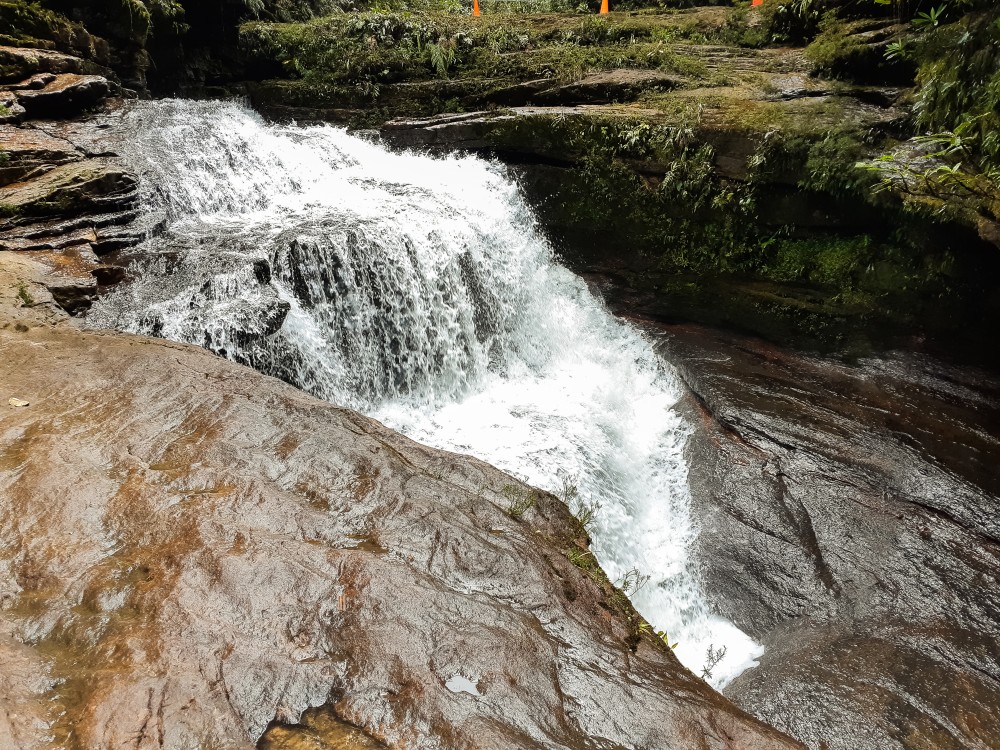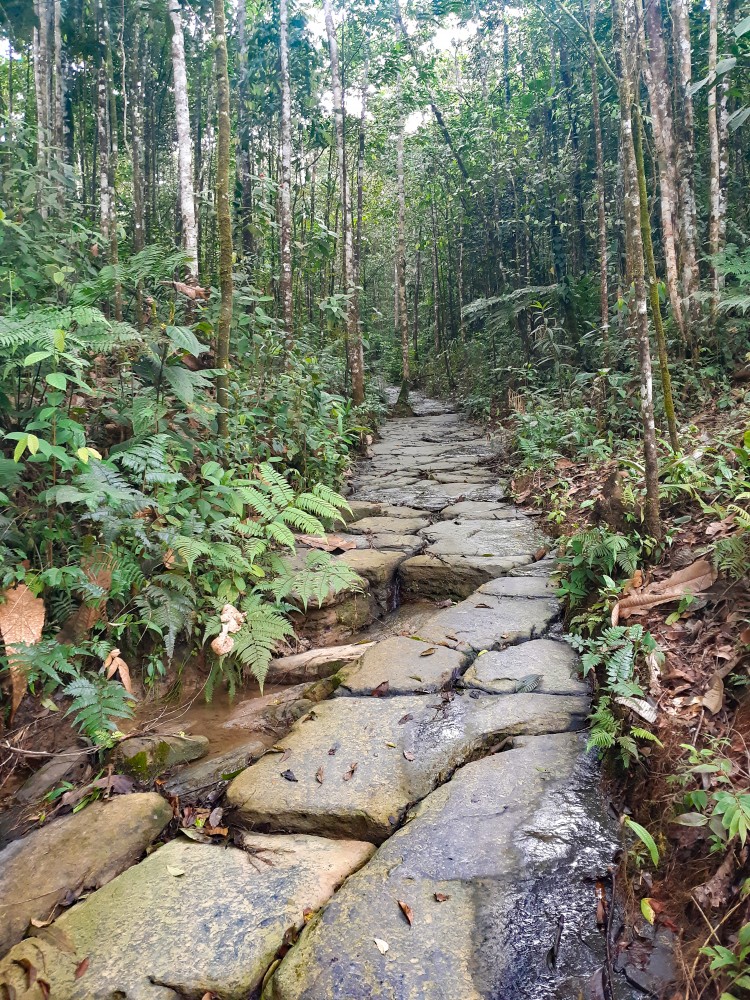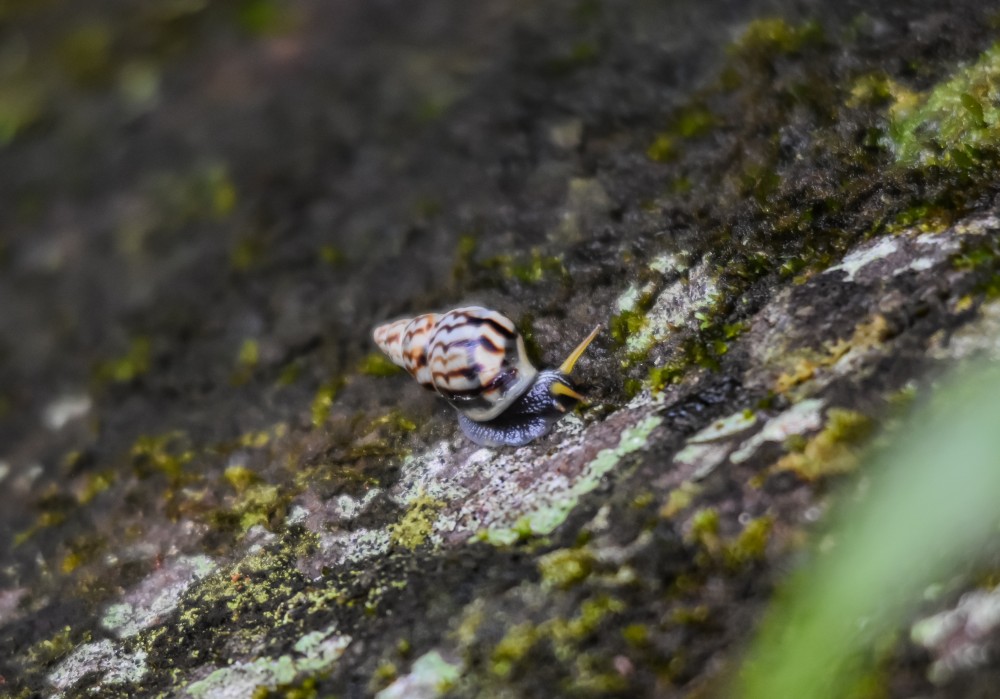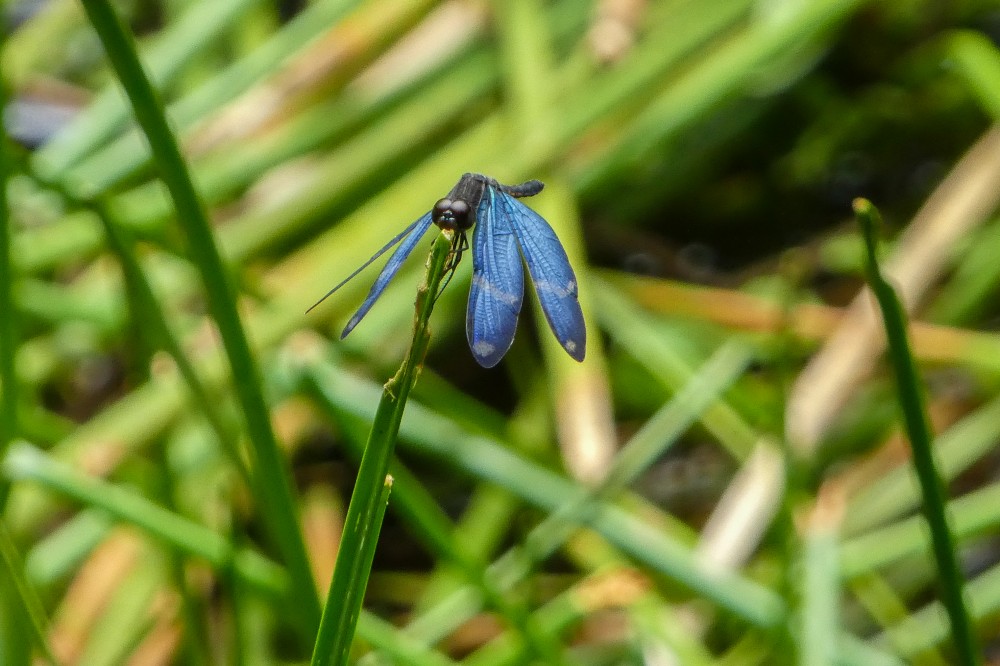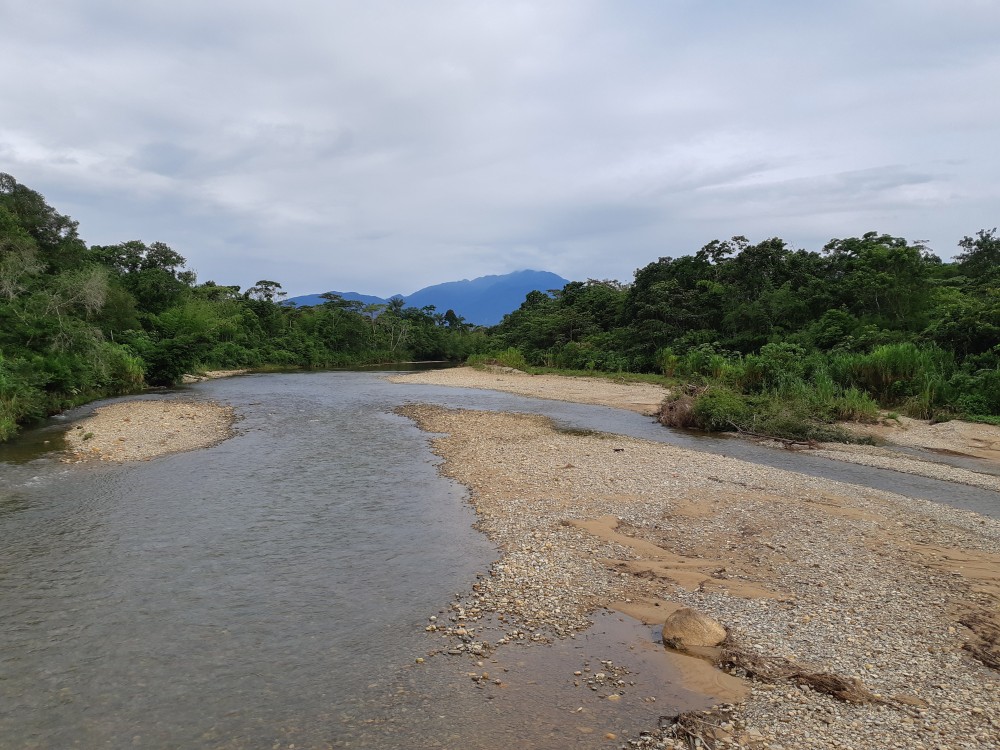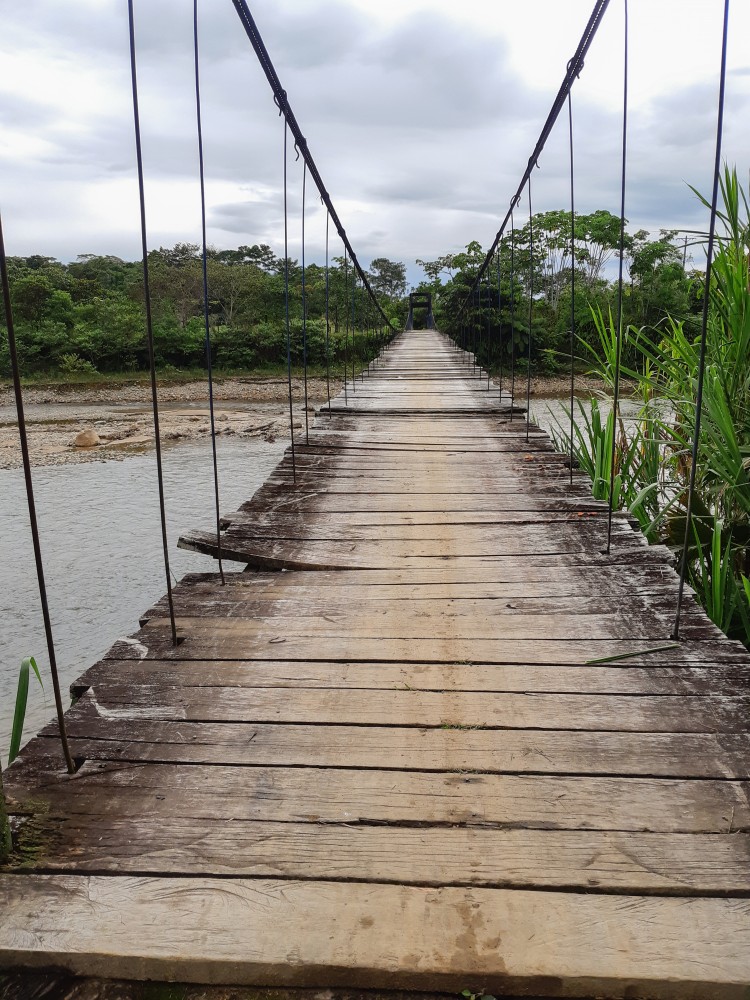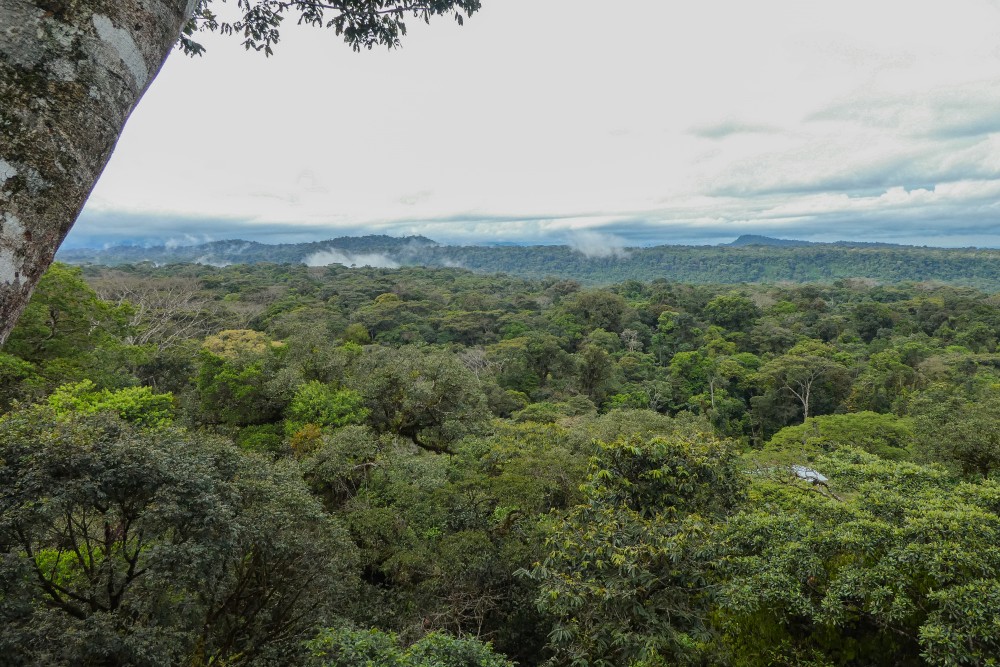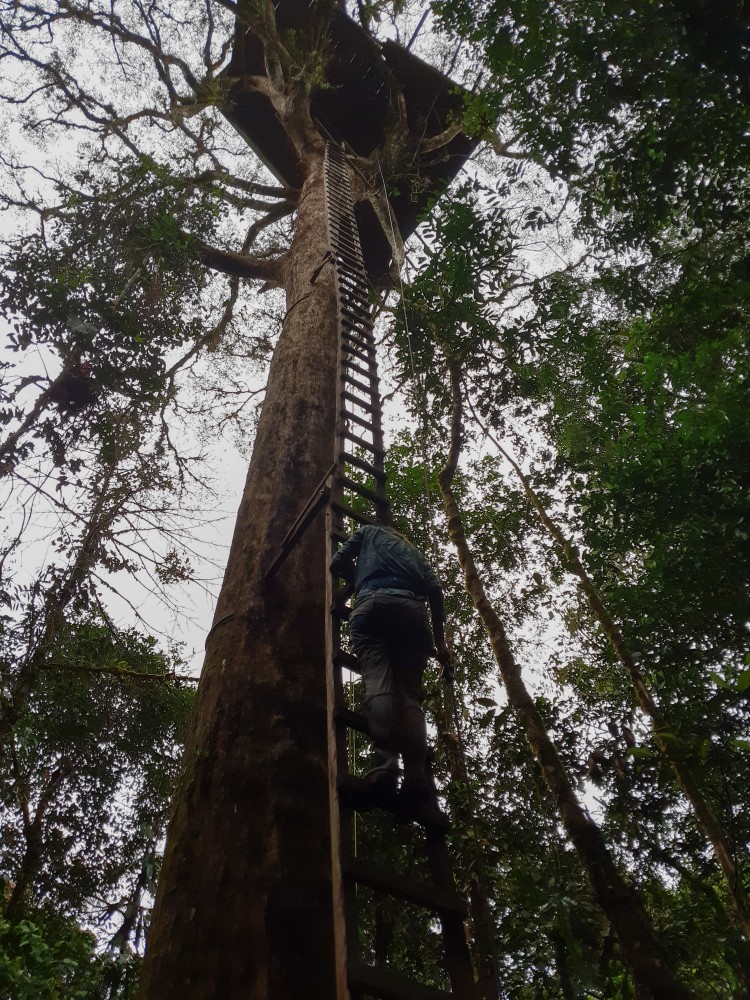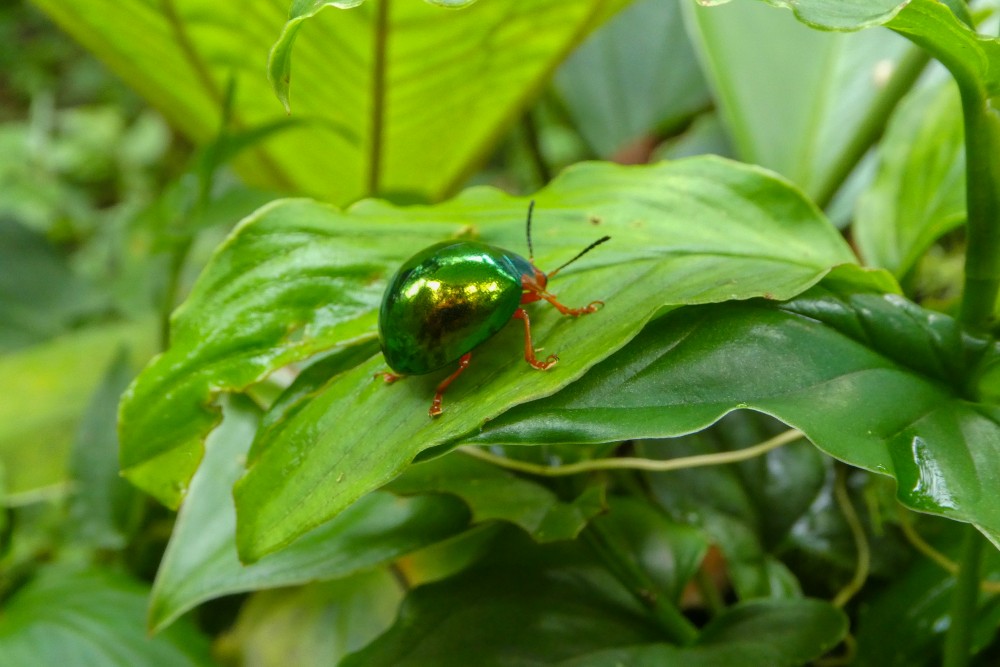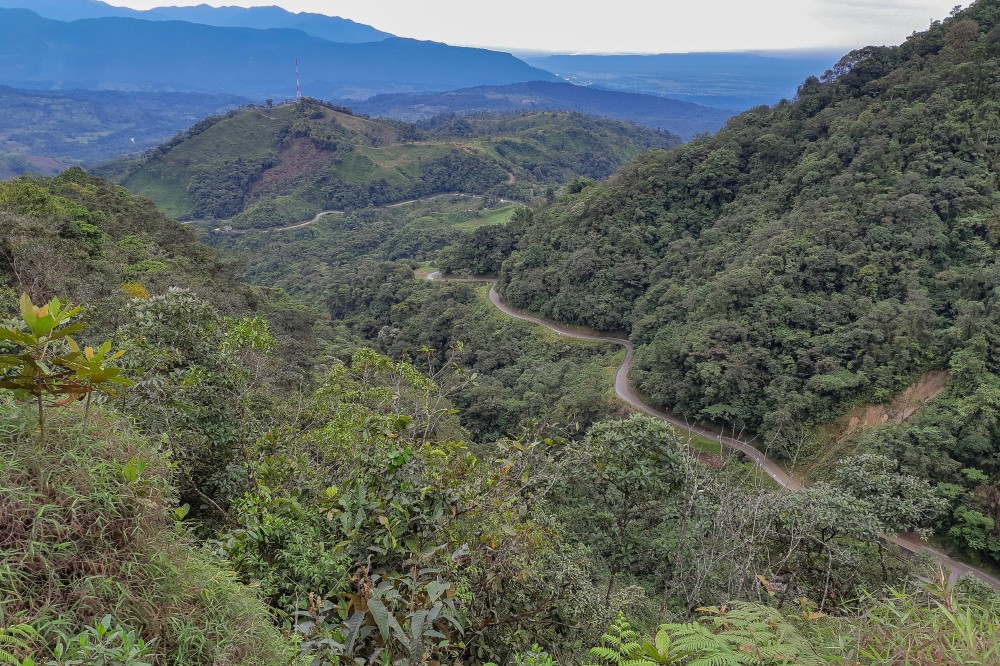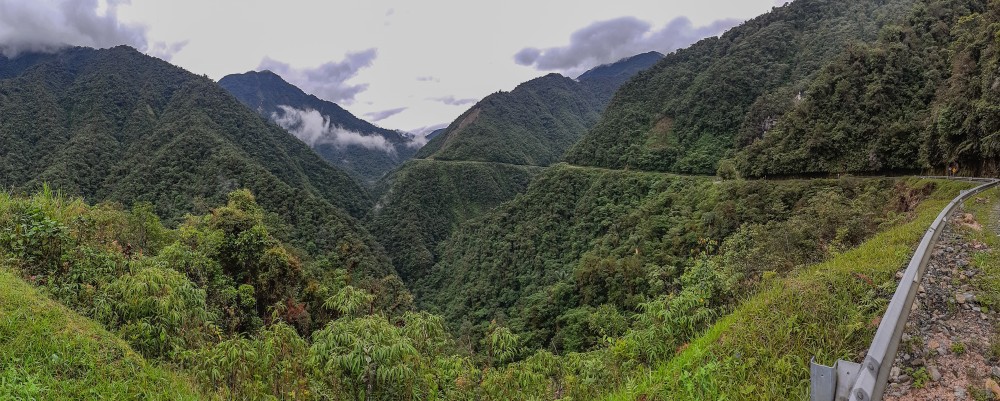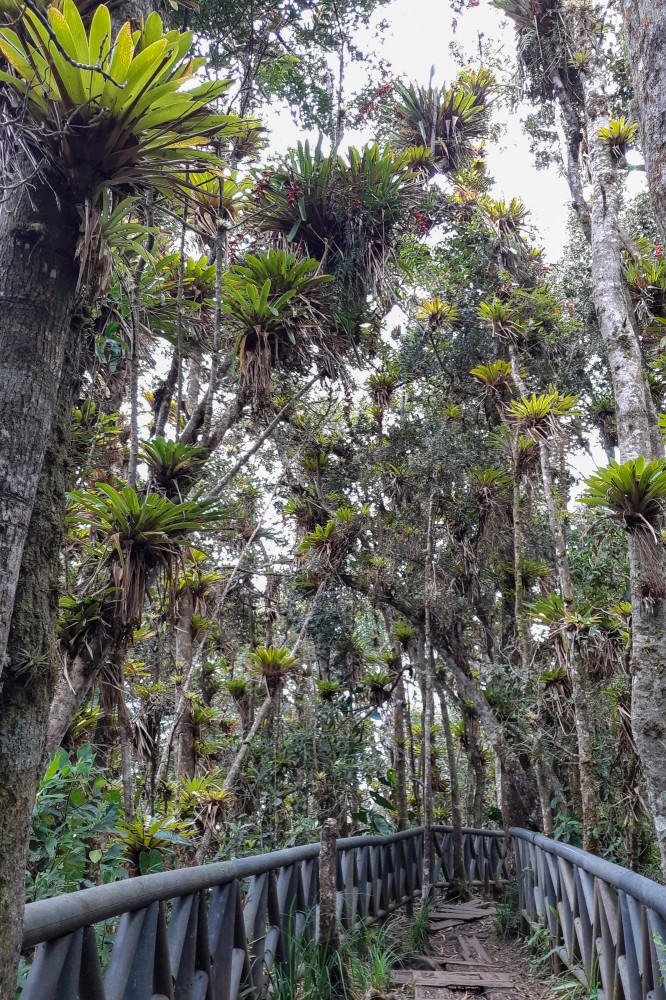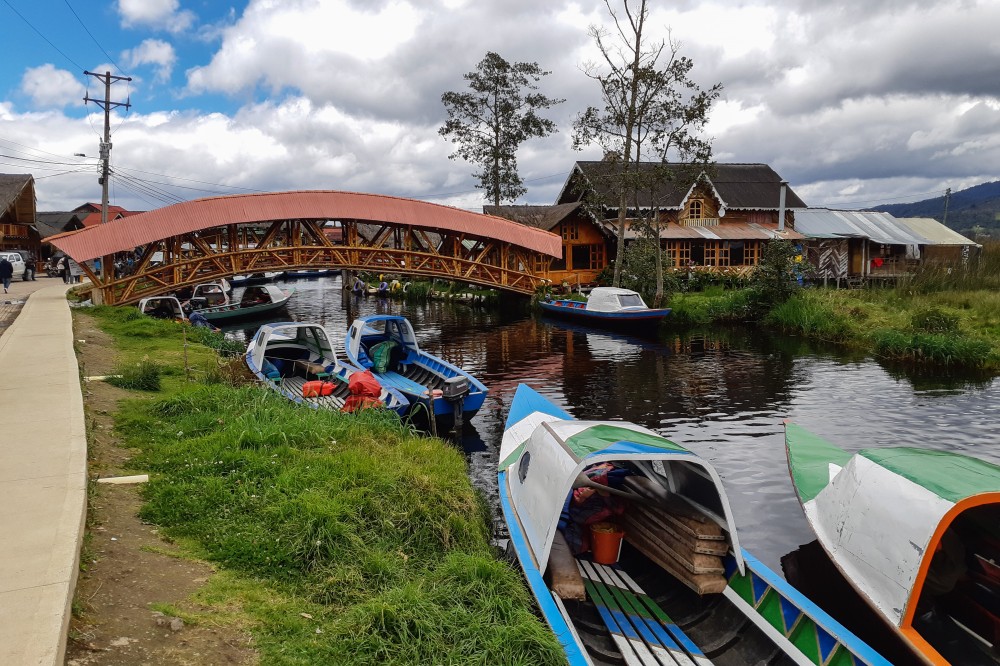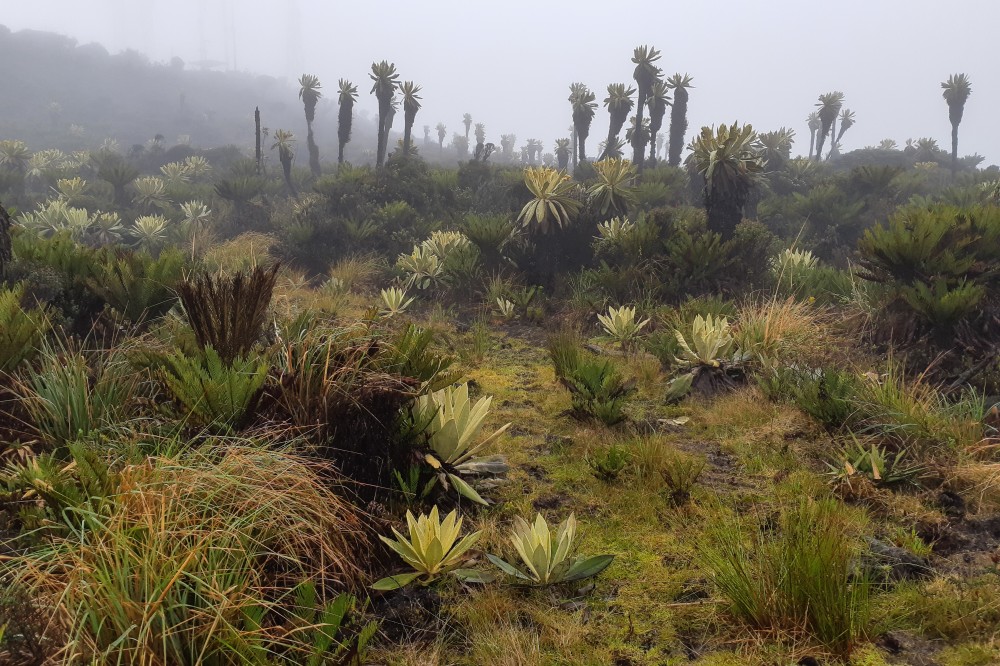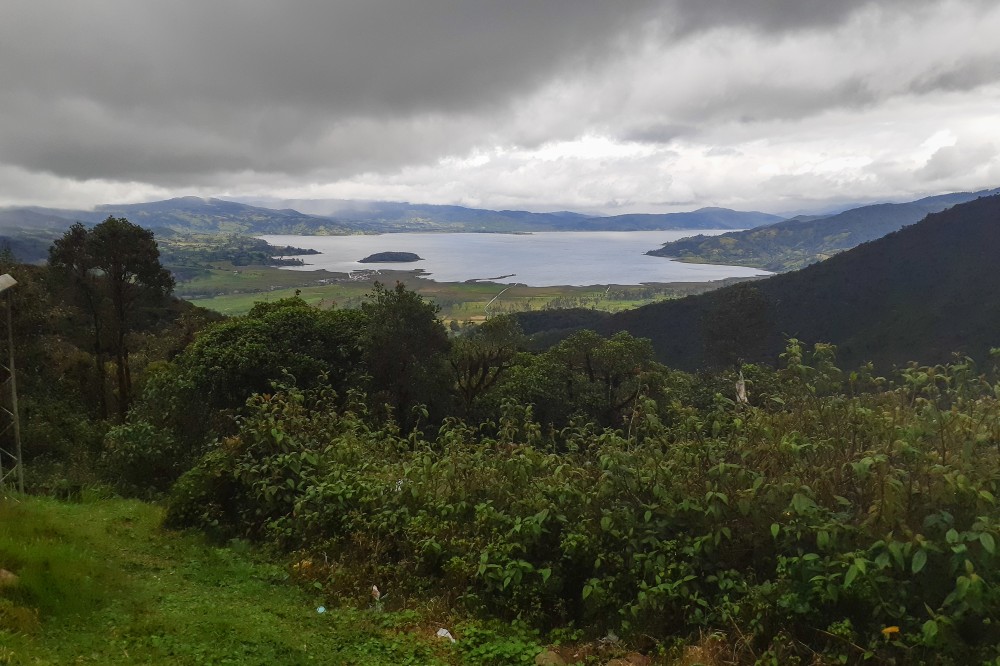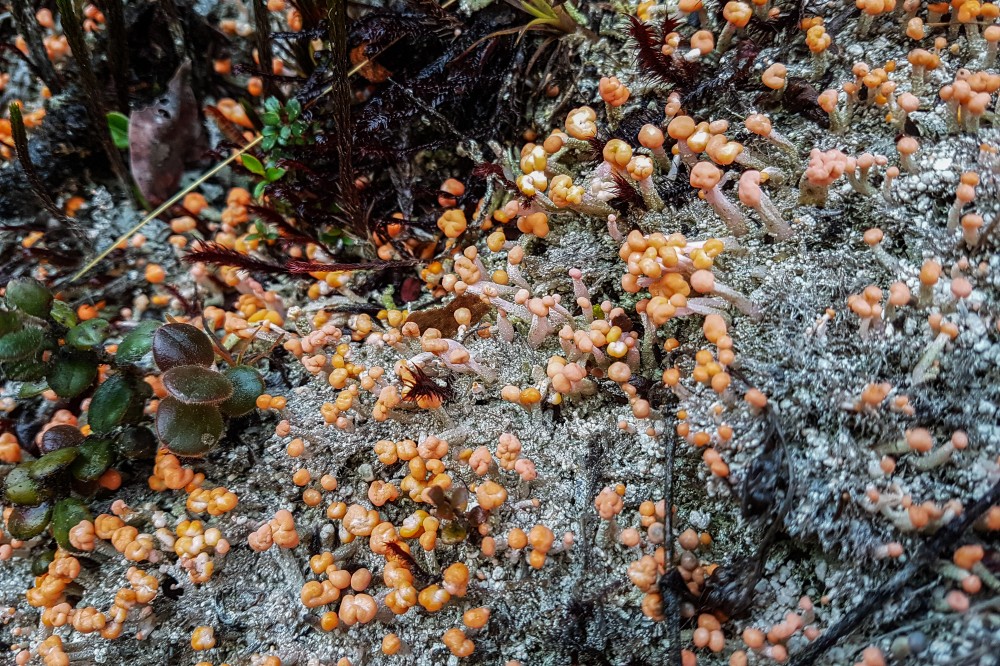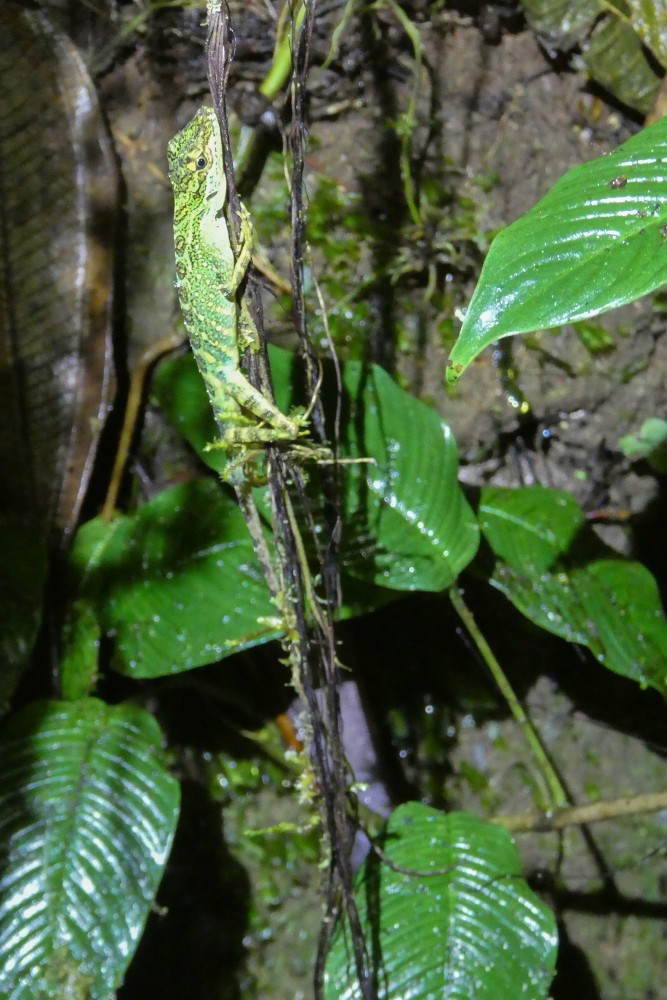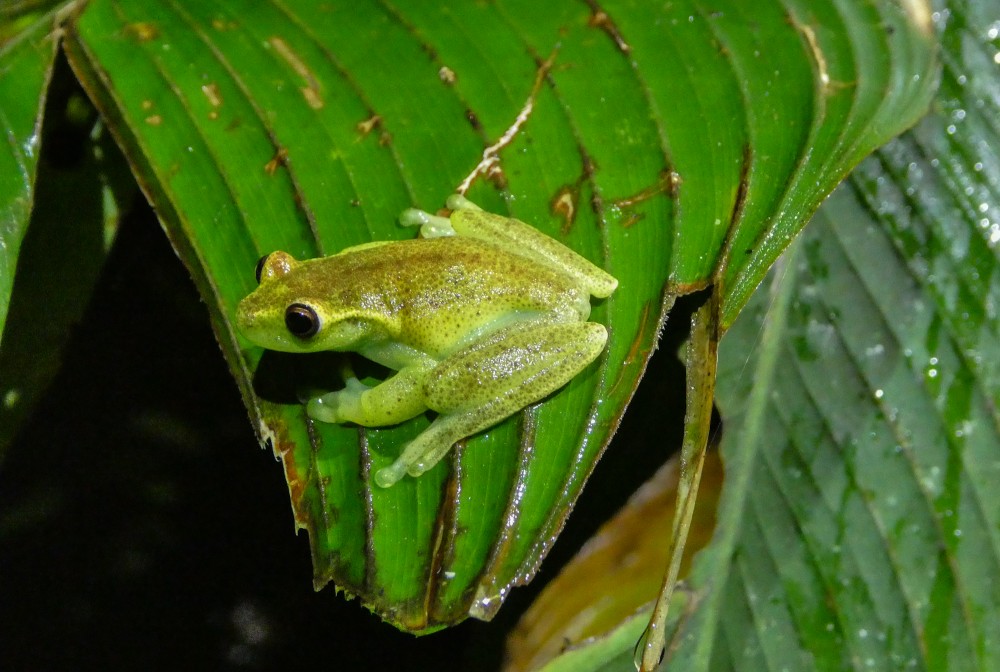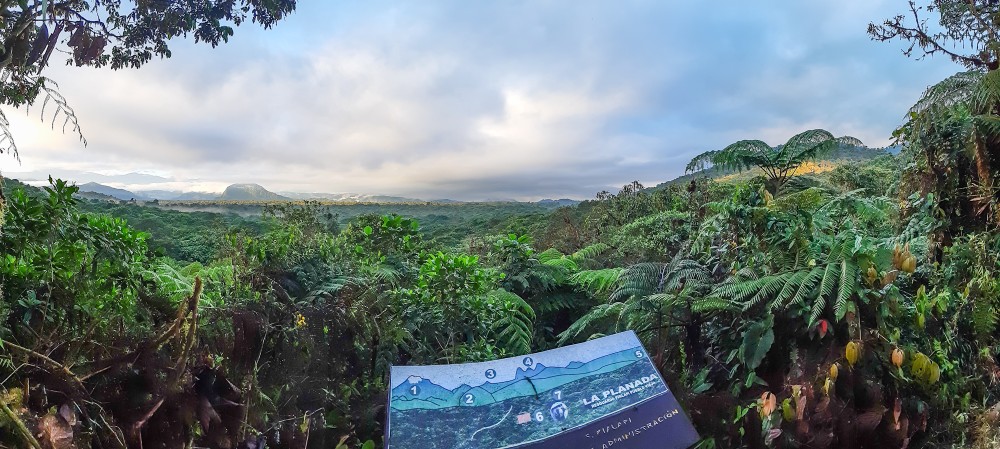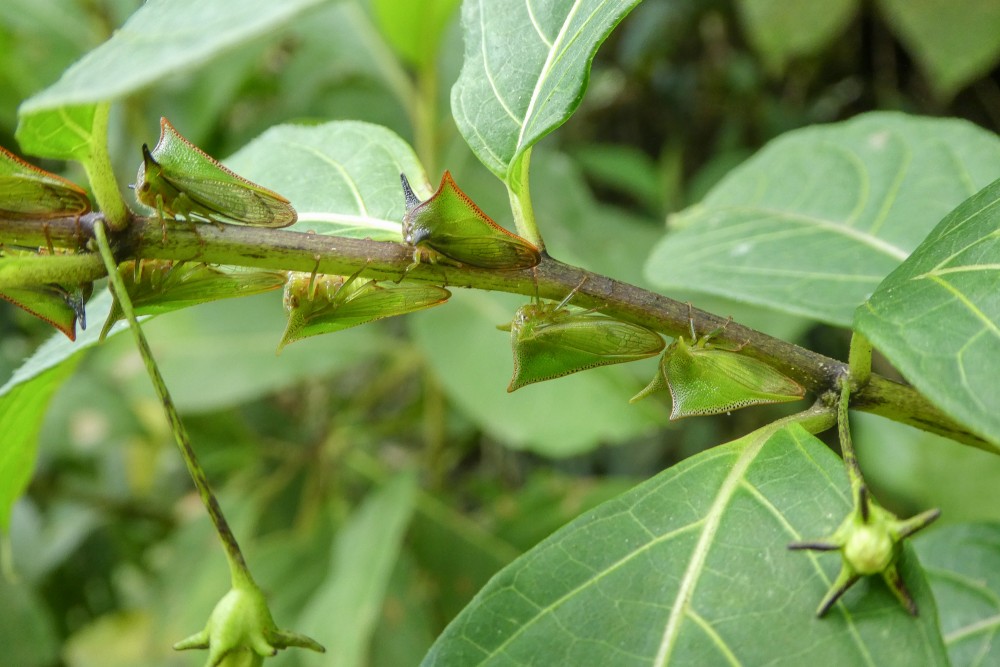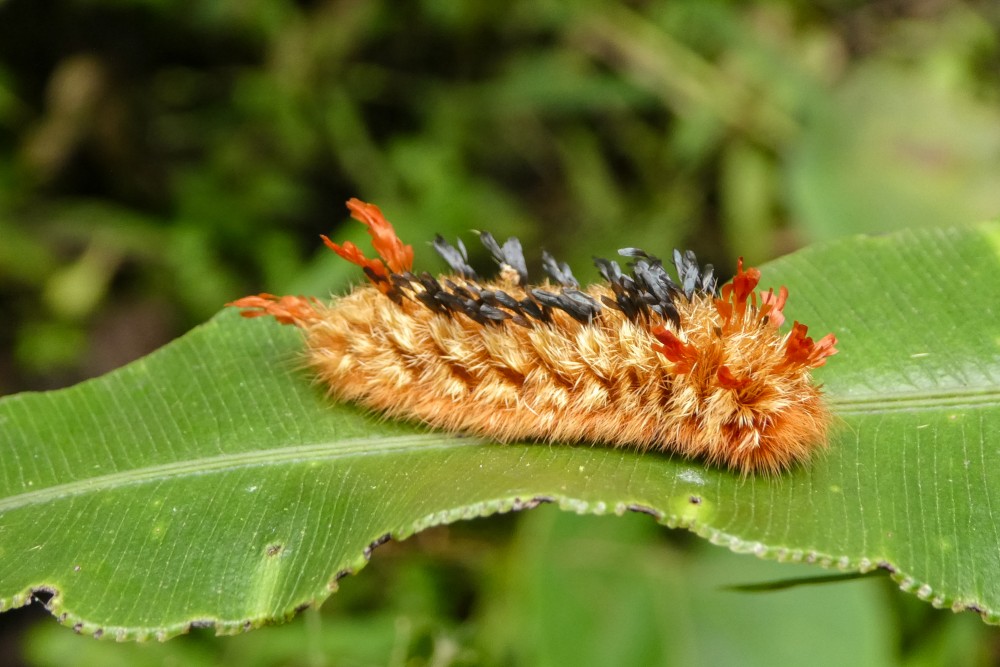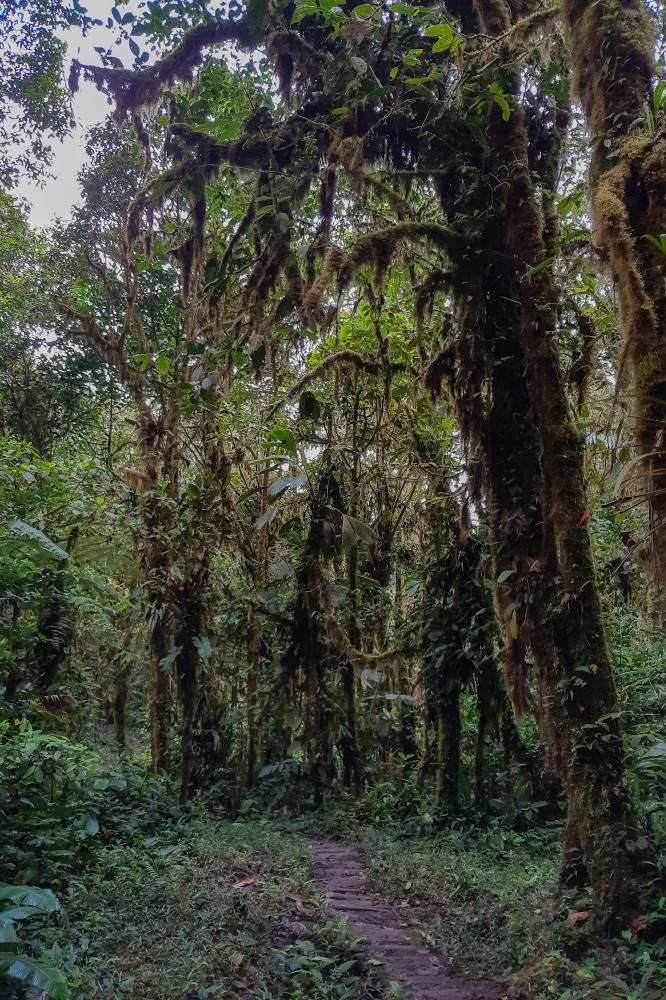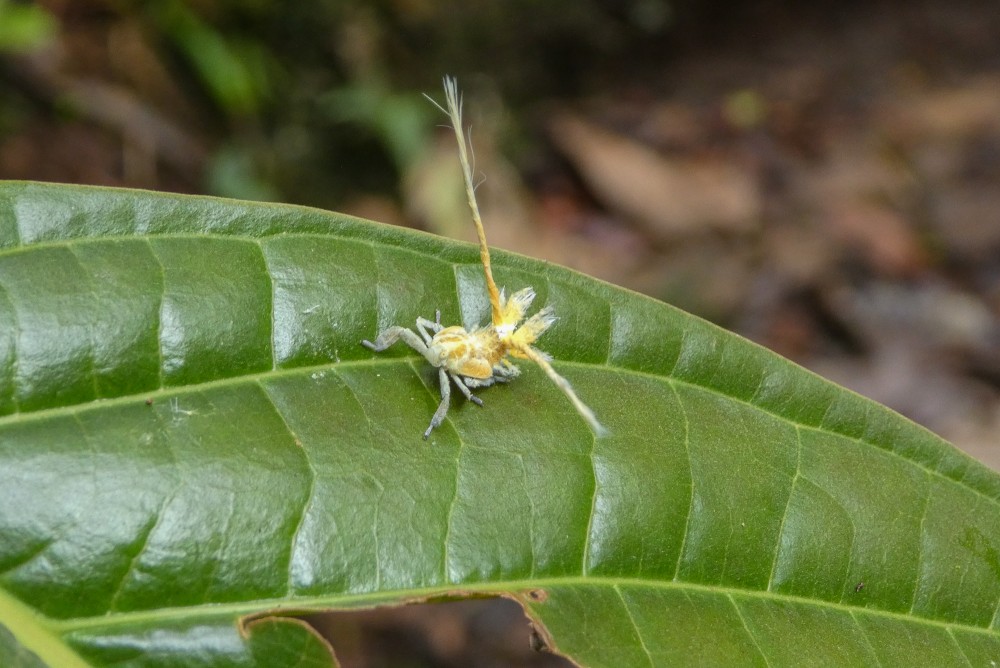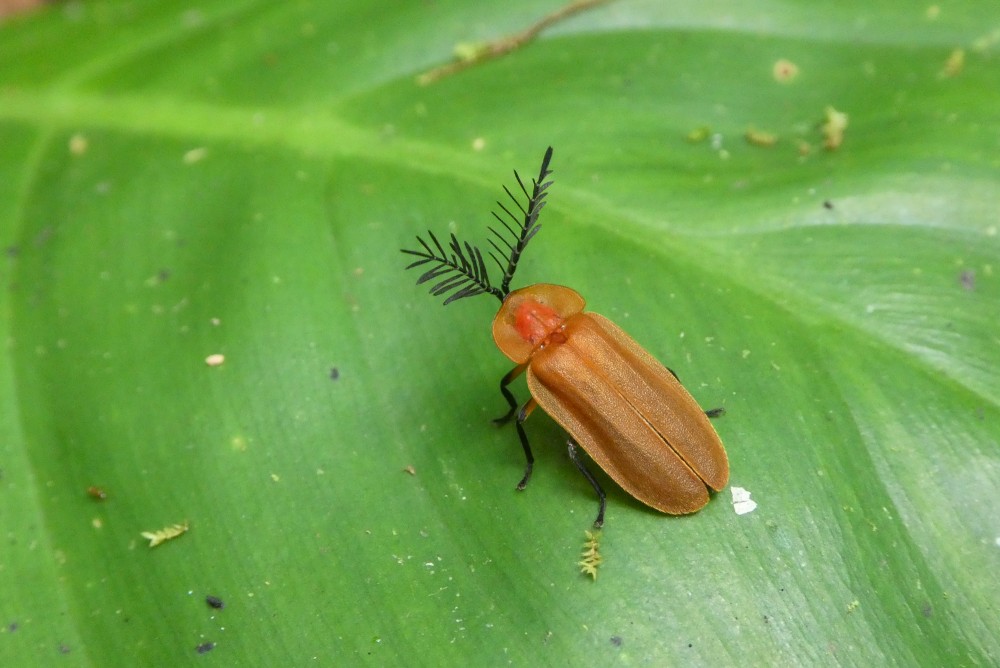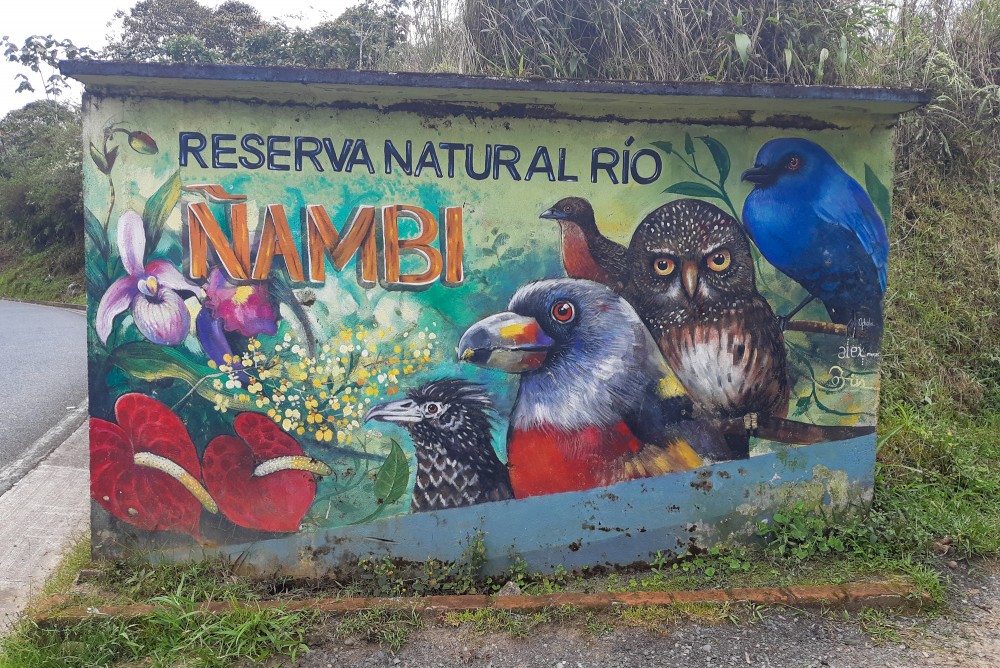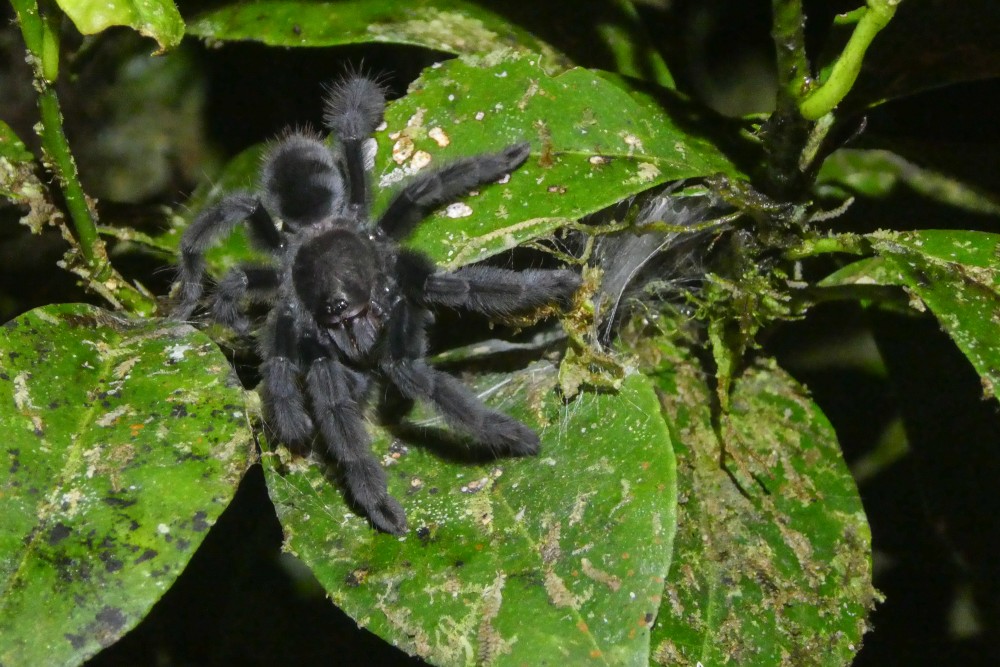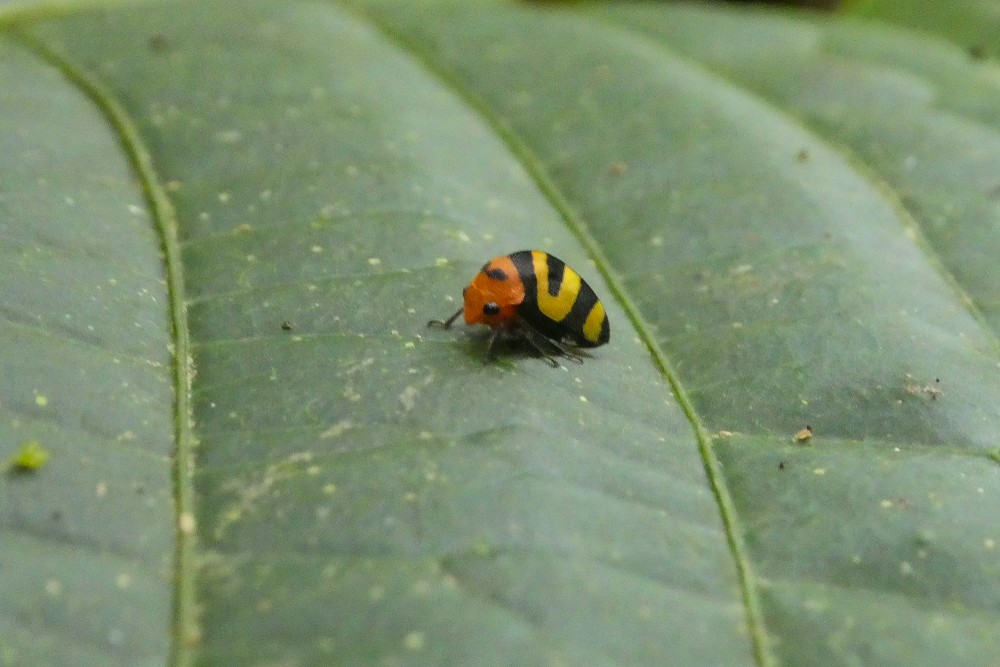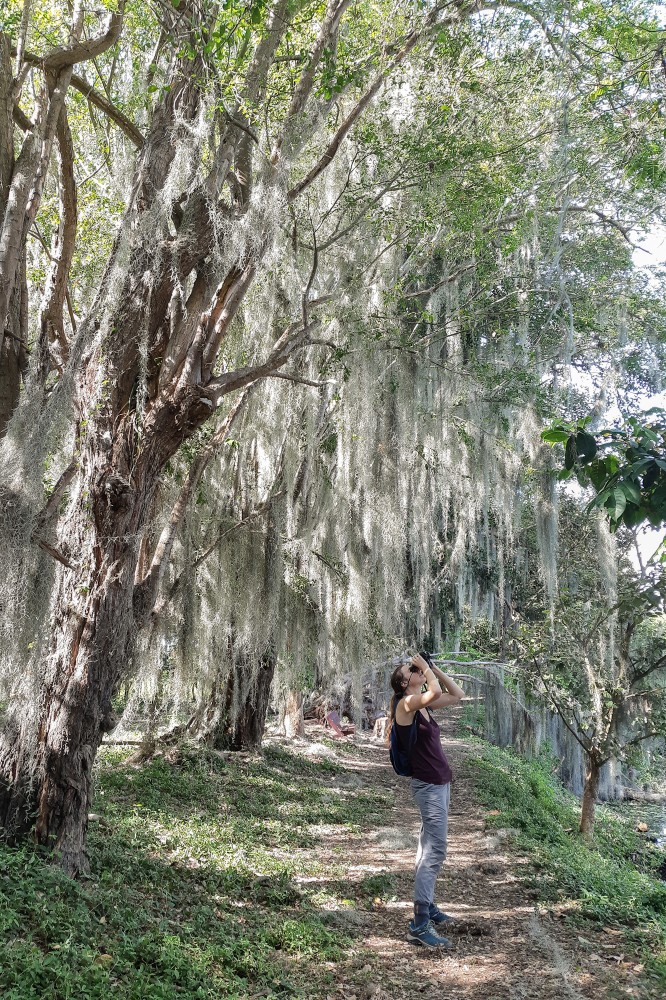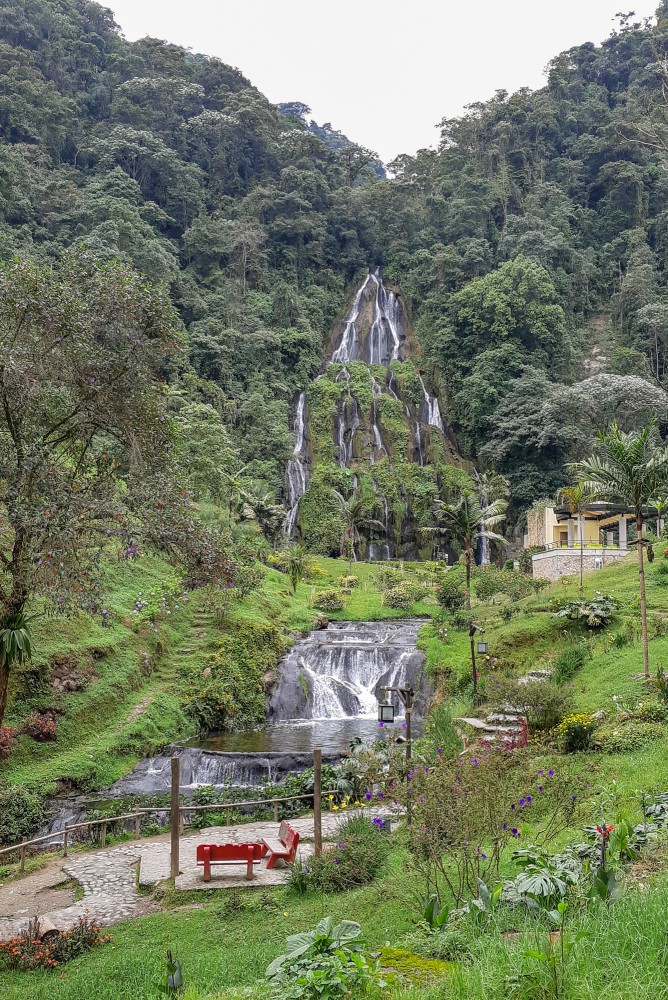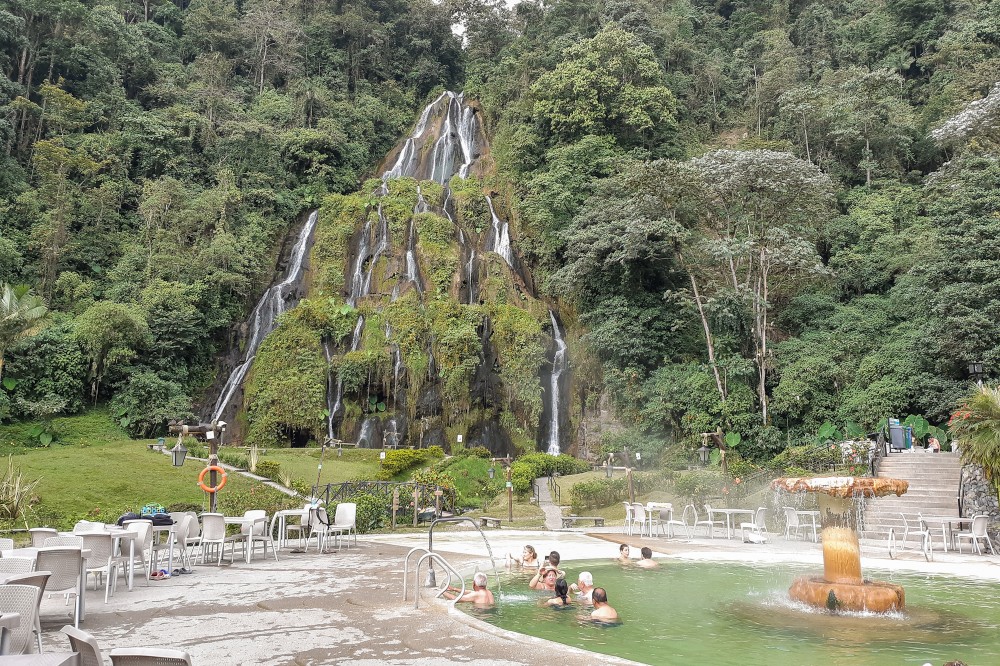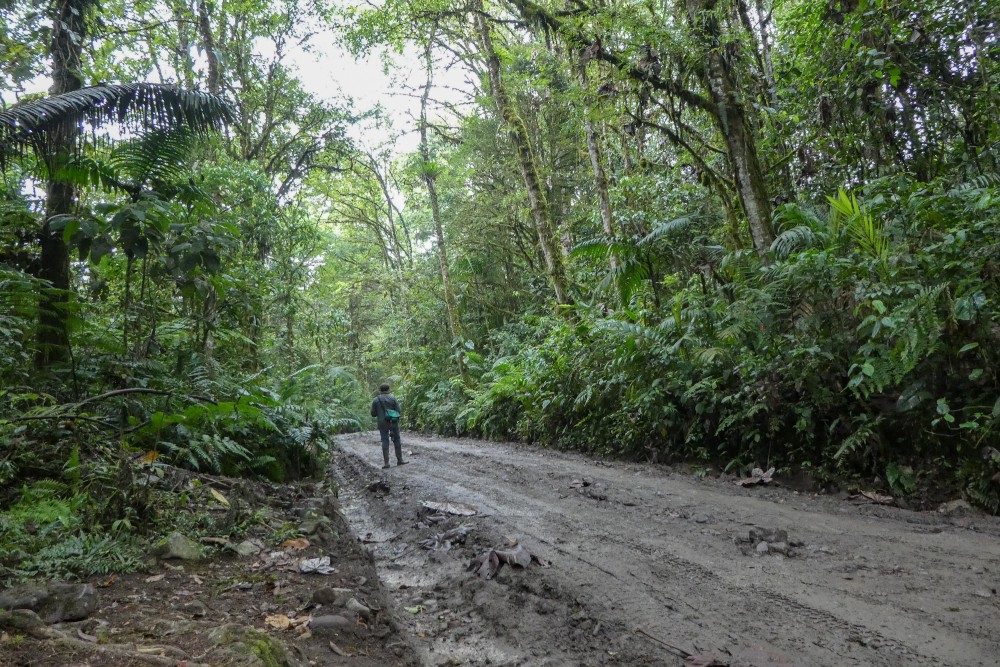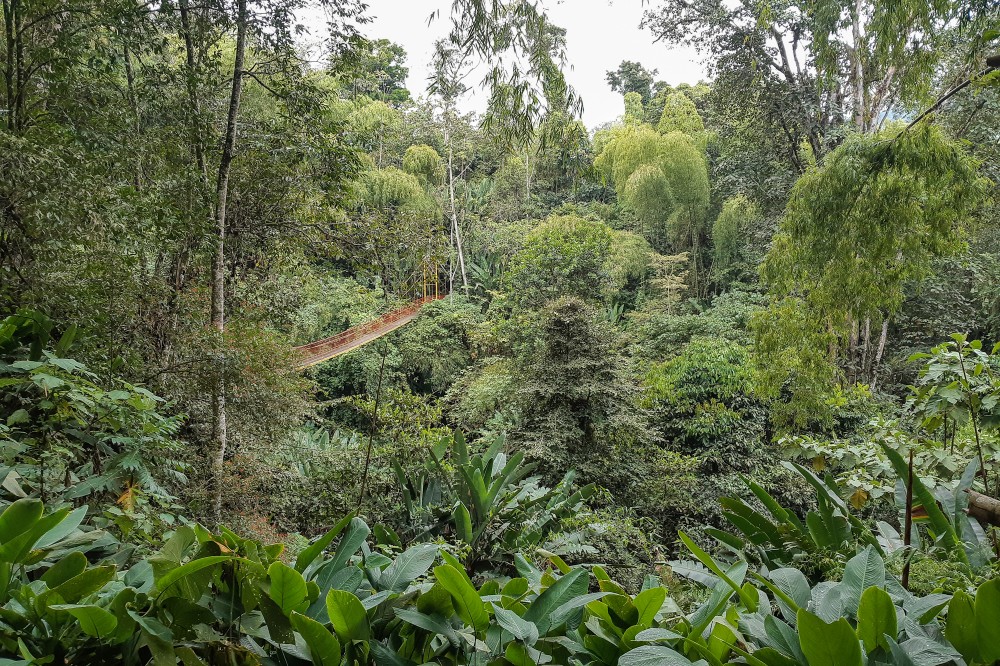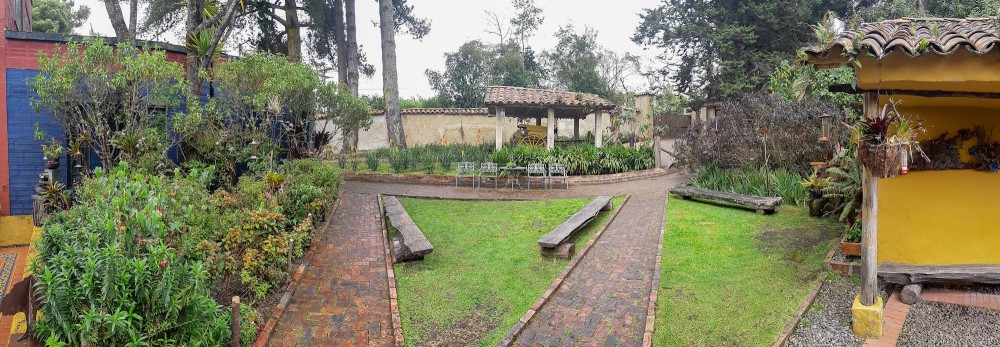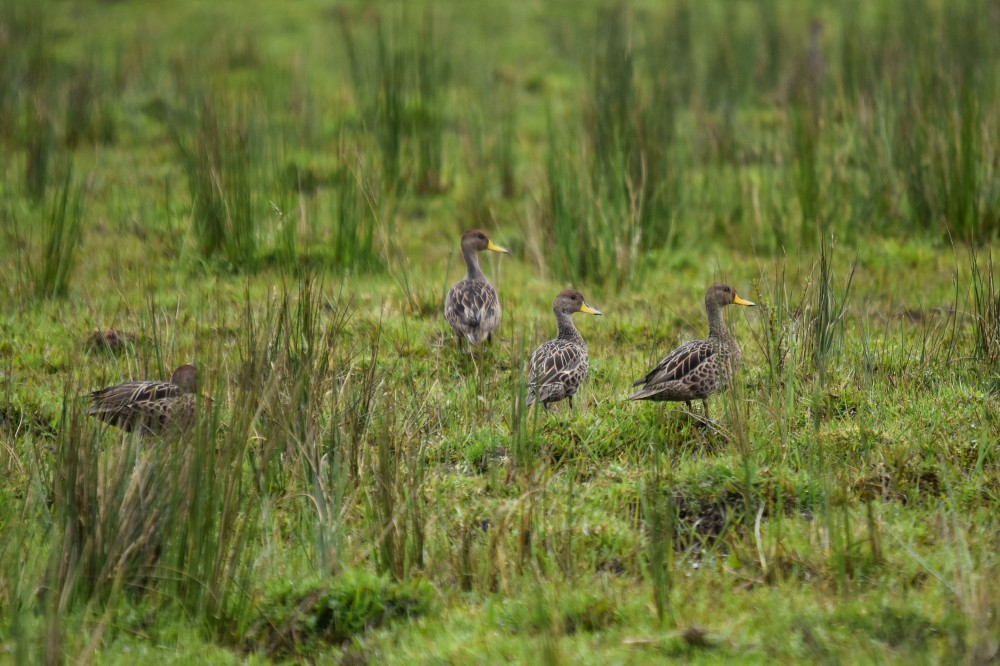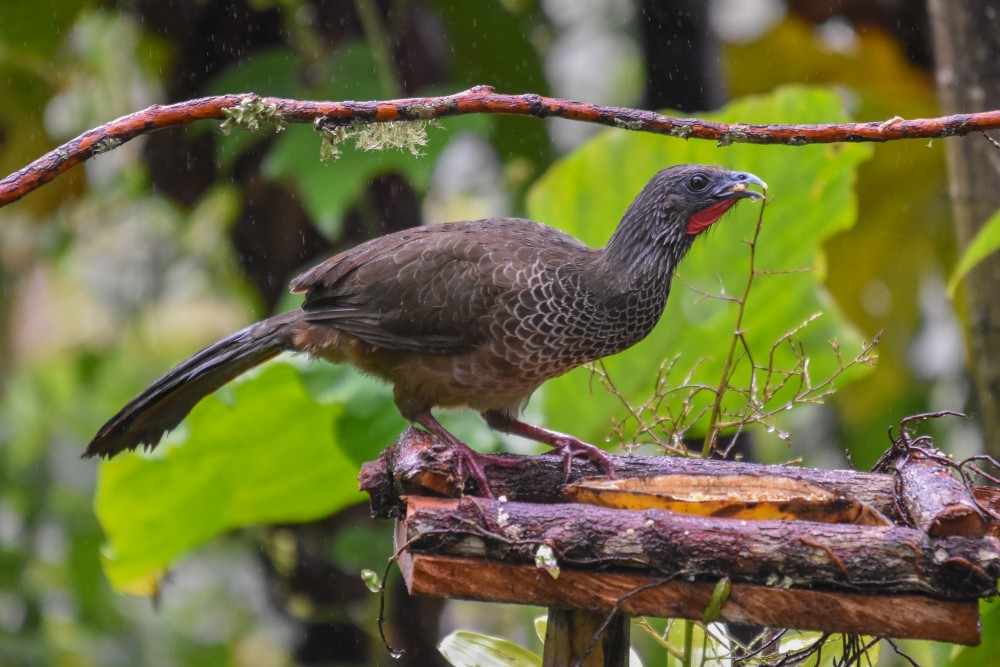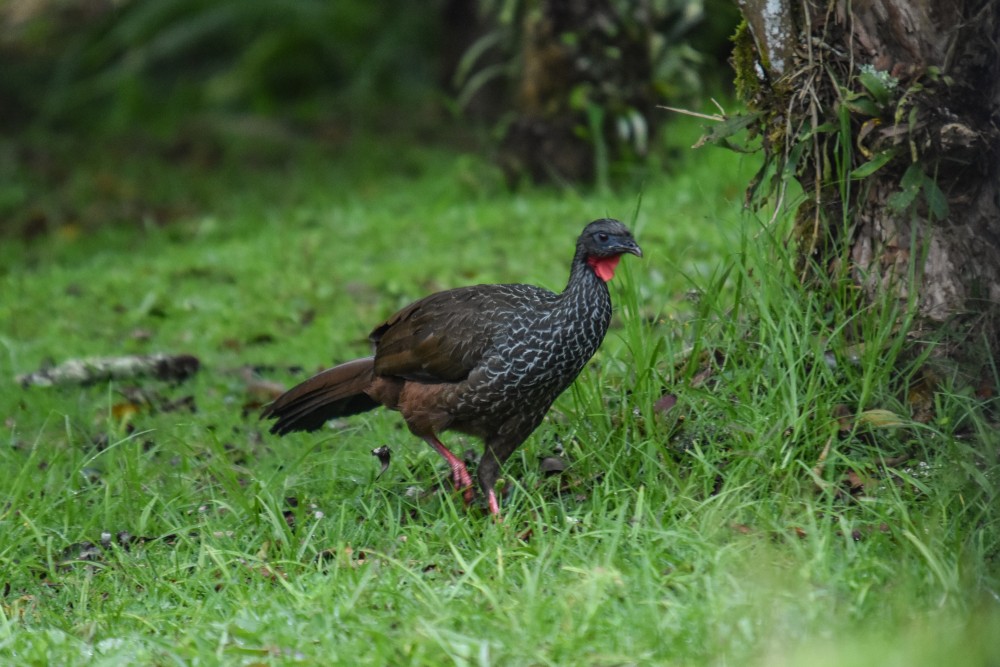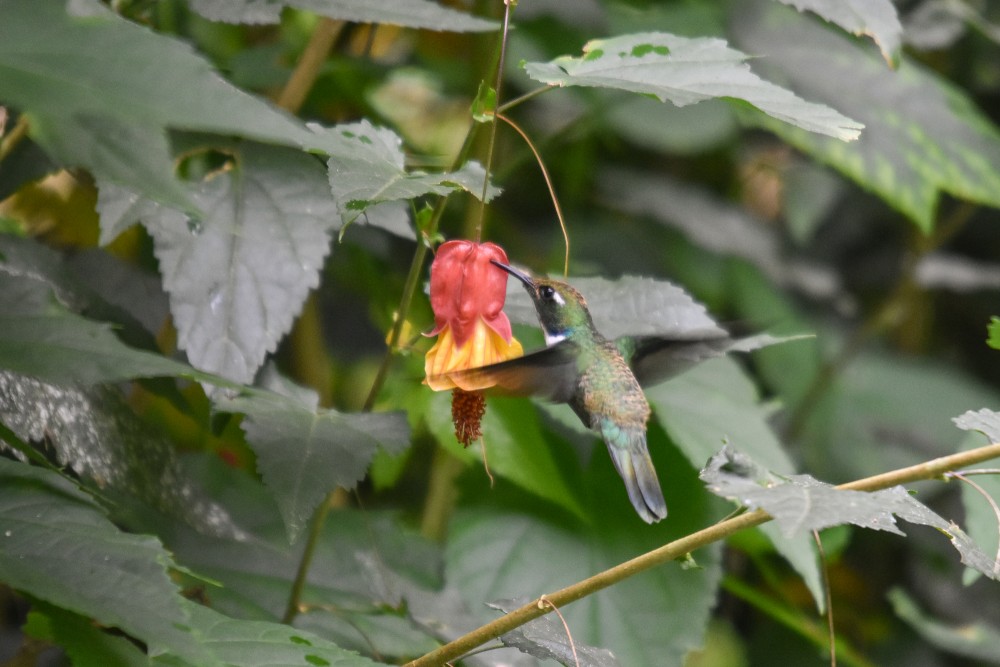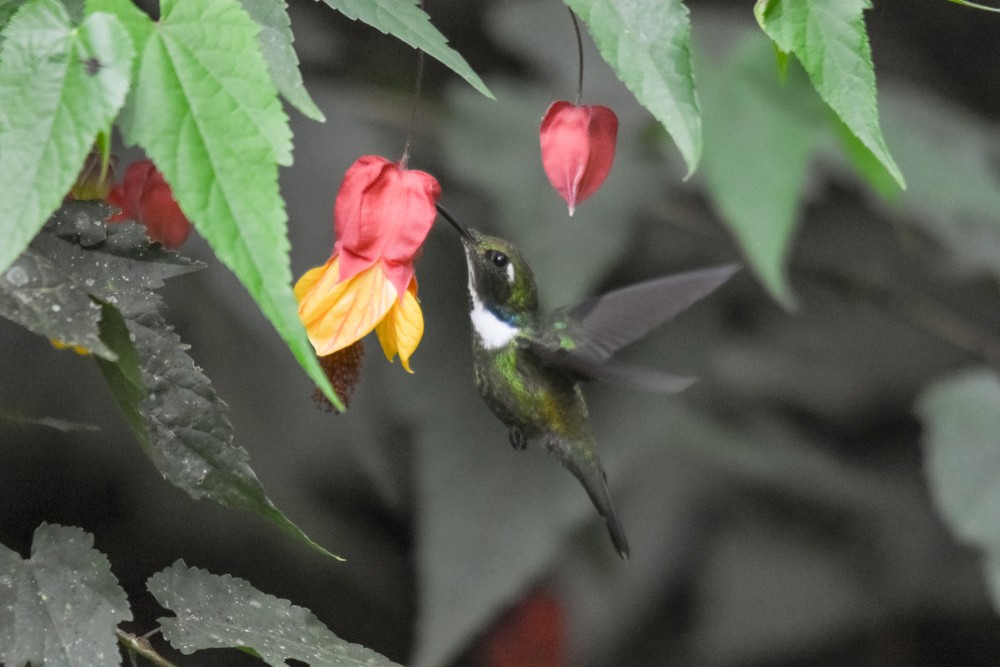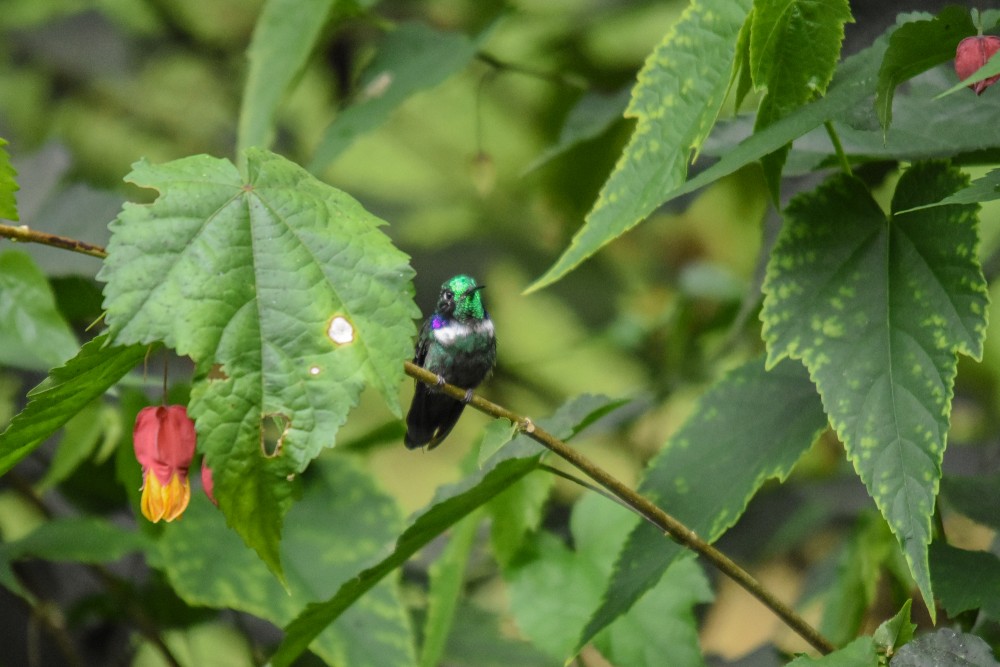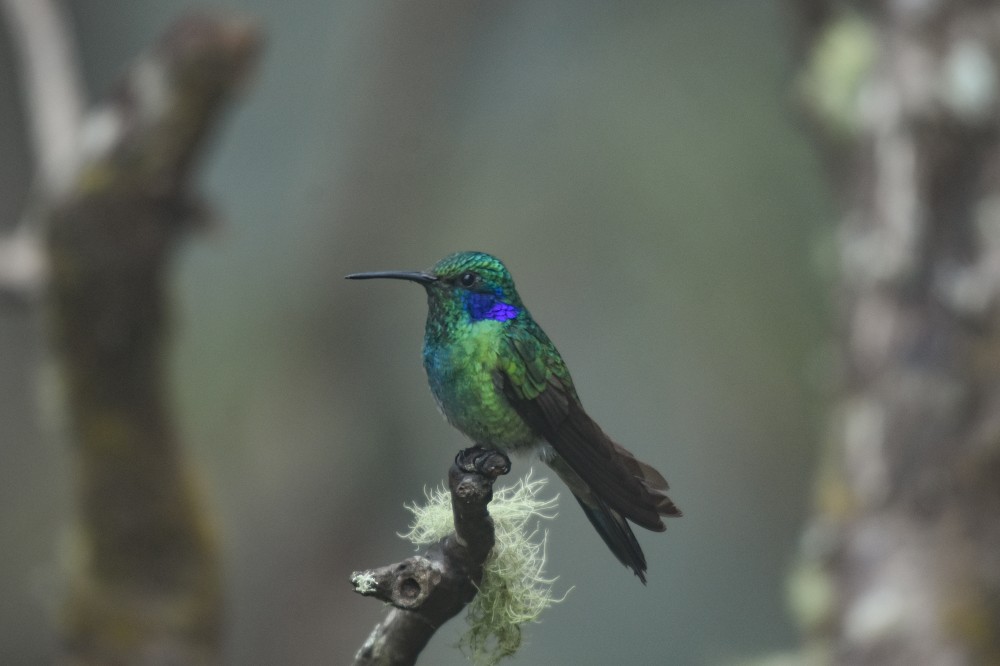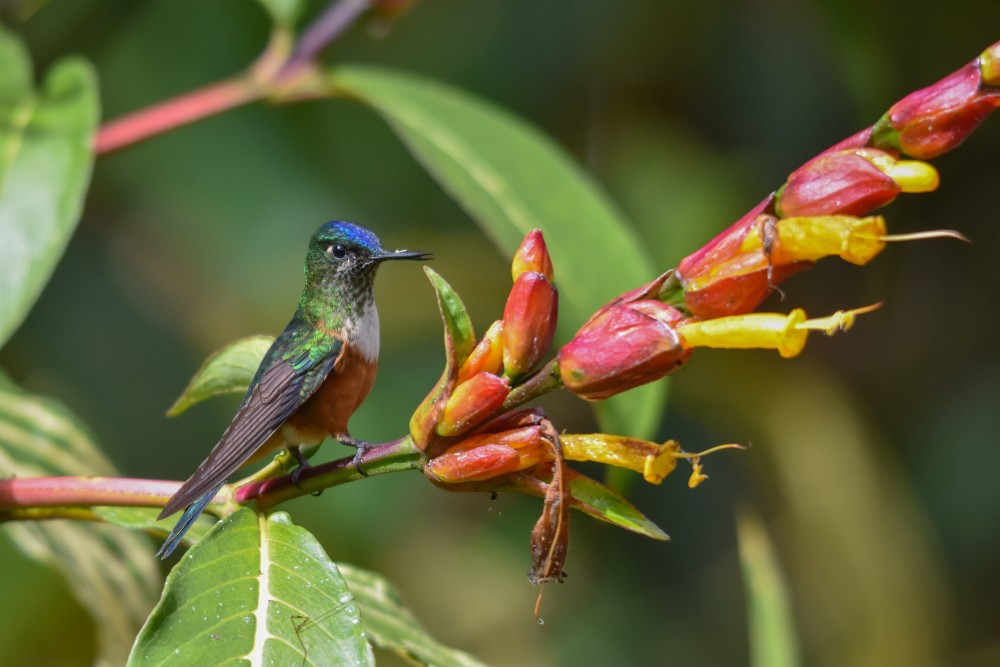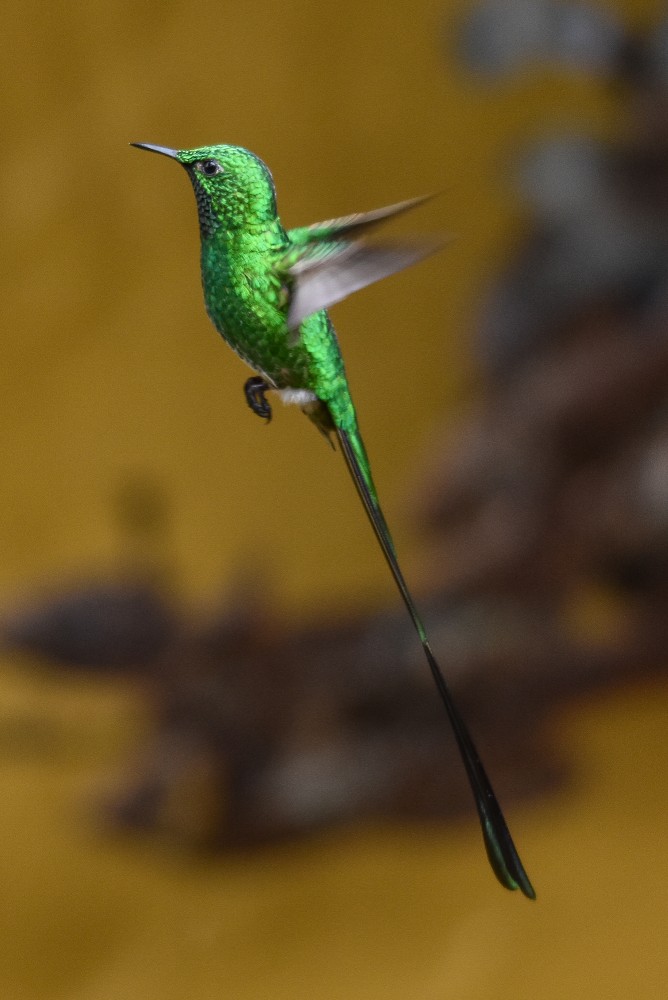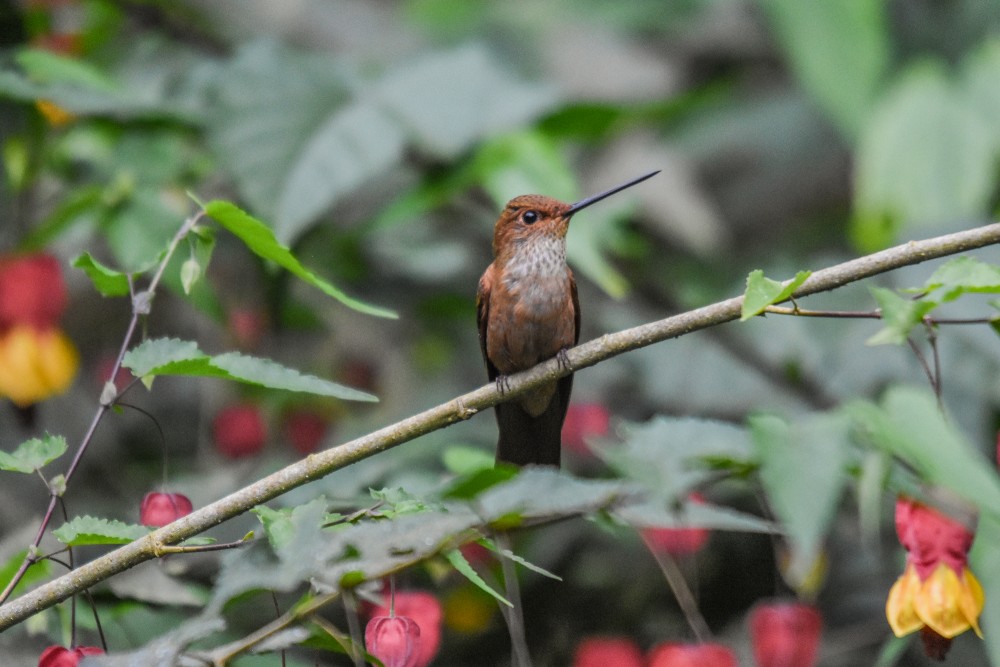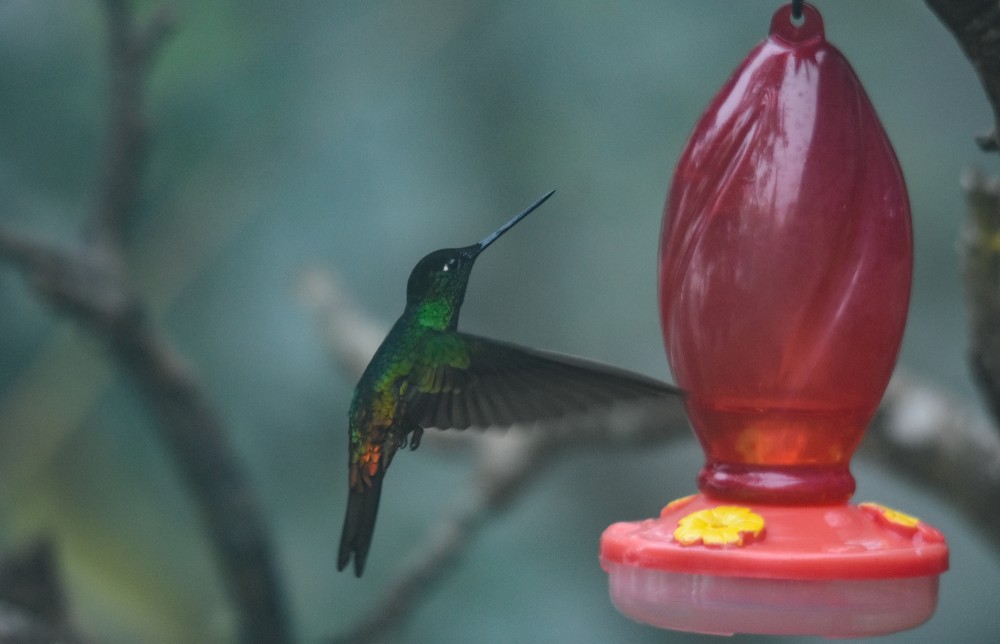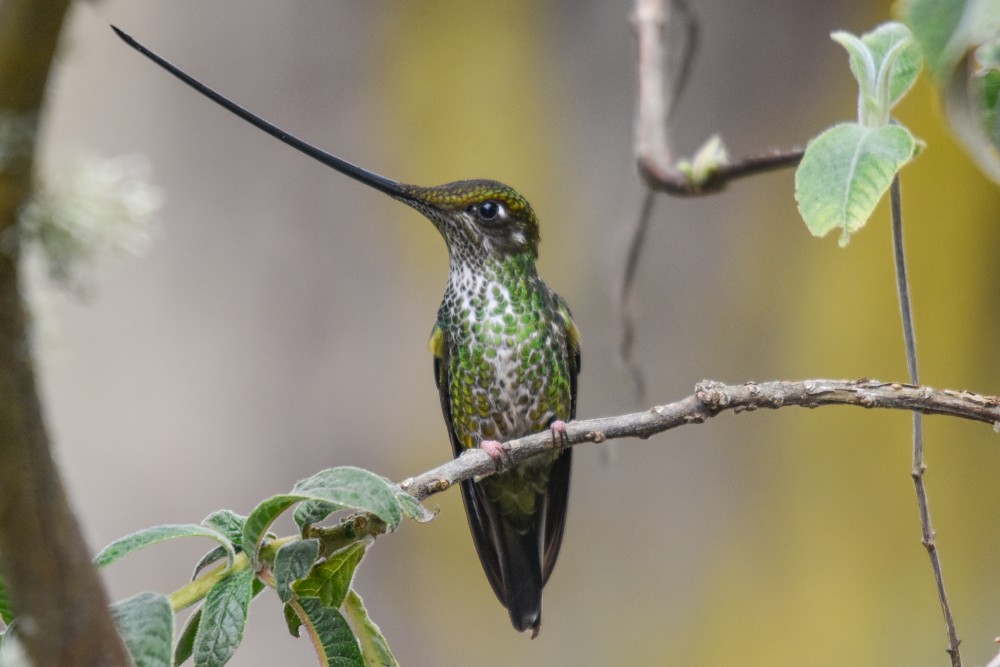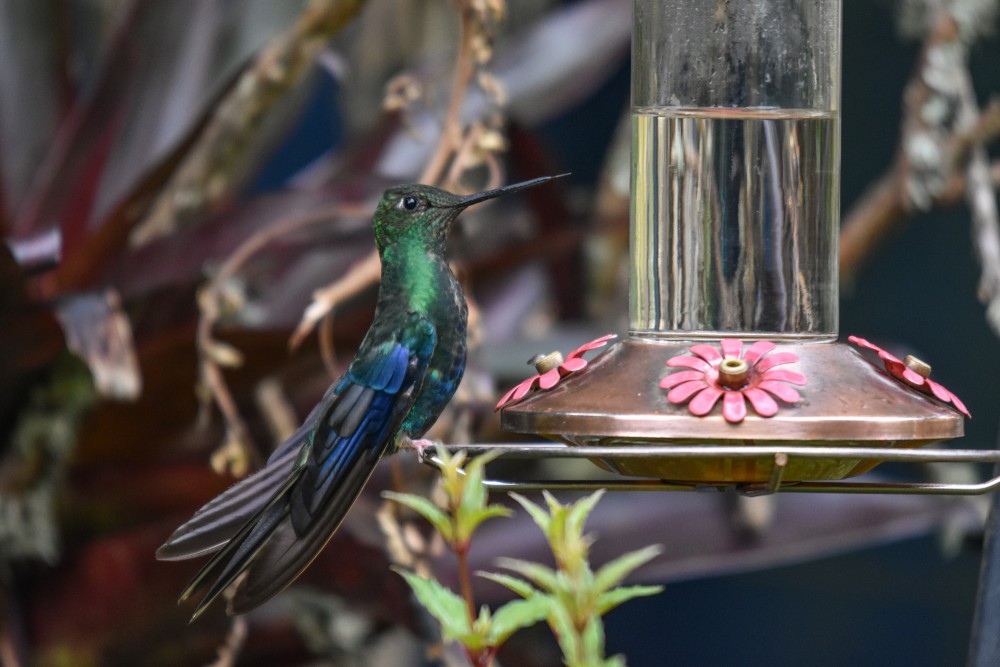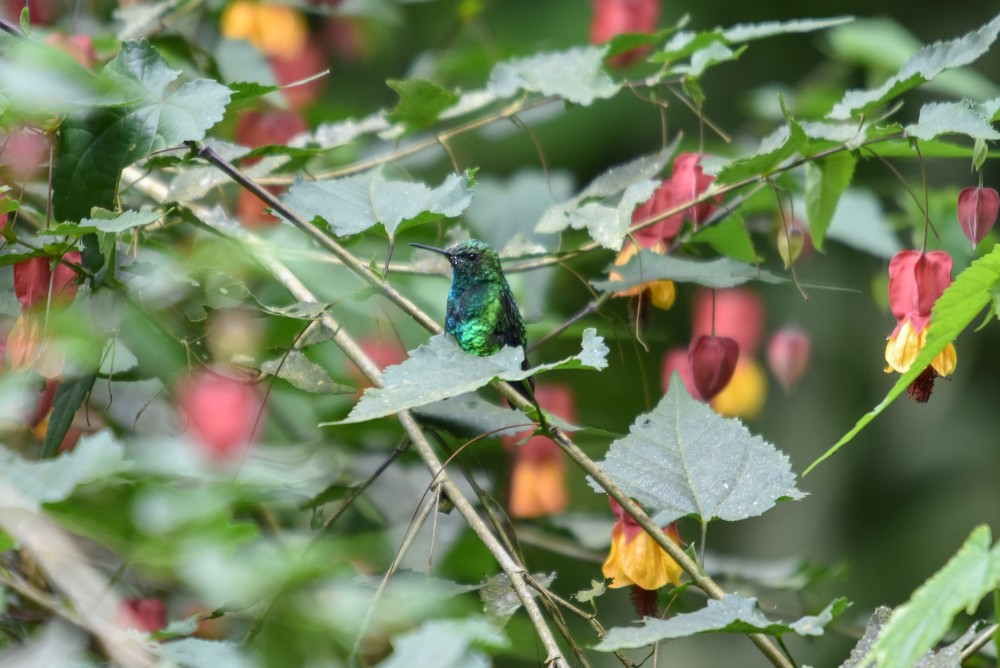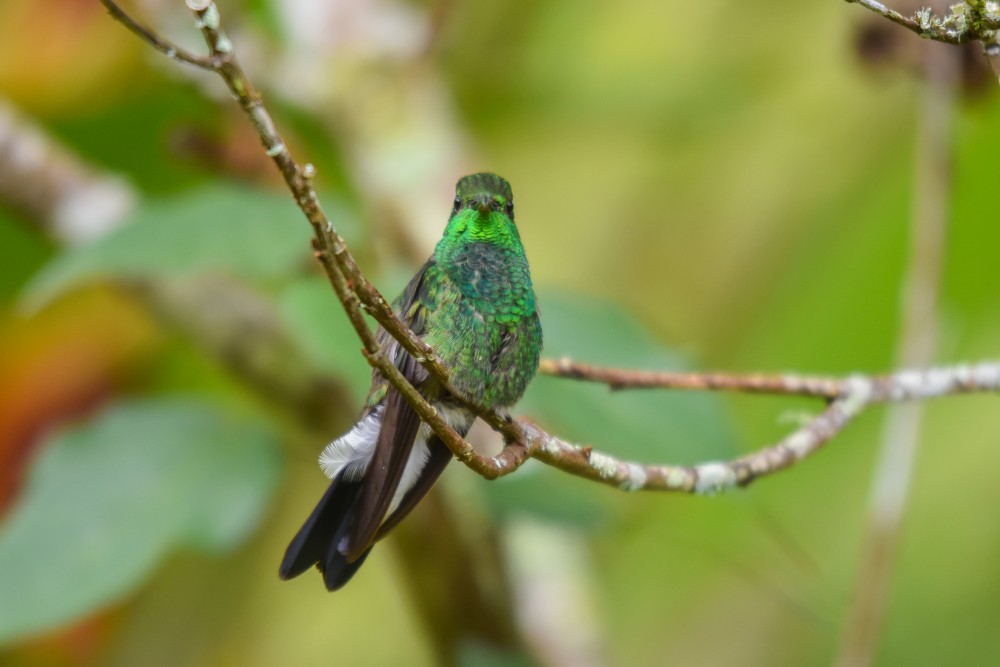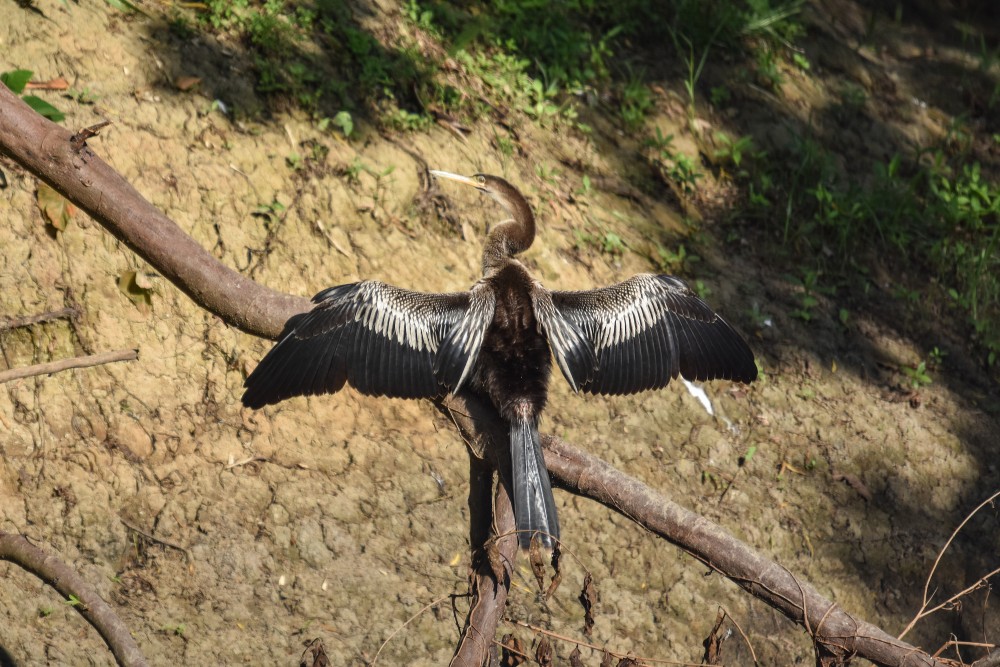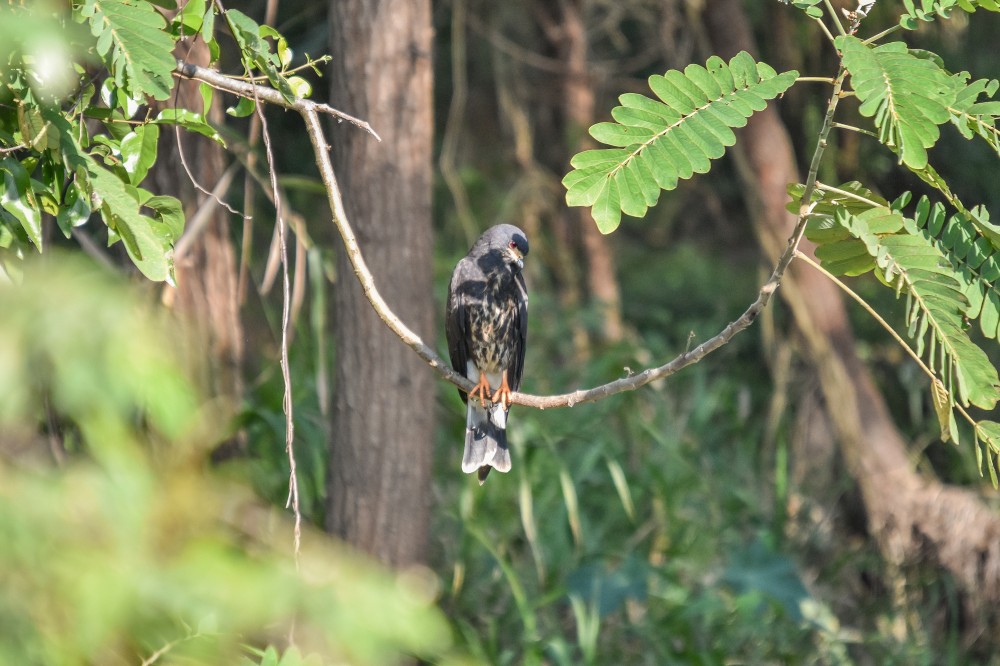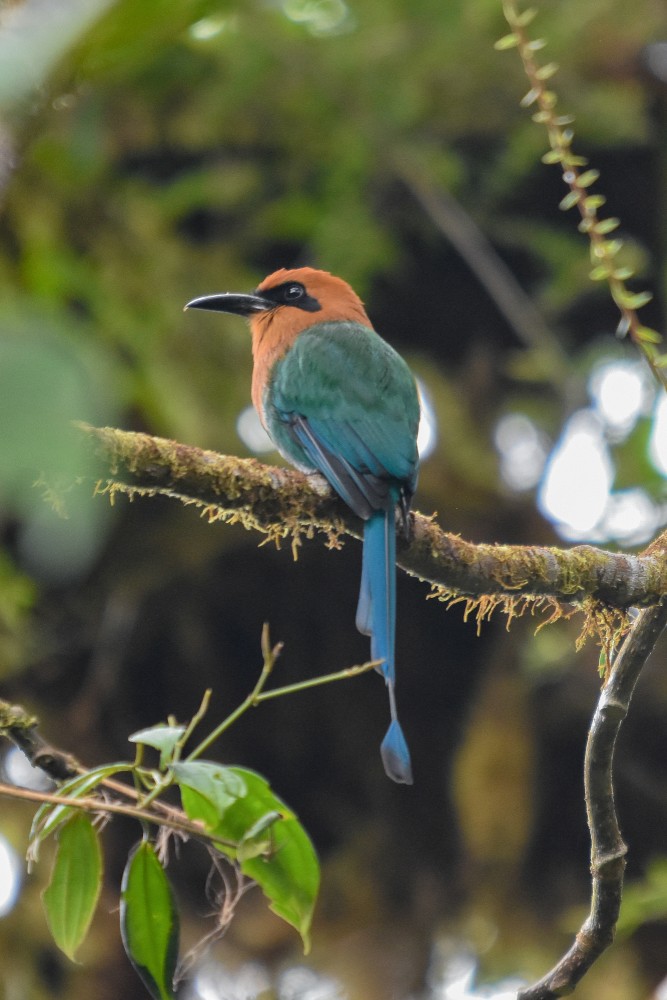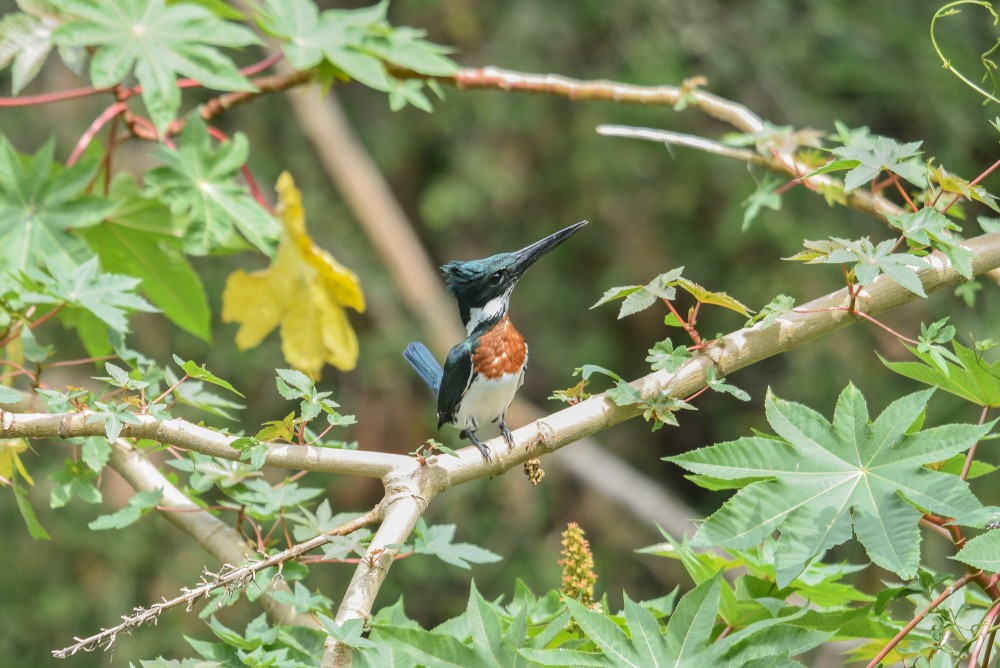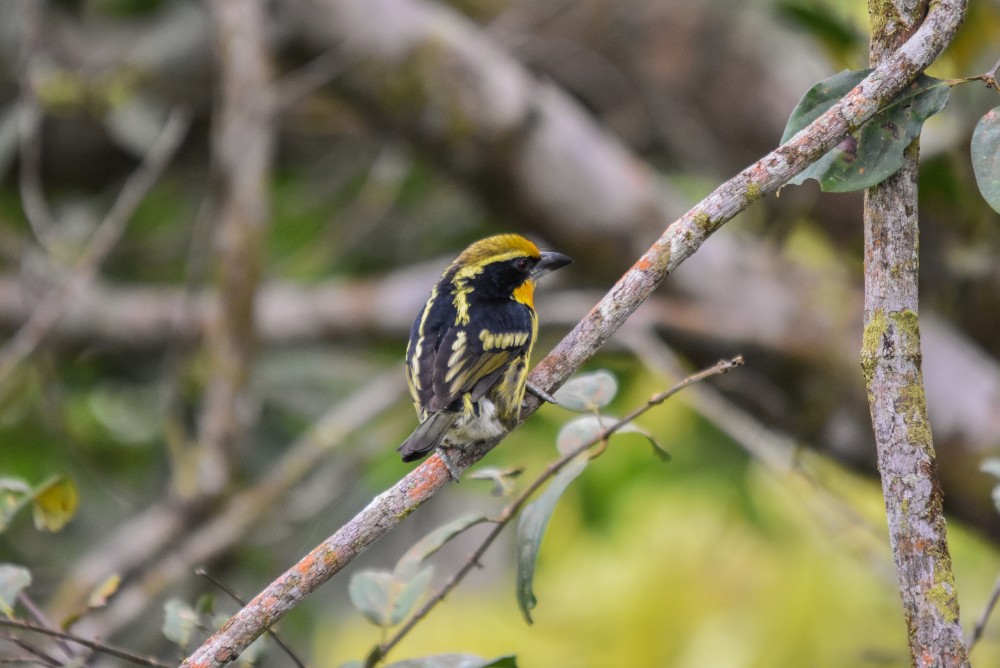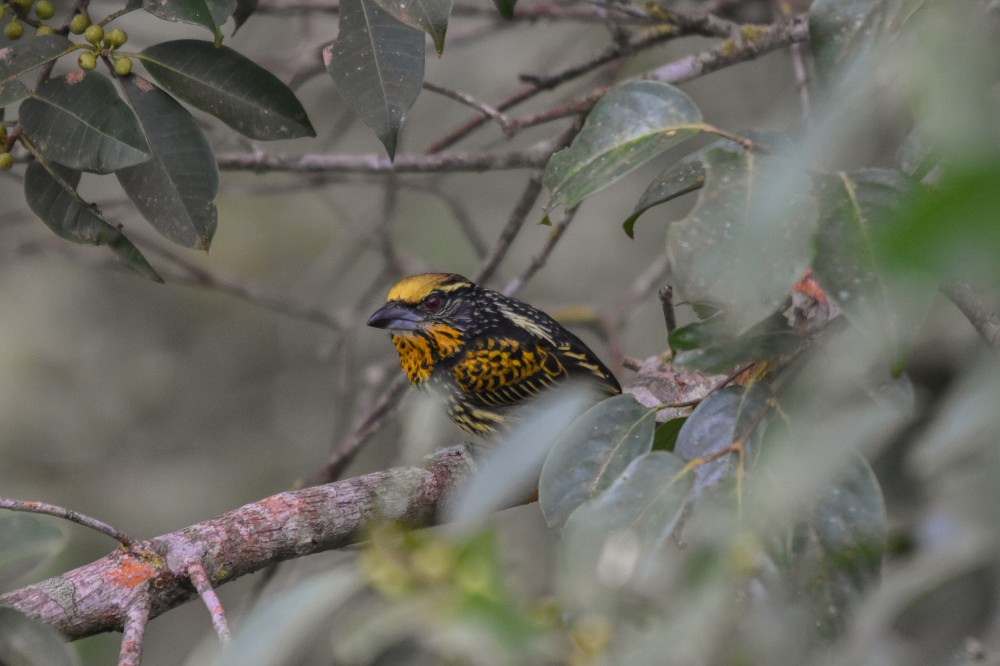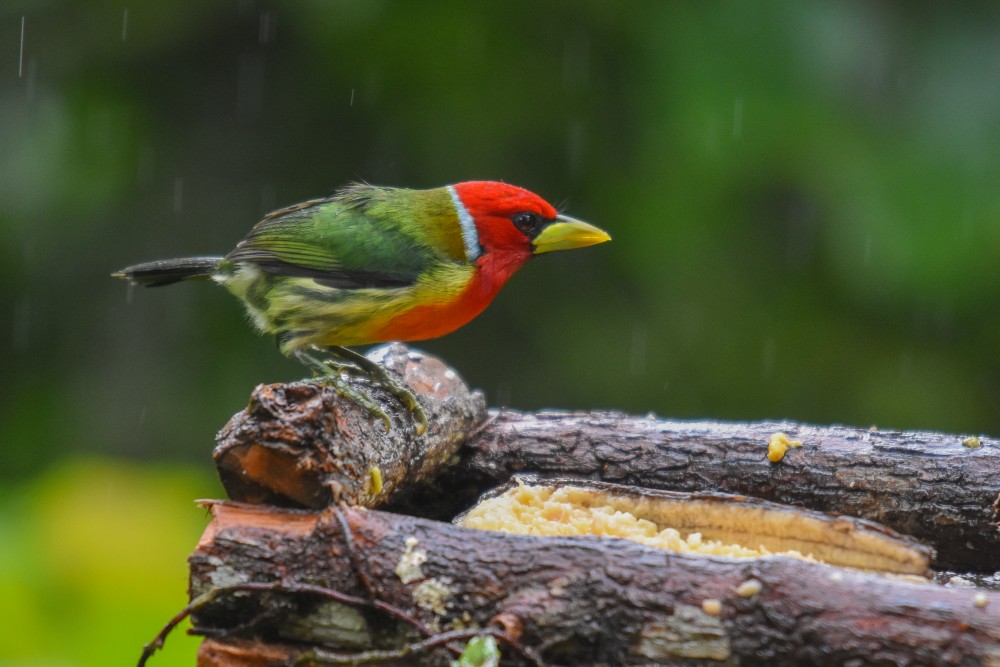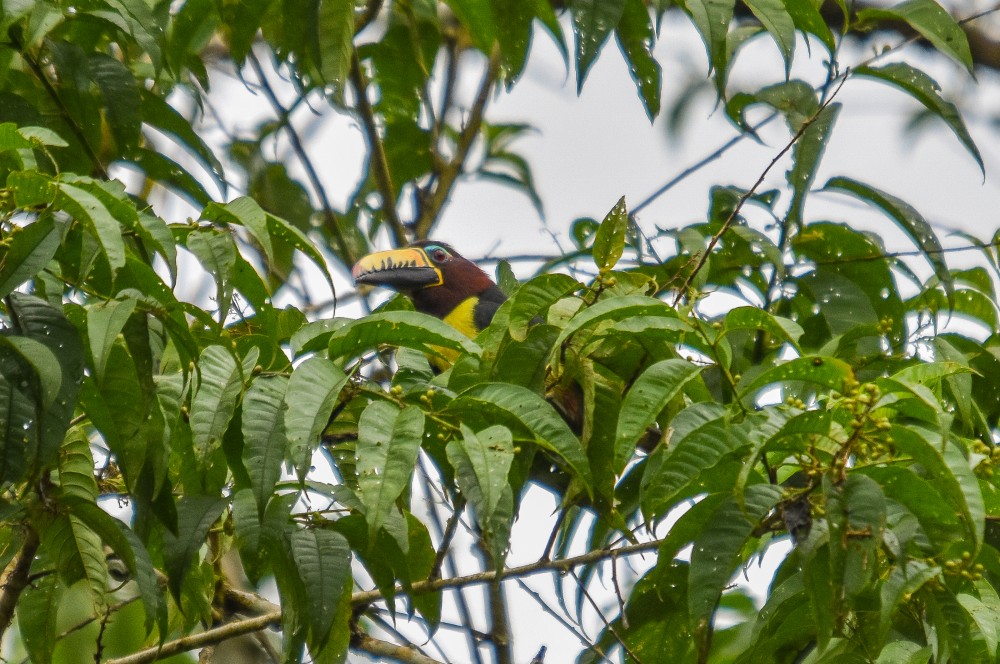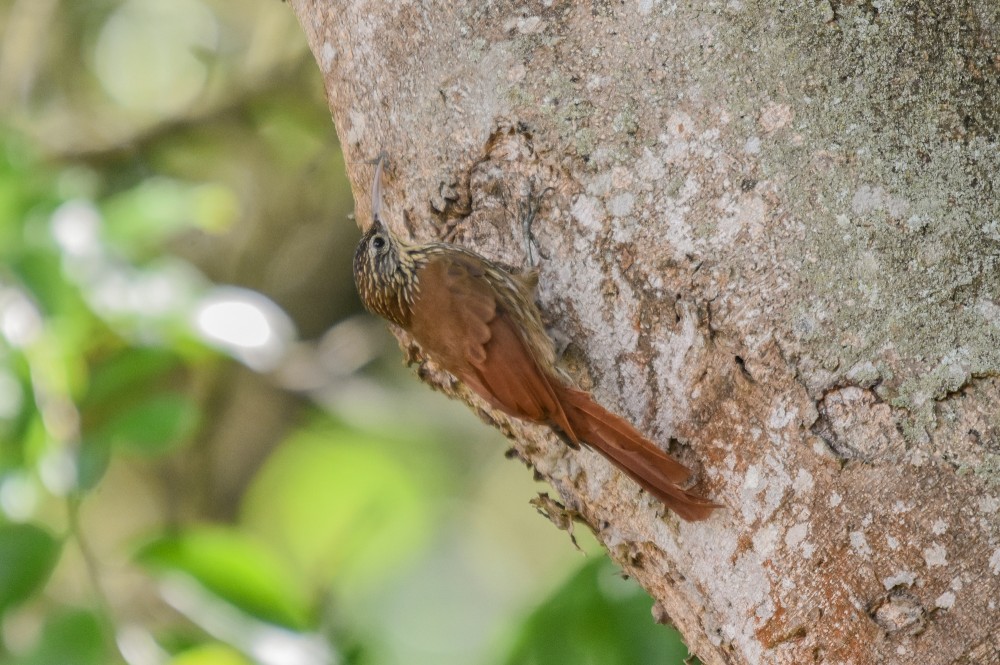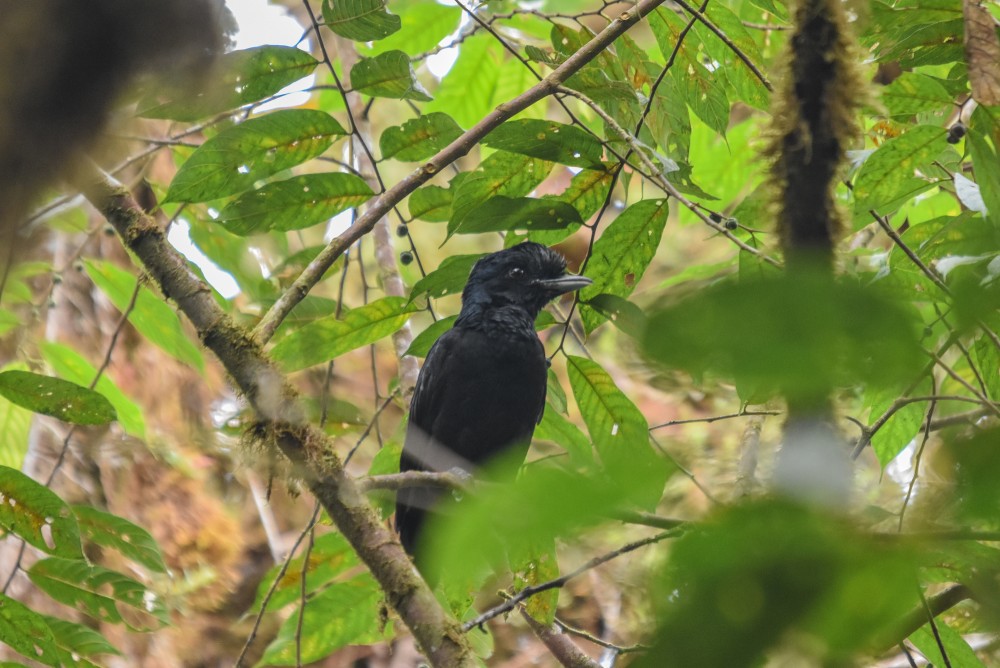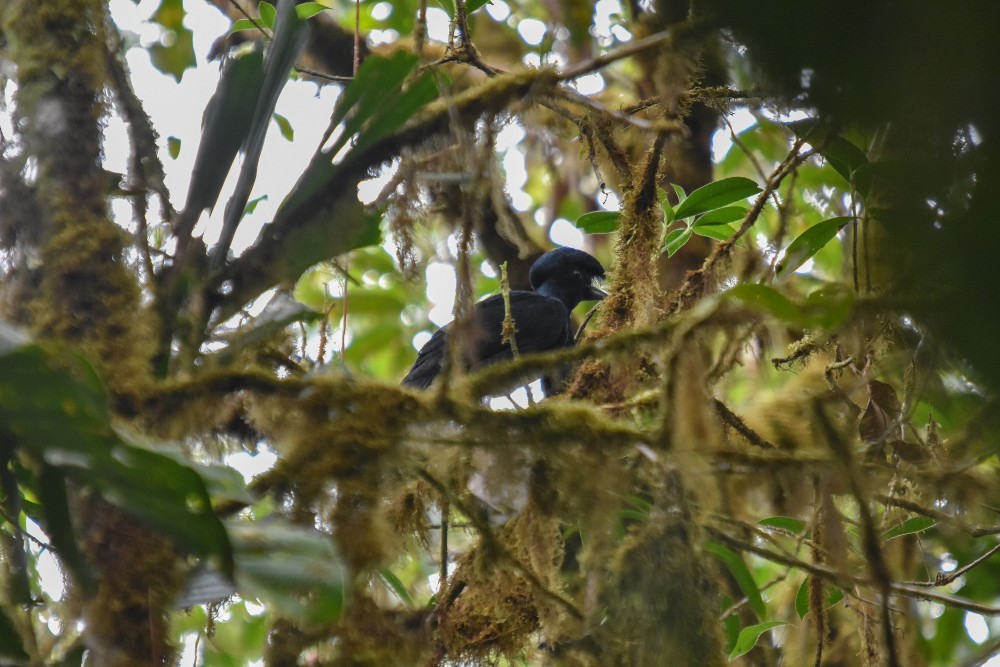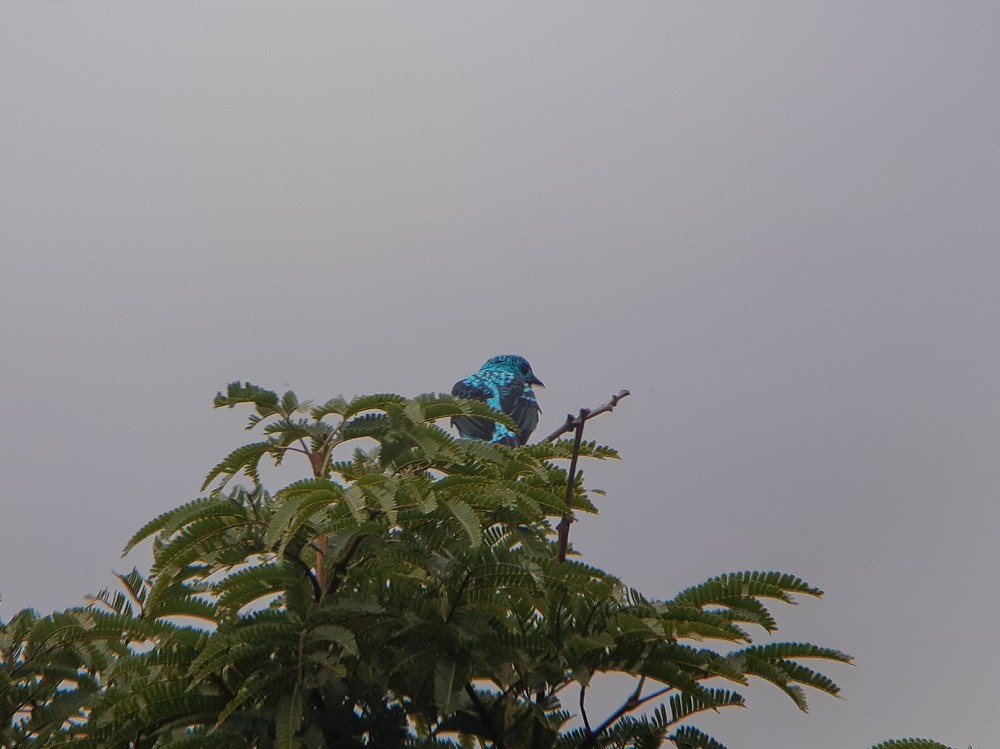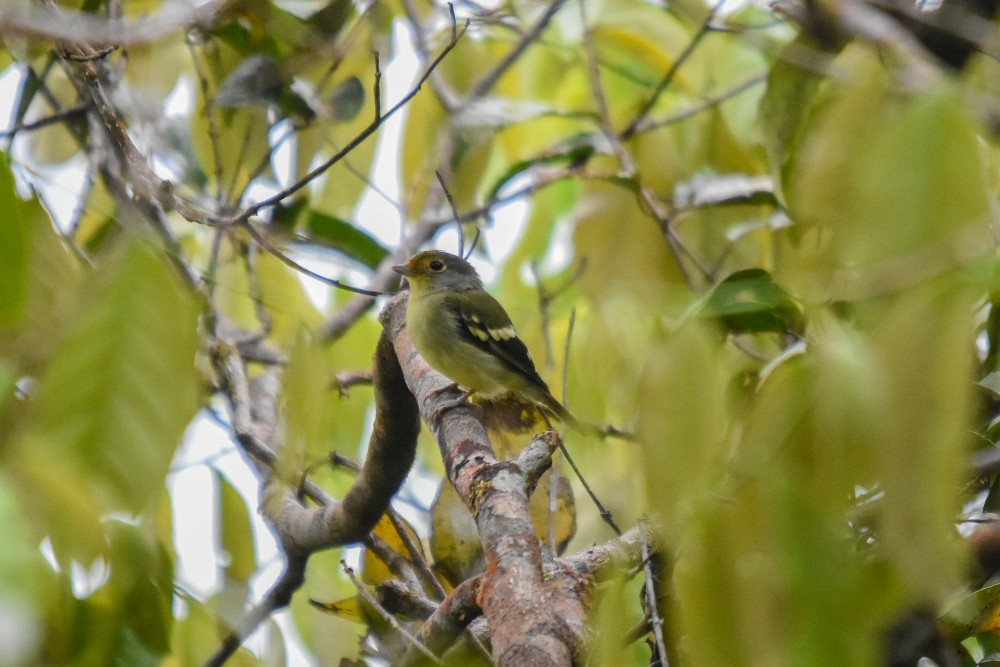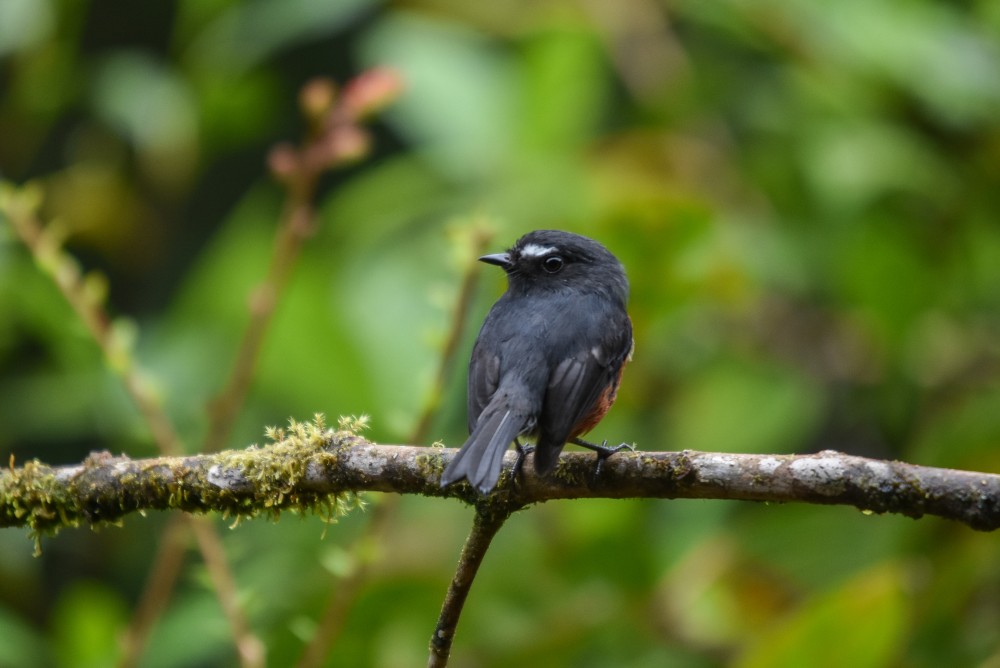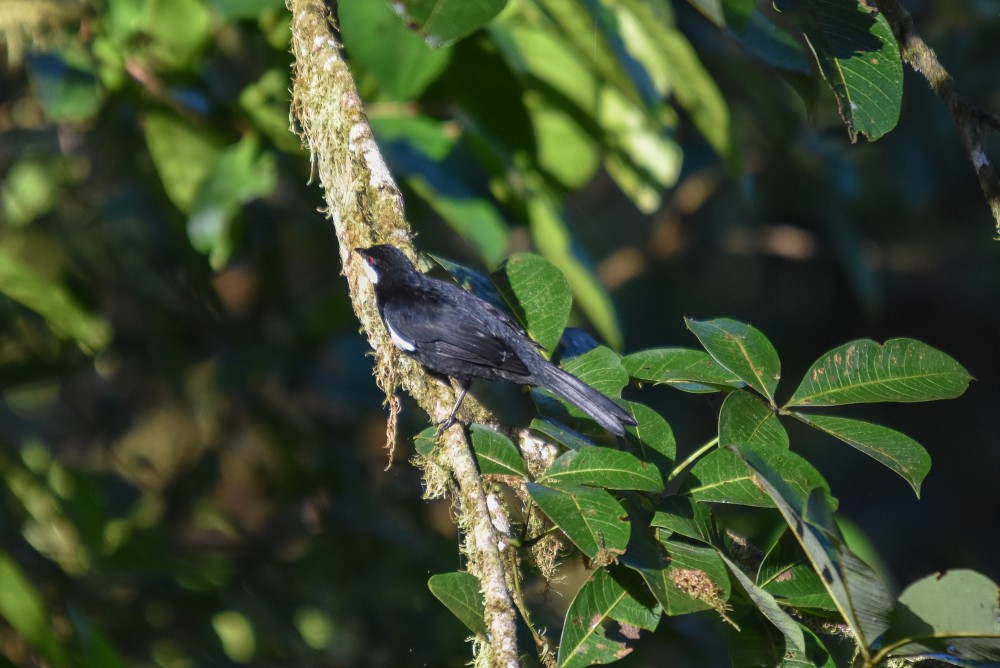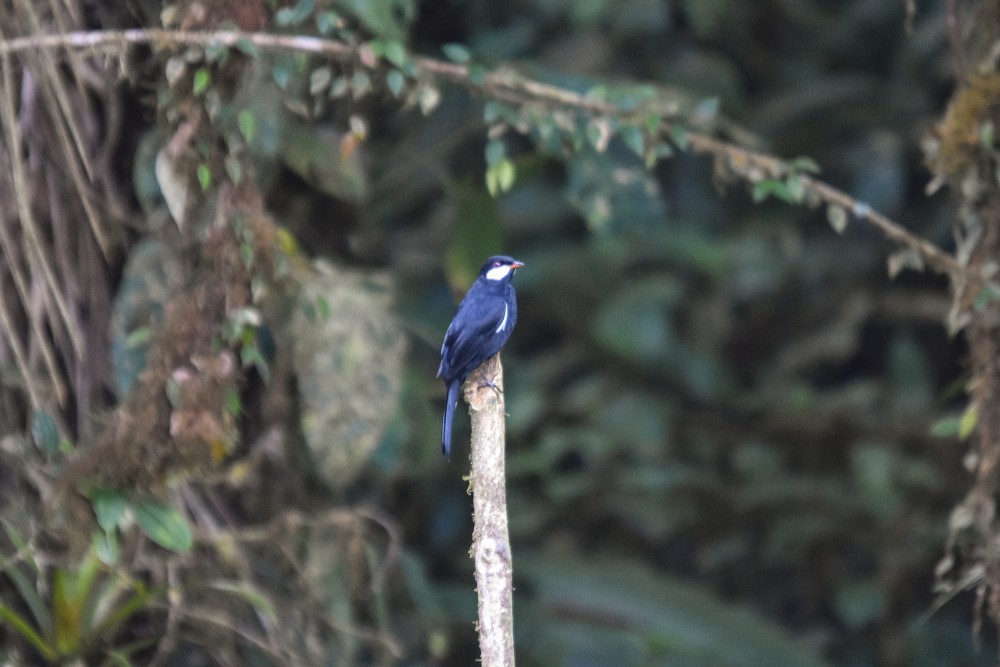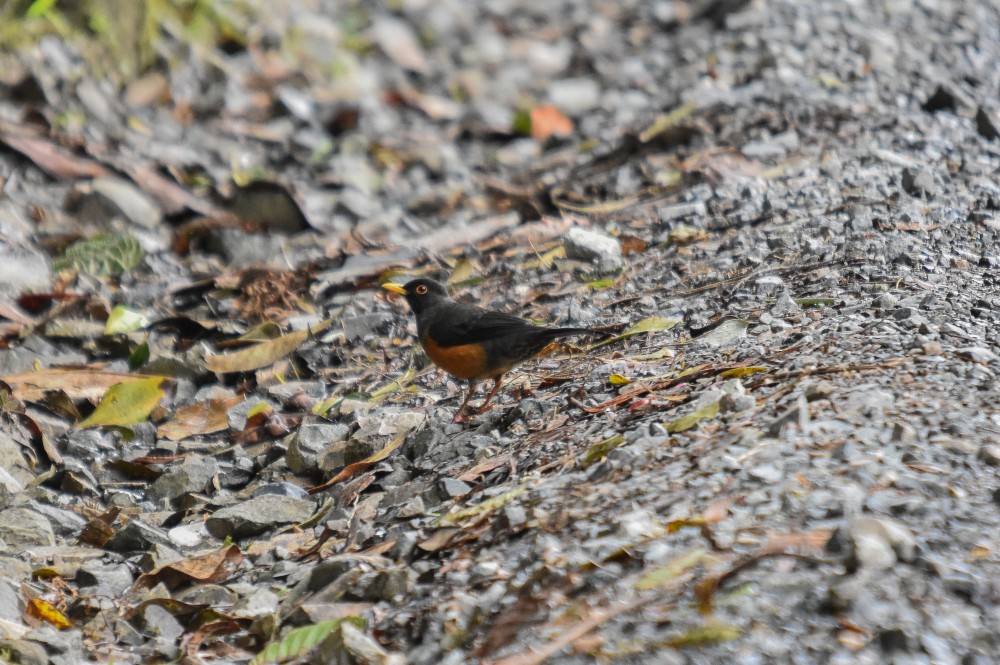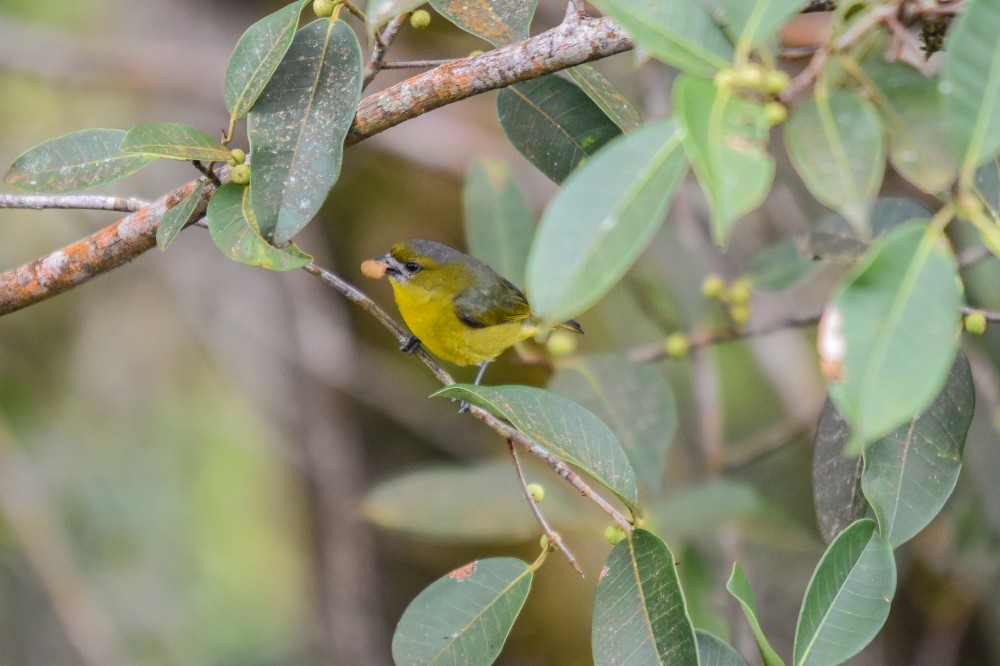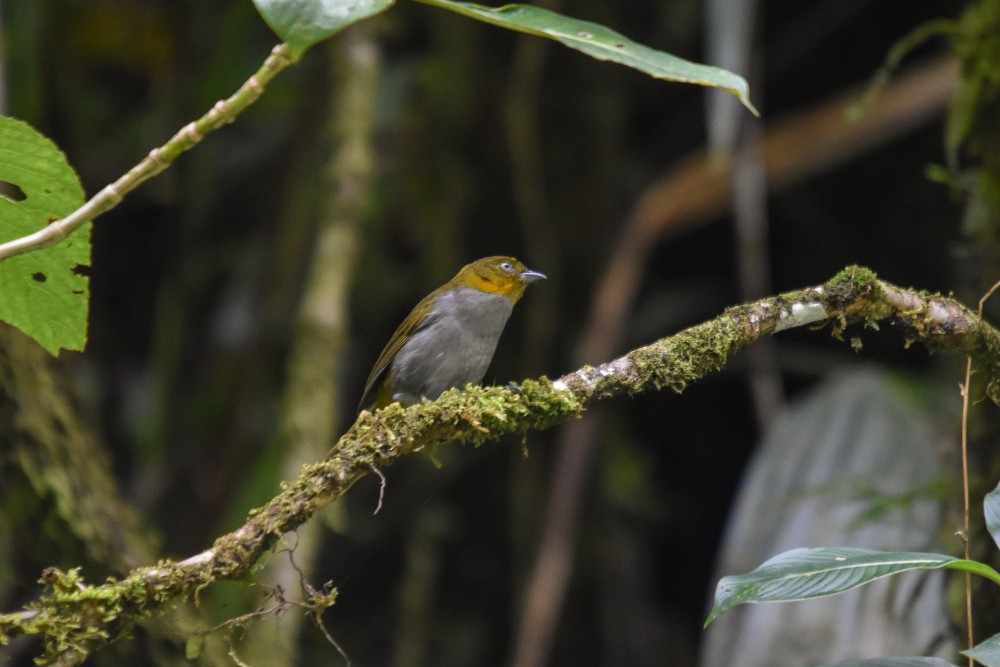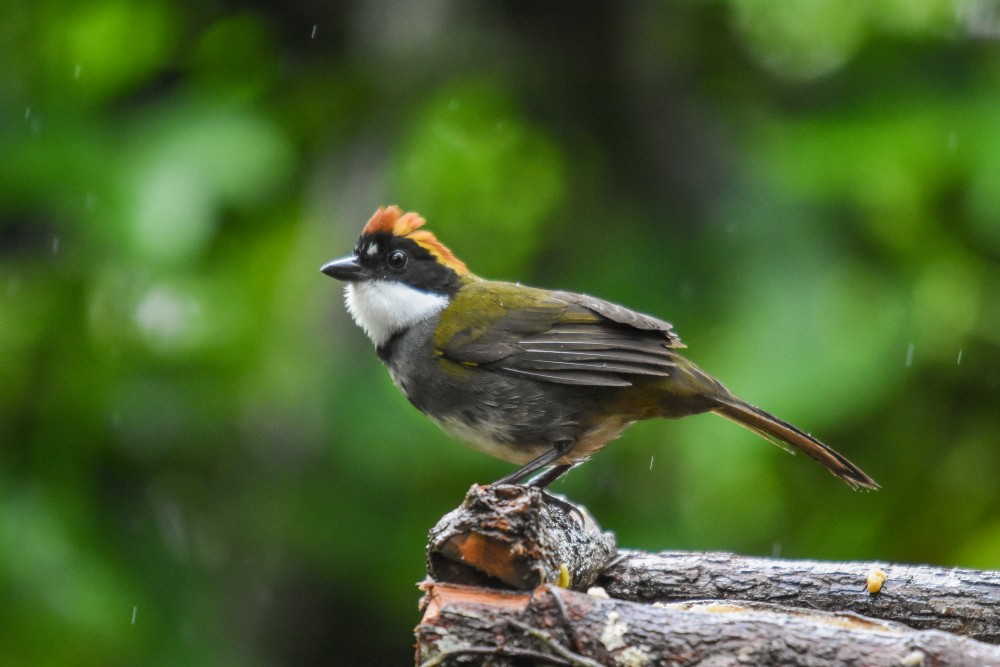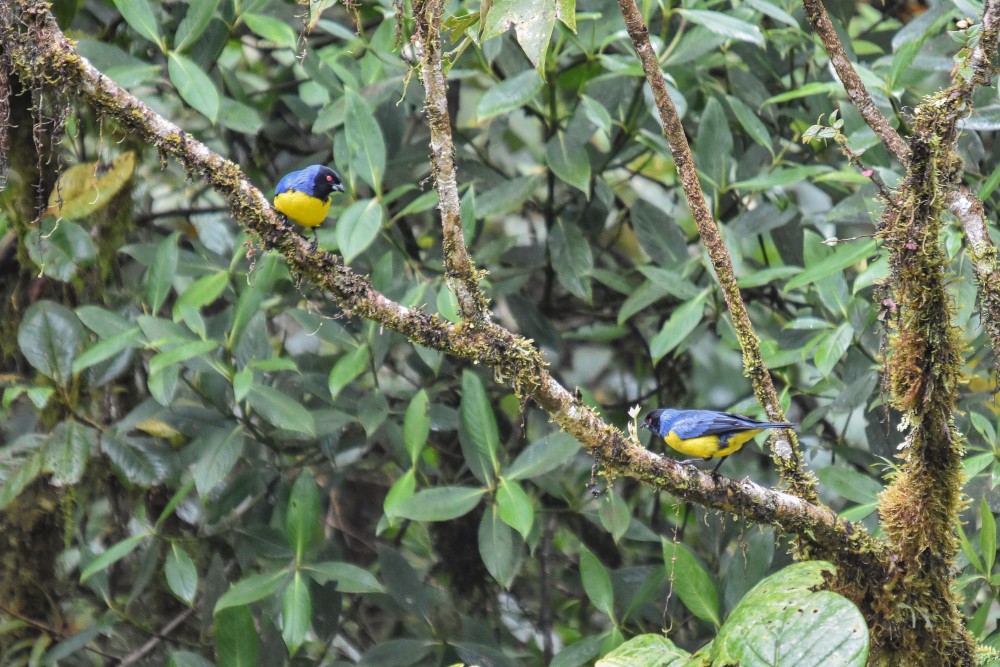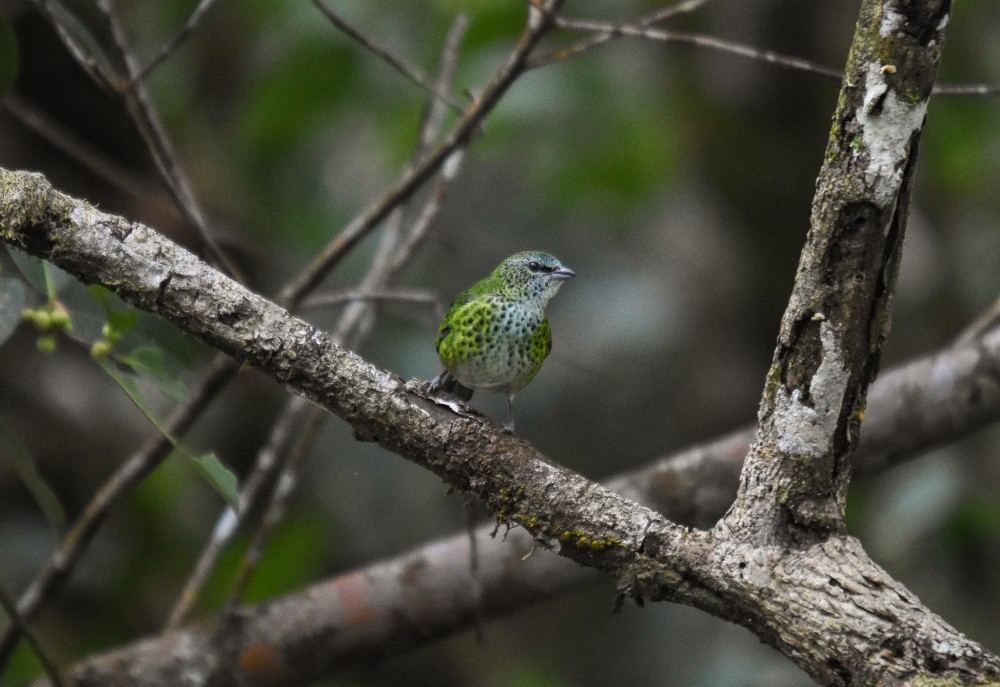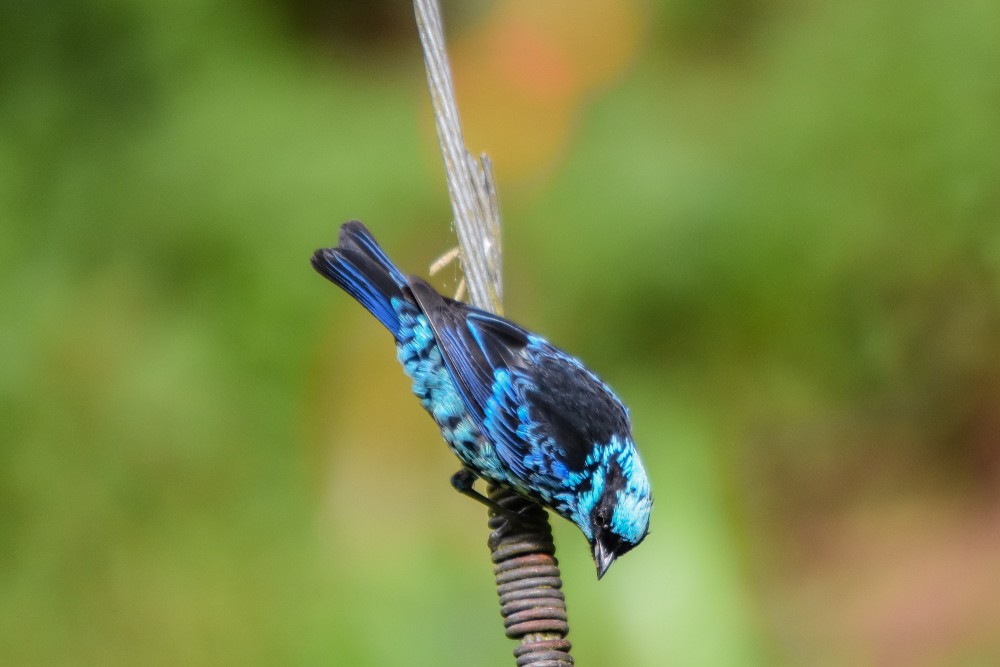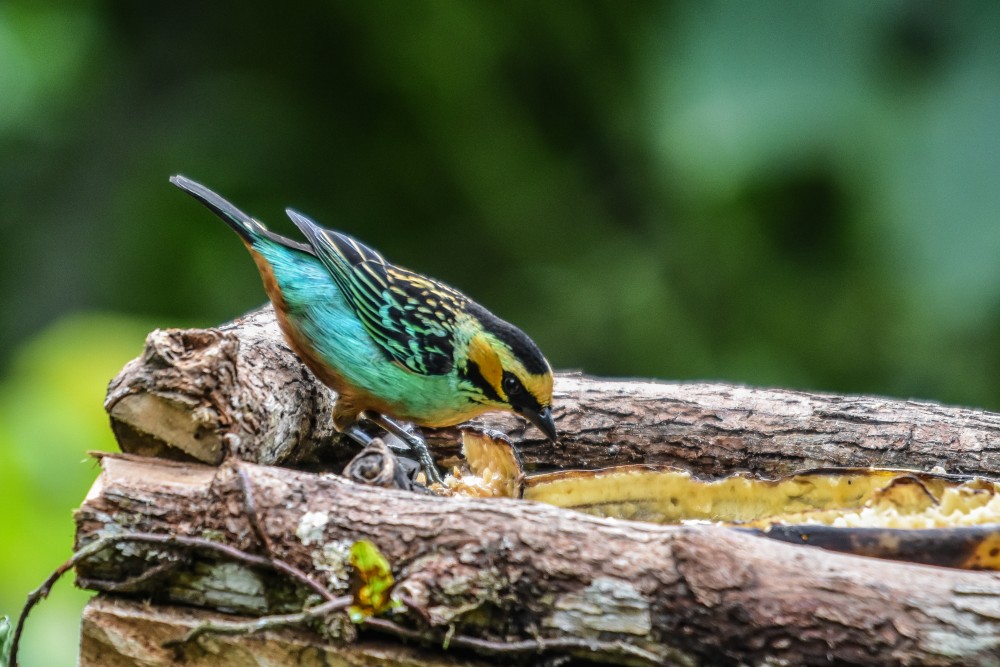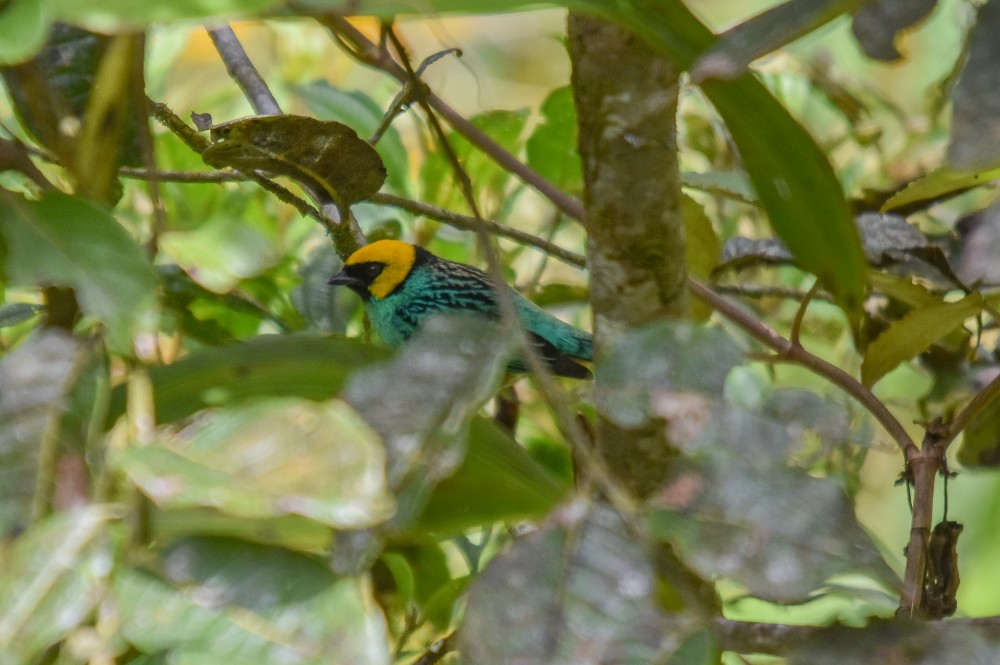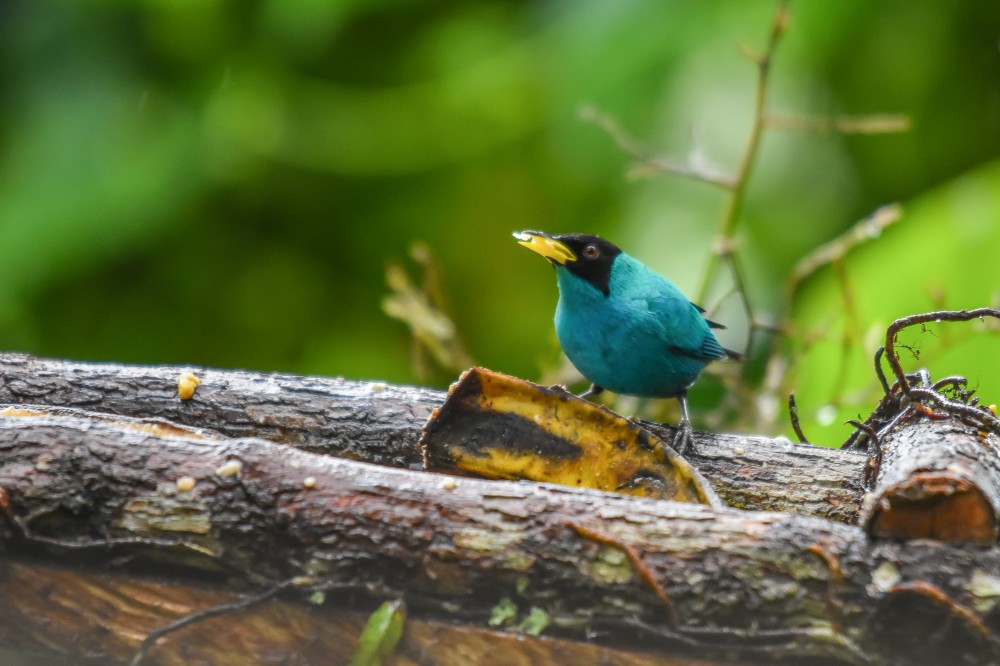Southern Colombia
18 August 2018 – 16 September 2018
After two other trips (January/February 2016 & April/May 2017) in this fabulous country, we travel during one month, mostly in the "not too touristy" southern part of the country (Huila, Putumayo and Nariño) through some incredible birding sites like Reserva La Isla Escondida, Trampolín de las Aves, RN La Planada and RN Río Ñambi.
Visited Sites
- Liberia 18 August 2018 – 19 August 2018
- El Encanto Reserva Ecoturistica 20 August 2018 – 22 August 2018
- Desierto de la Tatacoa 20 August 2018
- Mocoa area 22 August 2018 – 26 August 2018
- Villagarzón area 24 August 2018, 29 August 2018
- RN La Isla Escondida 27 August 2018 – 29 August 2018
- Carretera Mocoa–Sibundoy 30 August 2018 – 01 September 2018
- Laguna de la Cocha 01 September 2018 – 04 September 2018
- Páramo Bordoncillo 03 September 2018
- RN La Planada 04 September 2018 – 06 September 2018
- RN Río Ñambí 06 September 2018 – 09 September 2018
- Santa Rosa de Cabal area 11 September 2018 – 12 September 2018
- RN Laguna de Sonso 11 September 2018
- SFF Otún Quimbaya & PRN Ucumari 12 September 2018 – 13 September 2018
- Calarcá 13 September 2018
- Bogotá 14 September 2018 – 16 September 2018
- PN Chicaque 14 September 2018
- La Calera 15 September 2018
General Travelling Information
Transport
We rent a small car in Bogotá with Localiza. They have good prices and services.
We travel independently and without guide (except where required).
Security
All the visited sites were really safe and we encountered no problem. Most of the inhabitants are friendly and helpful.
We registred ourseft on Itineris, the online registration for Swiss citizens travelling abroad from the Federal Department of Foreign Affairs.
Climate
In August and September, the weather was pleasant. We had some rain but very few iin comparison with April/May 2017 (El Niño). The driest period is between December and February.
All the months could be good, but try to avoid the rainy season during an El Niño event as landslide are regular and could destroy the road or worse your accommodation.
Recommended Literature
Bird trip report of my two previous visits in Colombia (January/February 2016 & April/May 2017)
Field Guide to the Birds of Colombia (Miles McMullan)
Guía Ilustrada de la Avifauna Colombiana (Fernando Ayerbe Quiñones)
Birdwatching in Colombia (Jurgen Beckers & Pablo Florez)
Acknowledgements
A big thank you to Brayan Coral Jaramillo for the advices and for joining us in the Páramo de Bordoncillo, to Ottavio Janni for the advices about the spots to visit in Southern Colombia, to Jurgen Beckers for the organisation of our stay in his amazing Reserva La Isla Escondida, to the family Cruz in Palestina for the friendly welcome in their family hostel and for the advices, to Cristian Florez Pai for arranging our visit in the Reserva Río Ñambi and to all friendly and helpful people we met.
Liberia
We slept our first night in Monte La Mama. During the night we could heard Mottled Owl, Tropical Screech-owl and Common Pauraque. We woke up in the sound of Little Tinamou and Colombian Chachalaca. We spend the morning in the cloud forest around (a few trails were possible to take directly from our accomodation). Some nice species observed included Crimson-rumped Toucanet, Black-faced Tanager and Orange-crowned Oriole.
We also did a stop near Liberia where several flowering trees attracted hummingbirds like Violet-bellied Hummingbird, Brown Violetear and Black-throated Mango. More than 60 species were encountered around Liberia.
Target species
-
 Colombian Chachalaca
Ortalis columbiana
Colombian Chachalaca
Ortalis columbiana
How to get there
We slept in Monte La Mama. A nice and friendly place located 3 hours from the capital where you can sleep under some kind of tent for a very good price.
Desierto de la Tatacoa
In addition to scenic landscapes, there are some dry bushes species present in the bushy areas, like Dwarf Cuckoo, Rufous-tailed Jacamar, Northern White-fringed Antwren, Grey Pileated Finch and Dull-colored Grassquit.
Target species
-
 Pileated Finch
Coryphospingus pileatus
Pileated Finch
Coryphospingus pileatus
Facilities & accommodation
We spend the night in the Dunas Tatacoa, located near Villavieja. A cheap and clean option with the ability to explore the bushy areas around.
El Encanto Reserva Ecoturistica
In Palestina, we stay in the Reserva El Encanto (01°43'15.38"N, 76°07'8.98"W). It was our second stay there. The house is beautiful and the family very friendly. Melida is really helful and cooks some nice meals. Michael gives some useful advices about birds in the reserve and around.
This quiet area also worth it to watch the birds. During our two stays (in 2017 and 2018) we encountered more than 90 species just around the just in the homestead including 5 endemics and a few other near-endemics. We had also some nice observations of Gorgeted Woodstar, Brown Violetear, Bar-crested Antshrike and Golden-eared Tanagers.
We observed many worthwhile migratory birds like American cliff swallow (August 2018), Olive-sided and Alder Flycatcher (May 2017).
Target species
-
 Colombian Chachalaca
Ortalis columbiana
Colombian Chachalaca
Ortalis columbiana
-
 Tolima Dove
Leptotila conoveri
Tolima Dove
Leptotila conoveri
-
 Indigo-capped Hummingbird
Saucerottia cyanifrons
Indigo-capped Hummingbird
Saucerottia cyanifrons
-
 Gorgeted Woodstar
Chaetocercus heliodor
Gorgeted Woodstar
Chaetocercus heliodor
-
 Apical Flycatcher
Myiarchus apicalis
Apical Flycatcher
Myiarchus apicalis
-
 Dusky-headed Brushfinch
Atlapetes fuscoolivaceus
Dusky-headed Brushfinch
Atlapetes fuscoolivaceus
-
 Golden-eared Tanager
Tangara chrysotis
Golden-eared Tanager
Tangara chrysotis
Facilities & accommodation
The Reserva El Encanto is a beautiful charming place to stay.
Mocoa area
The region of Mocoa is a beautiful with different hiking possibilities, also pefect for those who also travel with non-birder friends. During our stay we observed 80 birds species around Mocoa. Mainly we visited three differents areas:
- Fín del Mundo: We have done one walk during a morning to the waterfalls. The forest and the waterfalls are beautiful but it was rather quiet and we encountered relatively few birds. We observed some mixed flocks with for example Gilded Barbet, Black-faced Dacnis and Turquoise Tanager. In the undergrowth, we saw some Grey-chinned and White-bearded Hermit. Between the Hostal Fín del Mundo and the hostal Huaca Huaca, we observed one Grey-crowned Flatbill. We had also 3 Humboldt's Araçaris near the main river. We also went twice, only on the first part of the trail for a short walk.
- ITP Botanical Garden: We went for an afternoon walk in the Botanical garden. Even if it was rather quiet we observed some interesting species such as Chestnut Woodpecker, White-bearded Hermit, Plum-throated Cotinga and Opal-crowned Tanager.
- San Antonio: We watch the birds along the road that reach the the construction site of the new Mocoa - Sibundoy road. We encountered some noteworthy species like Blue-fronted Lancebill, Lined Antshrike, Ecuadorian Tyrannulet and Bronze-green Euphonia.
Facilities & accommodation
We stay in the Posada turistica Dantayaco just south of Mocoa. The location is nice and the price interesting even if the room and the services are lower than all our other accommodations during this trip.
Local guides
We didn't take any guide but if you want one, ask Brayan Coral Jaramillo. He is a friendly guide and knows all the birds of the region!
Other wildlife observed
Pygmy Marmoset (observed once by Nina near the Posada Dantayaco), Squirrel Monkey, Saddleback Tamarin, Neotropical River Otter (Observed in the river before the first waterfall on the way to Fín del Mundo), Common opossum (one crossing the road before Mocoa from Pitalito)
Villagarzón area
We spend a half day on 24 and we just had a brief stop on 29 to explore the south of Villagarzón (0°55'57.9"N 76°35'54.4"W). The area is mainly composed by pastures with some second growth forests.
We encountered several species from the undergrowth like Grey-breasted Crake, Dark-billed Cuckoo, Barred Antshrike and Thrush-like Wren. We observed some tanagers and co like Masked Crimson Tanager, Turquoise Tanager and Yellow-bellied Dacnis. We also observed Chestnut-crowned Becard and Yellow-browed Tody-Flycatcher.
As the habitat is rather open, it is relatively easy to observe some flying birds. We saw, for example, Red-bellied Macaw, Blue-winged Parrotlet, Bare-necked Fruitcrow and White-winged Swallow.
In the grassland interspersed with bushes, we observed Swainson's Flycatcher and Chestnut-bellied Seedeater.
How to get there
Coming from Villagrazón, drive 10 kilometers to the south. Then take a trake to the right. The best area start near the small river about 1km from the start of the track. After that, you can walk to the bigger river.
Facilities & accommodation
We reach this place from Mocoa.
RN La Isla Escondida
One of our highlights in the visited places ( an highly recommended site)!
We stay 3 days and 2 nights in the wonderful Isla La Escondida. During our stay we encountered about 100 species despite one day and a half of strong rain with very few birds observed.
The reserve has a very rich undergrowth full of cryptic species that you heard more than see like White-lored Antpitta, Fulvous Antshrike, Black Antbird, Scale-backed Antbird, Spot-backed Antbird, Foothill Antwren, Moustached Antwren, Rufous-winged Antwren and Rusty-belted Tapaculo. You can found also Black-and-white and Golden-winged Tody-Flycatcher in the bushes along the trails.
We observed many huge mixed flocks including species such as Black-capped Becard, Wing-barred Piprites, Slaty-capped Shrike-Vireo, Fulvous Shrike-Tanager, Flame-crested Tanager, Fulvous-crested Tanager, Green-and-gold Tanager, Yellow-bellied Tanager, Spotted Tanager, Yellow-loredTanager and Tawny-crowned Greenlet. They can be observed regularly from one of the two canopy towers, like the Spangled Cotinga.
Some mixed flocks included bigger species like Amazonian Umbrellabird and Andean Cock-of-the-cock.
Other interesting sightings included Fiery-throated Fruiteater, Grey-tailed Piha and Olivaceous Flatbill.
The soundscape was just completely unbelievable with the songs of Nocturnal Curassow, Band-bellied Owl and Common Potoo to fall asleep and the Great Tinamou and Wattled Guan to wake up.
Target species
-
 Nocturnal Curassow
Nothocrax urumutum
Nocturnal Curassow
Nothocrax urumutum
-
 Band-bellied Owl
Pulsatrix melanota
Band-bellied Owl
Pulsatrix melanota
-
 White-lored Antpitta
Myrmothera fulviventris
White-lored Antpitta
Myrmothera fulviventris
-
 Rusty-belted Tapaculo
Liosceles thoracicus
Rusty-belted Tapaculo
Liosceles thoracicus
-
 Fiery-throated Fruiteater
Pipreola chlorolepidota
Fiery-throated Fruiteater
Pipreola chlorolepidota
-
 Gray-tailed Piha
Snowornis subalaris
Gray-tailed Piha
Snowornis subalaris
-
 Ecuadorian Tyrannulet
Phylloscartes gualaquizae
Ecuadorian Tyrannulet
Phylloscartes gualaquizae
-
 Carmiol's Tanager
Chlorothraupis carmioli
Carmiol's Tanager
Chlorothraupis carmioli
How to get there
We let our rental car in the car park of the Hotel Tayrona in Orito. Then we took a bus to El Libano. From the terminus, we walked up to the Reserva Isla La Escondida. It takes about four hours of walking to reach the lodge. The path is often slippery but it's worth the trip.
Facilities & accommodation
First, as we arrive during the afternoon we stay for one night in Orito. We slept in the Hotel Tayrona. The price are good, the rooms are clean and the staffs friendly and helpful. Then in the morning we reach the Reserva Isla La Escondida. An amazing place with all the comfort you need. It is also possible the slept in a small house on the canopy tower: one of the best experience ever!!!
Local guides
If you want the perfect guide, ask Brayan Coral Jaramillo. He is a friendly guide and know all the birds of the region!
Carretera Mocoa–Sibundoy
The road between Mocoa to Siibundoy is generally called the "Trampolín de la Muerte" (= "Trampoline of Death") and "Trampolín de las aves" (= "Trampoline of the birds) or "Trampolín de la biodiversidad" (= "Trampoline of the biodiversity). It is one of the richess places that we visited with almost 100 species encountered in two days and a half. The first day we explored 40 kilometers of the road from the Restaurante Puerta del Sol toward Sibundoy. The second day we explored the 30 first kilometers from San Francisco toward Mocoa to an atlitude of 1'860 m.a.s.l.
Some species were noted only below 1'500 m.a.s.l. in the first part of the road like Blue-fronted Lancebill, Lined Antshrike, Spectacled Prickletail and Golden-eared Tanager.
The road is very good to observed the multiple mixed flocks composed of many tanagers and allies like Hooded Mountain-Tanager, Speckled, Flame-faced, Golden-crowned, Golden-naped, Grass-green, Orange-eared and Rufous-crested Tanager, Short-billed Bush-Tanager, Deep-blue Flowerpiercer and Yellow-breasted Brush-Finch. We also observed White-tailed Hillstar, Chestnut-bellied Thrush, Pearled Treerunner, Handsome Flycatcher, Lemon-browed Flycatcher and Slaty-backed Chat-Tyrant.
We heard many interesting cryptic species like Bicolored and White-bellied Antpitta, Long-tailed, Spillmann's and White-crowned Tapaculo.
The third day, we went the morning near San Francisco toward the Vereda Minchoy. There we encountered Bicolored Antpitta, Spillmann's Tapaculo, Pearled Treerunner, Handsome Flycatcher and Yellow-breasted Brush-Finch.
Target species
-
 Green-backed Hillstar
Urochroa leucura
Green-backed Hillstar
Urochroa leucura
-
 Lined Antshrike
Thamnophilus tenuepunctatus
Lined Antshrike
Thamnophilus tenuepunctatus
-
 Bicolored Antpitta
Grallaria rufocinerea
Bicolored Antpitta
Grallaria rufocinerea
-
 White-bellied Antpitta
Grallaria hypoleuca
White-bellied Antpitta
Grallaria hypoleuca
-
 Long-tailed Tapaculo
Scytalopus micropterus
Long-tailed Tapaculo
Scytalopus micropterus
-
 Spillmann's Tapaculo
Scytalopus spillmanni
Spillmann's Tapaculo
Scytalopus spillmanni
-
 Spectacled Prickletail
Siptornis striaticollis
Spectacled Prickletail
Siptornis striaticollis
-
 Lemon-browed Flycatcher
Conopias cinchoneti
Lemon-browed Flycatcher
Conopias cinchoneti
-
 Chestnut-bellied Thrush
Turdus fulviventris
Chestnut-bellied Thrush
Turdus fulviventris
-
 Short-billed Chlorospingus
Chlorospingus parvirostris
Short-billed Chlorospingus
Chlorospingus parvirostris
-
 Yellow-breasted Brushfinch
Atlapetes latinuchus
Yellow-breasted Brushfinch
Atlapetes latinuchus
-
 Rufous-crested Tanager
Creurgops verticalis
Rufous-crested Tanager
Creurgops verticalis
-
 Deep-blue Flowerpiercer
Diglossa glauca
Deep-blue Flowerpiercer
Diglossa glauca
-
 Orange-eared Tanager
Chlorochrysa calliparaea
Orange-eared Tanager
Chlorochrysa calliparaea
-
 Golden-eared Tanager
Tangara chrysotis
Golden-eared Tanager
Tangara chrysotis
How to get there
The road is easily accessible from Mocoa or Sibundoy. The best is to do some regular stops. You can park the car where it does not interfere with traffic (the road is locally very narrow) and walk up and down to watch the birds along the road.
Facilities & accommodation
We explore the lowest part from Mocoa. We slept first in Mocoa in the Hotel Imari (a nice and cheap option), then we drive to the highest part of the road from Sibundoy and we slept in the Posadas Turisticas Villa Beatriz (a very nice and friendly place).
Local guides
We didn't take any guide but if you want one, ask Brayan Coral Jaramillo. He is a friendly guide and knows all the birds of the region!
Laguna de la Cocha
We visited twice the area of the Laguna de la Cocha (in 2017 and in 2018). The weather was particularly rainy in 2017 which made bird watching difficult. In 2018, the weather was better but not perfect (windy and cloudy).
We explored four different areas in the region:
- El Encano: We take also a boat tou to Isla de la Corata and to a small area west of the village. Interesting species euncountered on the shore of the lake included Yellow-billed Pintail, Virginia Rail, Andean Coot and Andean Gull.
- El Motilon: from there we observed in 2017 a Silvery Grebe and some Grassland Yellow Finch.
- Santa Rosa: The waterfowls observed here were the same as in El Encanto. Additional interesting species: Cinereous Harrier.
- El Socorro: We walked up from the northeast of El Encano (area of El Socorro) on the right at the sign of "Páramo Bordoncillo" from the village. The trail was really dirty in the end so we returned back (the rain also became more intense). In 2017, we observed several Grey-breasted Mountain Toucan (apparently not so rare here; with some close observations), Red-crested Cotinga, relatively big groups of Hooded and Lacrimose Mountain-tanagers. We also saw a pretty late Swainson's Thrush.
Target species
-
 Virginia Rail
Rallus limicola
Virginia Rail
Rallus limicola
-
 Slate-colored Coot
Fulica ardesiaca
Slate-colored Coot
Fulica ardesiaca
Facilities & accommodation
We were staying in Santa Rosa in the Hotel Jardín del Lago, a relatively cheap accommodation with a beautiful view over the lake, hot water and Wi-Fi. In 2017 a Rufous-banded Owl was singing near the hotel.
Páramo Bordoncillo
We visited twice to the Páramo de Bordoncillo (in 2017 and 2018). Located at the limit between Nariño and Putumayo, we walked up along a small trail to an area with some communication towers. The two main reasons to come to this place is to search for the rare Chestnut-bellied Cotinga and Masked Mountain-tanager. Unfortunately, both visits were unsuccessful, mainly due to the foggy, windy and rainy weather that do not make it easy to find these species.
We still observed some interesting birds like Rainbow-bearded Thornbill, White-chinned Thistletail, White-browed Spinetail, Agile Tit-Tyrant, Paramo Tapaculo. In 2018, we were lucky to spot two Noble Snipes walking along the trail just a few meters from us.
Target species
-
 Noble Snipe
Gallinago nobilis
Noble Snipe
Gallinago nobilis
-
 Chestnut-bellied Cotinga
Doliornis remseni
Chestnut-bellied Cotinga
Doliornis remseni
Not observed
-
 Masked Mountain Tanager
Tephrophilus wetmorei
Masked Mountain Tanager
Tephrophilus wetmorei
Not observed
How to get there
From the Laguna de la Cocha, drive 10 km from El Encano or 12.5 km from Santa Rosa to the limit between Nariño and Putumayo (1°08'51.3"N 77°05'57.9"W). You can park where near the small houses (ask the permission first and give something to them after). Then walk up the trail starting between the houses.
Facilities & accommodation
We visited this place from the Laguna de la Cocha and we were sleeping in the Hotel Jardín del Lago, located 12.5 kilometers away from the start of the trail.
Local guides
Brayan Coral Jaramillo is an amazing and friendly guide and knows all the birds of the region! He joint us during one morning in the Paramó de Bordoncillo and it was wonderful!
RN La Planada
We spend 3 days and 2 nights in the beautiful Reserva La Planada. The staf members were really friendly. The forest is beautiful and holds many interesting Choco endemic species like Dark-backed Wood-quail, Violet-tailed Sylph (common), Hoary Puffleg, Brown Inca, Purple-throated Woodstar (observed once near the entrance), Plate-billed Mountain-toucan, Toucan Barbet, Yellow-breasted Antpitta (heard and observed briefly around the first curve on the main road), Narino Tapaculo (relatively common), Uniform Treehunter, Fulvous-dotted Treerunner, Choco Tyrannulet (observed along the main road near the entrance), Beautiful Jay (one observed from a small opening where it is possible to observe the opposite forest) Dusky Bush-tanager, Glistening-green Tanager and Choco Brush-finch (observed near the entrance and aroud the first curve below on the main road). We also heard once a White-faced Nunbird.
The birds were relatively common along the main road from the entrance to the small opening where it is possible to observe the opposite forest. We encountered 75 species during our stay.
[Highly recommended site]
Target species
-
 Dark-backed Wood-Quail
Odontophorus melanonotus
Dark-backed Wood-Quail
Odontophorus melanonotus
-
 Violet-tailed Sylph
Aglaiocercus coelestis
Violet-tailed Sylph
Aglaiocercus coelestis
-
 Hoary Puffleg
Haplophaedia lugens
Hoary Puffleg
Haplophaedia lugens
-
 Brown Inca
Coeligena wilsoni
Brown Inca
Coeligena wilsoni
-
 Purple-throated Woodstar
Philodice mitchellii
Purple-throated Woodstar
Philodice mitchellii
-
 White-faced Nunbird
Hapaloptila castanea
White-faced Nunbird
Hapaloptila castanea
-
 Plate-billed Mountain-Toucan
Andigena laminirostris
Plate-billed Mountain-Toucan
Andigena laminirostris
-
 Toucan Barbet
Semnornis ramphastinus
Toucan Barbet
Semnornis ramphastinus
-
 Yellow-breasted Antpitta
Grallaria flavotincta
Yellow-breasted Antpitta
Grallaria flavotincta
-
 Nariño Tapaculo
Scytalopus vicinior
Nariño Tapaculo
Scytalopus vicinior
-
 Uniform Treehunter
Thripadectes ignobilis
Uniform Treehunter
Thripadectes ignobilis
-
 Fulvous-dotted Treerunner
Margarornis stellatus
Fulvous-dotted Treerunner
Margarornis stellatus
-
 Choco Tyrannulet
Zimmerius albigularis
Choco Tyrannulet
Zimmerius albigularis
-
 Beautiful Jay
Cyanolyca pulchra
Beautiful Jay
Cyanolyca pulchra
-
 Dusky Chlorospingus
Chlorospingus semifuscus
Dusky Chlorospingus
Chlorospingus semifuscus
-
 Tricolored Brushfinch
Atlapetes tricolor
Tricolored Brushfinch
Atlapetes tricolor
-
 Glistening-green Tanager
Chlorochrysa phoenicotis
Glistening-green Tanager
Chlorochrysa phoenicotis
Facilities & accommodation
We slept in a nice chalet in the Reserva La Planada (ca. 100'000 COP/night for 2 persons).
Other wildlife observed
Many frogs, reptiles, insects and other wildlife.
RN Río Ñambí
The forest of the Reserva Río Ñambi is marvelous with some awesome species and the trees are full of epiphytes. We spend 4 days here. This site hosts many Choco endemic species; some observed are the same as on the previous site (La Planada) like Dark-backed Wood-quail, Violet-tailed Sylph, Brown Inca, Uniform Treehunter and Glistening-green Tanager (more common here).
One of the most iconic species observed in Río Ñambi is the Long-wattled Umbrellabird. We had a group of three birds (1 male and 2 females) in the lower part of the reserve. In this part we also encountered Barred Forest-Falcon, Choco Toucan and Zeledon's Antbird.
The small loop above the lodge was rather productive. We saw there aRufous-gaped Hillstar, an Ochre-breasted Antpitta perched in front of us, a few Toucan Barbets, a Choco Vireo, at least one Black Solitaire, a Black-capped Pygmy-Tyrant, a Black-chinned Mountain-tanager, some Moss-backed Tanagers and Olive Finches.
Around the lodge, we had many mixed flocks with Pacific Flatbill, Indigo Flowerpiercer, Dusky Bush-tanager, Silver-throated and Rufous-throated Tanager. We observed also a White-throated Spadebill. Early in the morning, we heard a Cloudforest Pygmy-owl singing.
Some other interesting species were encountered in small numbers pretty much everywhere in the reserve like Broad-billed Motmot, Fulvous-breasted Flatbill, Choco Warbler and Ochre-breasted Tanager.
[Highly recommended site]
Target species
-
 Dark-backed Wood-Quail
Odontophorus melanonotus
Dark-backed Wood-Quail
Odontophorus melanonotus
-
 Violet-tailed Sylph
Aglaiocercus coelestis
Violet-tailed Sylph
Aglaiocercus coelestis
-
 Brown Inca
Coeligena wilsoni
Brown Inca
Coeligena wilsoni
-
 Rufous-gaped Hillstar
Urochroa bougueri
Rufous-gaped Hillstar
Urochroa bougueri
-
 Cloud-forest Pygmy-Owl
Glaucidium nubicola
Cloud-forest Pygmy-Owl
Glaucidium nubicola
-
 Choco Toucan
Ramphastos brevis
Choco Toucan
Ramphastos brevis
-
 Toucan Barbet
Semnornis ramphastinus
Toucan Barbet
Semnornis ramphastinus
-
 Uniform Treehunter
Thripadectes ignobilis
Uniform Treehunter
Thripadectes ignobilis
-
 Long-wattled Umbrellabird
Cephalopterus penduliger
Long-wattled Umbrellabird
Cephalopterus penduliger
-
 Choco Vireo
Vireo masteri
Choco Vireo
Vireo masteri
-
 Black Solitaire
Entomodestes coracinus
Black Solitaire
Entomodestes coracinus
-
 Dusky Chlorospingus
Chlorospingus semifuscus
Dusky Chlorospingus
Chlorospingus semifuscus
-
 Ochre-breasted Tanager
Chlorothraupis stolzmanni
Ochre-breasted Tanager
Chlorothraupis stolzmanni
-
 Indigo Flowerpiercer
Diglossa indigotica
Indigo Flowerpiercer
Diglossa indigotica
-
 Black-chinned Mountain Tanager
Anisognathus notabilis
Black-chinned Mountain Tanager
Anisognathus notabilis
-
 Glistening-green Tanager
Chlorochrysa phoenicotis
Glistening-green Tanager
Chlorochrysa phoenicotis
-
 Moss-backed Tanager
Bangsia edwardsi
Moss-backed Tanager
Bangsia edwardsi
-
 Choco Warbler
Myiothlypis chlorophrys
Choco Warbler
Myiothlypis chlorophrys
How to get there
First, contact the FELCA to organize your visit.
If you come with your own car you can park near the small shop (1°16'60.0"N 78°05'35.3"W), before the entrance (ask the permission and give something when you return). From here you have about an hour and a half of walking.
Facilities & accommodation
We slept in the lodge Reserva Río Ñambi. The lodge is relatively basic but nice and well located in the middle of the forest.
Local guides
There is for each visit an official guide from the FELCA.
Other wildlife observed
Many frogs, reptiles, insects and other wildlife.
RN Laguna de Sonso
I visited thrice the site: in January 2016, in April 2017 and in September 2018. In 2017 and 2018, we spent more time exploring the place than in 2017. Each year, we birded in the area going to the reserve and in 2016 and 2018 we also visited the reserve itself and the lake. The reserve was always closed but fortunately each time someone open the gate for us. In January, the whole area was very dry (except the wetlands around the lake) and in April all the surroundings were flooded. The site is really good for the local waterfowls and waders like Least Grebe, Horned Screamer, Black-bellied Whistling Duck, Fulvous Whistling Duck, Roseate Spoonbill, Cocoi Heron, Anhinga, Limpkin, Black-necked Stilt, Wattled Jacana, as for the migrant and wintering ones like Northern Shoveler, Glossy Ibis, Greater Yellowlegs, Lesser Yellowlegs, Solitary Sandpiper, Spotted Sandpiper, Baird's Sandpiper or Pectoral Sandpiper. The Laguna de Sonso is one of the best site in the interior of Colombia for migratory species. Some of them are really abundant like Barn Swallow and Sand Martin, and some others are rarities as it may be one of the most southerly place for several North American species like Wilson's Snipe, Belted Kingfisher (only a handful of records so far south in South America) and Orchard Oriole! The region hosted also some species not especially linked with water like Grey-headed Dove, Ruby-topaz Hummingbird, Greyish Piculet (pretty common in 2018), Bar-crested Antshrike and Apical Flycatcher (common). The Snail Kite are also really common around.
Target species
-
 Horned Screamer
Anhima cornuta
Horned Screamer
Anhima cornuta
-
 Grayish Piculet
Picumnus granadensis
Grayish Piculet
Picumnus granadensis
-
 Apical Flycatcher
Myiarchus apicalis
Apical Flycatcher
Myiarchus apicalis
-
 Flame-rumped Tanager
Ramphocelus flammigerus
Flame-rumped Tanager
Ramphocelus flammigerus
How to get there
From Buga take the main road to Buenaventura and turn on the left just before the bridge over Río Cauca in the hamlet of Puerto Bertin. Cross the hamlet and continue a few hundred meters on the main track. Have a first look over the river. This place is interesting for the waders. Then continue and turn on the left to the entrance of the reserve. In the reserve, you can walk on the trails and watch the lake from the observation towers.
Facilities & accommodation
There are different hotels in Buga for all rates. In 2018, we slept in the Hotel gran ambrosia. It was a nice and relatively cheap hotel (less thant 20 USD for a double room).
Santa Rosa de Cabal area
In 2018, we visited the Termales de Santa Rosa de Cabal. We birded early in the morning around our hostal. From there we observed some nice species such as Greyish-throated Toucanet, Greyish Piculet and Black-winged Saltator.
Then we went to the Termales. As it was not open we decied to observe the birds along the road between the car park and the Hotel Termales. We had a Red-ruffed Fruitcrow with 5 Greyish-throated Toucanets and 2 Golden-headed Quetzals, as well as a nice observation of Golden-winged Manakin and White-naped Brush-Finch.
When the thermal baths were opened, we reach the Balneario. We enjoy the hot water and we observed also the surroundings. The bushes flowering attracted many hummingbirds like Bronzy Inca, Western Wedge-billed Hummingbird ,Western Emerald and Booted Racket-tail
In 2016, I visited the area of Potreros (04°51'24.07"N, 75°29'4.57"W). This site is apparently a good option and relatively accessible site to try the endemic and critically endangered Indigo-winged Parrot, whose current population is approximatively 160 birds. I observed 4 birds feeding at the top of the trees. I also observed there 2 other rare parakeets: Rufous-fronted and Golden-plumed Parakeet, and I encountered Purple-backed Thornbill and Grey-breasted Mountain Toucan during my waiting time.
Target species
-
 White-throated Daggerbill
Schistes albogularis
White-throated Daggerbill
Schistes albogularis
-
 Grayish Piculet
Picumnus granadensis
Grayish Piculet
Picumnus granadensis
-
 Indigo-winged Parrot
Hapalopsittaca fuertesi
Indigo-winged Parrot
Hapalopsittaca fuertesi
Observed in 2016
-
 Red-ruffed Fruitcrow
Pyroderus scutatus
Red-ruffed Fruitcrow
Pyroderus scutatus
Facilities & accommodation
We slept in the Hospedaje El Mirador. A cheap and nice option well located.
SFF Otún Quimbaya & PRN Ucumari
We visited thrice the SFF Otún Quimbaya (in 2016, 2017 and 2018). It is another paradise for birdwatcher. An easily accessible site with relatively cheap and nice accommodations, friendly staff and some fabulous birding opportunities. During all my visits, we encountered more than 130 bird species including 7 endemics: Cauca Guan (very common everywhere around the site), Chestnut Wood-quail (heard once), Greyish Piculet (once observation with 3 birds on the Sendero Bejucos), Stiles's Tapaculo, Sooty-headed Wren (once 2 birds along the road), Flame-rumped Tanager, Multicolored Tanager (along the road) and Crested Ant Tanager (seen twice on the river side of the road), as well as 7 near-endemics such as Brown Inca and Moustached Antpitta (heard on the mountain side of the road just after the center). I also encountered several other interesting species like Tawny-breasted Tinamou (heard and observed once in 2016), Mottled Owl (hears in April 2017), Collared Trogon, Spotted Barbtail, Plumbeous-crowned Tyrannulet, Andean Cock-of-the-rock, Red-ruffed Fruitcrow (surprisingly abundant here), Chestnut-breasted Wren, Blue-naped Chlorophonia, Chestnut-breasted Chlorophonia, Cerulean Warbler (once along the road near the center in a mixed flock), Ashy-throated Bush Tanager and Golden-naped Tanager (observed once along the road in a mixed flock). A good strategy to bird here is to stay for 2 nights. In the early morning go for a walk along the road then return back to the center for the breakfast and to do one of the other trails (to visit the 3 other ones you have to be accompanied by an official guide). Then return back to the road. Generally the midday is good for the mixed flocks that could be really nice here. After lunch you can go higher along the road (in the direction of El Cedral). If you want to change a bit, you can also prospect the garden and the edge of the forest or the nearby river for dipper and Torrent Duck. And if you want a break or if it is raining, you can drink a beer (or else) with a good view.
In 2019, the weather were not the best but we still encountered more than 60 species in 24 hours. We heard at least 4 different Moustached Antpitta 1'200 meters from the visitor center (4°43'25.4"N 75°34'06.4"W).
Target species
-
 Cauca Guan
Penelope perspicax
Cauca Guan
Penelope perspicax
-
 Chestnut Wood-Quail
Odontophorus hyperythrus
Chestnut Wood-Quail
Odontophorus hyperythrus
-
 Grayish Piculet
Picumnus granadensis
Grayish Piculet
Picumnus granadensis
-
 Moustached Antpitta
Grallaria alleni
Moustached Antpitta
Grallaria alleni
-
 Red-ruffed Fruitcrow
Pyroderus scutatus
Red-ruffed Fruitcrow
Pyroderus scutatus
-
 Flame-rumped Tanager
Ramphocelus flammigerus
Flame-rumped Tanager
Ramphocelus flammigerus
-
 Multicolored Tanager
Chlorochrysa nitidissima
Multicolored Tanager
Chlorochrysa nitidissima
How to get there
The access is easy from Pereira along the river. At the end, the road can be quite bad, but it is possible to go to the visitor center without a four-wheel drive car.
Facilities & accommodation
We slept in the SFF Otún Quimbaya. They have double rooms, as well as dormitories.
Calarcá
We spend the end of the afternoon in the beautiful Quindío Botanical Garden. We encountered Striped Cuckoo, Green Hermit and Great Antshrike.
Target species
-
 Turquoise Dacnis
Dacnis hartlaubi
Turquoise Dacnis
Dacnis hartlaubi
Not observed
-
 Flame-rumped Tanager
Ramphocelus flammigerus
Flame-rumped Tanager
Ramphocelus flammigerus
Local guides
We had a English speaking official guide who know pretty well the birds of the botanical garden.
PN Chicaque
In 2018, we just spend the midday at the Restaurante Arboloco to enjoy the hummings coming to the feeders. We saw there two Golden-bellied Starfrontlets.
In 2016, I spent the two last days of my trip in this beautiful cloud forest not so far from Bogotá. I count 86 species there, including 2 endemics: Moustached Brushfinch and Black Inca (observed on the patio of the lodge... my last “new” species for my 2016 trip!) and 3 near-endemic. The mixed flocks present here were fabulous with a lot of furnariidae, warblers and tanagers. I observed also 2 Plushcaps (one near the lodge down and one in the middle of the slope in the bamboo). I slept in the lodge; the accomodation and the meal was relatively cheap and I could hear Rufous-banded Owl, Andean Pygmy Owl and Band-winged Nightjar from my bed.
Target species
-
 Black Inca
Coeligena prunellei
Black Inca
Coeligena prunellei
-
 Golden-bellied Starfrontlet
Coeligena bonapartei
Golden-bellied Starfrontlet
Coeligena bonapartei
-
 Moustached Brushfinch
Atlapetes albofrenatus
Moustached Brushfinch
Atlapetes albofrenatus
Facilities & accommodation
It is possible to sleep in the reserve. I did it in 2016 and it was really nice.
Bogotá
Here is a list of the different visited sites between 2016 and 2018:
- Botanical Garden: The botanical garden is a good start for birding in the capital. A good spot for the near-endemic Rufous-browed Conebill.
- Parque Simón Bolívar: This urban park is a very good place in Bogotá for migratory passerines:Eastern Wood Pewee, Acadian Flycatcher, Great Crested Flycatcher, American Cliff Swallow, Red-eyed Vireo, Tennessee Warbler, American Redstart, Blackburnian Warbler, American Yellow Warbler, Eastern Kingbird, Summer and Scarlet Tanager. The Northeastern part seems to be the best to look for them (04°39'41.70"N, 74°05'44.37"W). Avoid the Sunday to watch the birds as the park is full of people (despite the fact it is difficult to search the birds, the vibe is just fantastic). Rufous-browed Conebill can also be encountered in this park.
- Parque La Florida:The park around the lake seems to be generally closed but I found one person who opened it just for me. The lake was a good place to look for waterfowls; among the numerous Andean Ducks, Blue-winged Teals and American Coot, I observed >10 Lesser Scaups and 1 Masked Duck. Also some Spot-flanked Gallinules from the endemic subspecies.
- Humedal Jaboque: It seems to be a good spot for the endemic and endangered Bogota Rail; I heard a few birds and I saw one in the Northern part of the wetland (near the canal) hidden under some branches. Silvery-throated Spinetail and Apolinar's Wren are also possible here.
- Parque Santa María del Lago: I haven’t read much about this spot before. I was looking for some good city parks to birdwatch and I found it by exploring a map of the capital. During my visits, the place was pretty good for migratory birds like Northern Waterthrush on January, 2016 or Western Wood Pewee on April, 2017. I also observed the near-endemic Rufous-browed Conebill. The park open rather early in the morning (6:00 am) and it is really quiet.
- Monserrate: located at 3'170 m.a.s.l., this hill is also good if you are travelling with non-birdwatchers as the view of the capital and its surrounding is impressive. The site is nice for the hummingbirds and brush-finches. On January 2016, I saw there a near-endemic Blue-throated Starfrontlet. Regularly observed hummers included Black-tailed Trainbearer, Shining Sunbeam, Tyrian Metaltail and Sword-billed Hummingbird (a good place for the last one is below on the left when you leave the cable car: 4°36'18.5"N, 74°03'20.9"W).
- Quebrada La Vieja: This path go up across the mountain forest. The site is open only in the morning and is secured by the police. Perfect for a small walk.
Target species
-
 Bogota Rail
Rallus semiplumbeus
Bogota Rail
Rallus semiplumbeus
-
 Silvery-throated Spinetail
Synallaxis subpudica
Silvery-throated Spinetail
Synallaxis subpudica
Not observed personally around Bogotá
-
 Apolinar's Wren
Cistothorus apolinari
Apolinar's Wren
Cistothorus apolinari
Not observed personally around Bogotá
-
 Rufous-browed Conebill
Conirostrum rufum
Rufous-browed Conebill
Conirostrum rufum
La Calera
We visited for few hours the feeders of the Observatorio de Colibríes near La Calera. We observed among others Sword-billed Hummingbird, Blue-throated Starfrontlet, Black-tailed and Green-tailed Trainbearer.
Target species
-
 Coppery-bellied Puffleg
Eriocnemis cupreoventris
Coppery-bellied Puffleg
Eriocnemis cupreoventris
Not observed but regular there
-
 Blue-throated Starfrontlet
Coeligena helianthea
Blue-throated Starfrontlet
Coeligena helianthea
How to get there
Facilities & accommodation
We come from Bogotá. You can sleep in the Observatorio de Colibríes but it is pretty expensive.
Species List
-
 Great Tinamou
Tinamus major
details
sounds
Great Tinamou
Tinamus major
details
sounds
-
RN La Isla Escondida (heard only)
2018-08-27 1 ind. 2018-08-29 1 ind.
-
-
 Cinereous Tinamou
Crypturellus cinereus
details
sounds
Cinereous Tinamou
Crypturellus cinereus
details
sounds
-
Villagarzón area (heard only)
2018-08-24 ≥ 2 ind. -
enroute (heard only)
2018-08-26 1 ind. (heard only)
-
-
 Little Tinamou
Crypturellus soui
details
sounds
Little Tinamou
Crypturellus soui
details
sounds
-
Liberia (heard only)
2018-08-19 2 ind.
-
-
 Undulated Tinamou
Crypturellus undulatus
details
sounds
Undulated Tinamou
Crypturellus undulatus
details
sounds
-
enroute (heard only)
2018-08-26 2 ind. El Escondite
-
-
 Horned Screamer
Anhima cornuta
details
sounds
Horned Screamer
Anhima cornuta
details
sounds
-
RN Laguna de Sonso
2018-09-11 2 ind. (heard only)
-
-
 Black-bellied Whistling-Duck
Dendrocygna autumnalis
details
sounds
Black-bellied Whistling-Duck
Dendrocygna autumnalis
details
sounds
-
RN Laguna de Sonso
2018-09-11 ≈ 10 ind. -
enroute
2018-08-20 ≈ 10 ind.
-
-
 Yellow-billed Pintail
Anas georgica
details
sounds
Yellow-billed Pintail
Anas georgica
details
sounds
-
Laguna de la Cocha
-
-
 Andean Duck
Oxyura ferruginea
details
sounds
Andean Duck
Oxyura ferruginea
details
sounds
-
Bogotá
2018-09-16 5 ind.
-
-
 Colombian Chachalaca
Ortalis columbiana
details
sounds
Colombian Chachalaca
Ortalis columbiana
details
sounds
-
Liberia
2018-08-19 10 ind.
-
-
 Speckled Chachalaca
Ortalis guttata
details
sounds
Speckled Chachalaca
Ortalis guttata
details
sounds
-
Mocoa area
2018-08-22 2 ind. -
Villagarzón area
A few encountered.
-
enroute
A few between Villagarz??n and Orito
-
-
 Andean Guan
Penelope montagnii
details
sounds
Andean Guan
Penelope montagnii
details
sounds
-
Laguna de la Cocha
2018-09-02 1 ind. -
Páramo Bordoncillo
2018-09-03 1 ind.
-
-
 Cauca Guan
Penelope perspicax
details
sounds
Cauca Guan
Penelope perspicax
details
sounds
-
 Wattled Guan
Aburria aburri
details
sounds
Wattled Guan
Aburria aburri
details
sounds
-
RN La Isla Escondida
2018-08-28 1 ind. (heard only) 2018-08-29 1 ind. (heard only)
-
-
 Sickle-winged Guan
Chamaepetes goudotii
details
sounds
Sickle-winged Guan
Chamaepetes goudotii
details
sounds
-
Carretera Mocoa–Sibundoy
2018-08-31 ≥ 2 ind.
-
-
 Nocturnal Curassow
Nothocrax urumutum
details
sounds
Nocturnal Curassow
Nothocrax urumutum
details
sounds
-
RN La Isla Escondida
2018-08-28 ≥ 2 ind. (heard only)
-
-
 Chestnut Wood-Quail
Odontophorus hyperythrus
details
sounds
Chestnut Wood-Quail
Odontophorus hyperythrus
details
sounds
-
SFF Otún Quimbaya & PRN Ucumari (heard only)
2018-09-13 2 ind. (heard only)
-
-
 Dark-backed Wood-Quail
Odontophorus melanonotus
details
sounds
Dark-backed Wood-Quail
Odontophorus melanonotus
details
sounds
-
RN La Planada (heard only)
2018-09-05 1 ind. 2018-09-06 2 ind. -
RN Río Ñambí (heard only)
2018-09-07 2 ind.
-
-
 Least Grebe
Tachybaptus dominicus
details
sounds
Least Grebe
Tachybaptus dominicus
details
sounds
-
RN Laguna de Sonso
2018-09-11 1 ind.
-
-
 Pied-billed Grebe
Podilymbus podiceps
details
sounds
Pied-billed Grebe
Podilymbus podiceps
details
sounds
-
Laguna de la Cocha
2018-09-03 3 ind. -
RN Laguna de Sonso
2018-09-11 2 ind. -
Bogotá
2018-09-15 8 ind. 2018-09-16 4 ind.
-
-
 Rock Pigeon (Feral Pigeon)
Columba livia (Feral Pigeon)
details
sounds
Rock Pigeon (Feral Pigeon)
Columba livia (Feral Pigeon)
details
sounds
-
Mocoa area
-
Bogotá
-
enroute
-
-
 Pale-vented Pigeon
Patagioenas cayennensis
details
sounds
Pale-vented Pigeon
Patagioenas cayennensis
details
sounds
-
Liberia
2018-08-19 2 ind.
-
-
 Band-tailed Pigeon
Patagioenas fasciata
details
sounds
Band-tailed Pigeon
Patagioenas fasciata
details
sounds
-
Páramo Bordoncillo
-
-
 Plumbeous Pigeon
Patagioenas plumbea
details
sounds
Plumbeous Pigeon
Patagioenas plumbea
details
sounds
-
Mocoa area
A few encountered.
-
RN La Isla Escondida
A few encountered.
-
RN La Planada
Common at this site.
-
enroute
-
-
 Ruddy Pigeon
Patagioenas subvinacea
details
sounds
Ruddy Pigeon
Patagioenas subvinacea
details
sounds
-
RN Río Ñambí
2018-09-09 ≥ 3 ind.
-
-
 Plain-breasted Ground Dove
Columbina minuta
details
sounds
Plain-breasted Ground Dove
Columbina minuta
details
sounds
-
Villagarzón area
2018-08-24 ≥ 1 ind. -
Santa Rosa de Cabal area
2018-09-12 1 ind.
-
-
 Ruddy Ground Dove
Columbina talpacoti
details
sounds
Ruddy Ground Dove
Columbina talpacoti
details
sounds
-
Desierto de la Tatacoa
-
Villagarzón area
-
Santa Rosa de Cabal area
-
RN Laguna de Sonso
-
enroute
-
-
 Ruddy Quail-Dove
Geotrygon montana
details
sounds
Ruddy Quail-Dove
Geotrygon montana
details
sounds
-
RN La Isla Escondida
2018-08-27 1 ind.
-
-
 White-tipped Dove
Leptotila verreauxi
details
sounds
White-tipped Dove
Leptotila verreauxi
details
sounds
-
Liberia
2018-08-19 ≥ 2 ind. -
El Encanto Reserva Ecoturistica
2018-08-21 ≥ 1 ind. -
Desierto de la Tatacoa
2018-08-20 2 ind. -
Calarcá
2018-09-13 1 ind.
-
-
 Tolima Dove
Leptotila conoveri
details
sounds
Tolima Dove
Leptotila conoveri
details
sounds
-
El Encanto Reserva Ecoturistica (heard only)
2018-08-20 1 ind. 2018-08-21 ≥ 1 ind.
-
-
 Gray-headed Dove
Leptotila plumbeiceps
details
sounds
Gray-headed Dove
Leptotila plumbeiceps
details
sounds
-
RN Laguna de Sonso (heard only)
2018-09-11 2 ind.
-
-
 Gray-fronted Dove
Leptotila rufaxilla
details
sounds
Gray-fronted Dove
Leptotila rufaxilla
details
sounds
-
Villagarzón area
2018-08-24 1 ind. -
enroute
2018-08-26 1 ind.
-
-
 Eared Dove
Zenaida auriculata
details
sounds
Eared Dove
Zenaida auriculata
details
sounds
-
Carretera Mocoa–Sibundoy
-
Santa Rosa de Cabal area
-
SFF Otún Quimbaya & PRN Ucumari
-
Bogotá
-
enroute
-
-
 Greater Ani
Crotophaga major
details
sounds
Greater Ani
Crotophaga major
details
sounds
-
enroute
2018-08-26 1 ind. El Escondite
-
-
 Smooth-billed Ani
Crotophaga ani
details
sounds
Smooth-billed Ani
Crotophaga ani
details
sounds
-
Liberia
-
Mocoa area
-
Villagarzón area
-
RN Laguna de Sonso
-
enroute
-
-
 Striped Cuckoo
Tapera naevia
details
sounds
Striped Cuckoo
Tapera naevia
details
sounds
-
Calarcá
2018-09-13 1 ind.
-
-
 Squirrel Cuckoo
Piaya cayana
details
sounds
Squirrel Cuckoo
Piaya cayana
details
sounds
-
El Encanto Reserva Ecoturistica
2018-08-21 ≥ 1 ind. -
RN La Isla Escondida
2018-08-28 2 ind. -
RN La Planada
2018-09-05 1 ind.
-
-
 Dark-billed Cuckoo
Coccyzus melacoryphus
details
sounds
Dark-billed Cuckoo
Coccyzus melacoryphus
details
sounds
-
Mocoa area
2018-08-25 1 ind. -
Villagarzón area
2018-08-24 2 ind.
-
-
 Common Pauraque
Nyctidromus albicollis
details
sounds
Common Pauraque
Nyctidromus albicollis
details
sounds
-
Liberia (heard only)
2018-08-19 1 ind. -
Desierto de la Tatacoa (heard only)
2018-08-20 1 ind. -
RN La Isla Escondida
2018-08-29 1 ind.
-
-
 Common Potoo
Nyctibius griseus
details
sounds
Common Potoo
Nyctibius griseus
details
sounds
-
RN La Isla Escondida (heard only)
2018-08-28 2 ind. 2018-08-29 1 ind. -
RN La Planada (heard only)
2018-09-06 1 ind. (heard only)
-
-
 Chestnut-collared Swift
Streptoprocne rutila
details
sounds
Chestnut-collared Swift
Streptoprocne rutila
details
sounds
-
Carretera Mocoa–Sibundoy
-
RN La Planada
-
-
 White-collared Swift
Streptoprocne zonaris
details
sounds
White-collared Swift
Streptoprocne zonaris
details
sounds
-
El Encanto Reserva Ecoturistica
-
Mocoa area
-
Villagarzón area
-
RN La Isla Escondida
-
RN La Planada
-
-
 Gray-rumped Swift
Chaetura cinereiventris
details
sounds
Gray-rumped Swift
Chaetura cinereiventris
details
sounds
-
Mocoa area
-
RN La Isla Escondida
-
-
 Short-tailed Swift
Chaetura brachyura
details
sounds
Short-tailed Swift
Chaetura brachyura
details
sounds
-
Villagarzón area
2018-08-24 ≈ 10 ind. -
enroute
2018-08-26 ≈ 5 ind.
-
-
 Fork-tailed Palm Swift
Tachornis squamata
details
sounds
Fork-tailed Palm Swift
Tachornis squamata
details
sounds
-
Villagarzón area
2018-08-24 ≈ 20 ind. -
enroute
2018-08-26 2 ind.
-
-
 White-bearded Hermit
Phaethornis hispidus
details
sounds
White-bearded Hermit
Phaethornis hispidus
details
sounds
-
Mocoa area
2018-08-23 1 ind. 2018-08-24 1 ind.
-
-
 Green Hermit
Phaethornis guy
details
sounds
Green Hermit
Phaethornis guy
details
sounds
-
Calarcá
2018-09-13 ≥ 5 ind.
-
-
 Tawny-bellied Hermit
Phaethornis syrmatophorus
details
sounds
Tawny-bellied Hermit
Phaethornis syrmatophorus
details
sounds
-
RN La Planada
2018-09-04 1 ind. 2018-09-05 ≥ 1 ind. -
Santa Rosa de Cabal area
2018-09-12 1 ind.
-
-
 Gray-chinned Hermit
Phaethornis griseogularis
details
sounds
Gray-chinned Hermit
Phaethornis griseogularis
details
sounds
-
Mocoa area
2018-08-24 1 ind.
-
-
 Green-fronted Lancebill
Doryfera ludovicae
details
sounds
Green-fronted Lancebill
Doryfera ludovicae
details
sounds
-
Mocoa area
2018-08-23 1 ind. -
Carretera Mocoa–Sibundoy
2018-08-30 1 ind. -
RN Río Ñambí
2 to 4 birds observed (including 2 nests on the house)
-
-
 Blue-fronted Lancebill
Doryfera johannae
details
sounds
Blue-fronted Lancebill
Doryfera johannae
details
sounds
-
Mocoa area
2018-08-25 1 ind. -
Carretera Mocoa–Sibundoy
2018-08-30 2 ind.
-
-
 White-throated Daggerbill
Schistes albogularis
details
sounds
White-throated Daggerbill
Schistes albogularis
details
sounds
-
 Sparkling Violetear
Colibri coruscans
details
sounds
Sparkling Violetear
Colibri coruscans
details
sounds
-
Laguna de la Cocha
2018-09-02 1 ind. -
Bogotá
-
PN Chicaque
-
La Calera
-
enroute
-
-
 Brown Violetear
Colibri delphinae
details
sounds
Brown Violetear
Colibri delphinae
details
sounds
-
Liberia
2018-08-19 1 ind. -
El Encanto Reserva Ecoturistica
2018-08-20 ≥ 3 ind. 2018-08-21 3 ind.
-
-
 Lesser Violetear
Colibri cyanotus
details
sounds
Lesser Violetear
Colibri cyanotus
details
sounds
-
Carretera Mocoa–Sibundoy
2018-08-31 ≥ 2 ind. -
Santa Rosa de Cabal area
2018-09-12 1 ind. -
La Calera
2018-09-15 1 ind.
-
-
 Black-throated Mango
Anthracothorax nigricollis
details
sounds
Black-throated Mango
Anthracothorax nigricollis
details
sounds
-
Liberia
2018-08-19 1 ind. -
El Encanto Reserva Ecoturistica
A few encountered.
-
-
 Tourmaline Sunangel
Heliangelus exortis
details
sounds
Tourmaline Sunangel
Heliangelus exortis
details
sounds
-
Carretera Mocoa–Sibundoy
2018-08-31 1 ind. 2018-09-01 4 ind. -
PN Chicaque
2018-09-14 2 ind.
-
-
 Speckled Hummingbird
Adelomyia melanogenys
details
sounds
Speckled Hummingbird
Adelomyia melanogenys
details
sounds
-
El Encanto Reserva Ecoturistica
2018-08-21 1 ind. -
Carretera Mocoa–Sibundoy
-
Santa Rosa de Cabal area
-
SFF Otún Quimbaya & PRN Ucumari
-
-
 Long-tailed Sylph
Aglaiocercus kingii
details
sounds
Long-tailed Sylph
Aglaiocercus kingii
details
sounds
-
Carretera Mocoa–Sibundoy
-
Santa Rosa de Cabal area
2018-09-12 1 ind.
-
-
 Violet-tailed Sylph
Aglaiocercus coelestis
details
sounds
Violet-tailed Sylph
Aglaiocercus coelestis
details
sounds
-
RN Río Ñambí
Common at this site.
-
 Black-tailed Trainbearer
Lesbia victoriae
details
sounds
Black-tailed Trainbearer
Lesbia victoriae
details
sounds
-
La Calera
2018-09-15 3 ind.
-
-
 Green-tailed Trainbearer
Lesbia nuna
details
sounds
Green-tailed Trainbearer
Lesbia nuna
details
sounds
-
Carretera Mocoa–Sibundoy
2018-08-31 1 ind.
-
-
 Rainbow-bearded Thornbill
Chalcostigma herrani
details
sounds
Rainbow-bearded Thornbill
Chalcostigma herrani
details
sounds
-
Páramo Bordoncillo
2018-09-03 1 ind.
-
-
 Tyrian Metaltail
Metallura tyrianthina
details
sounds
Tyrian Metaltail
Metallura tyrianthina
details
sounds
-
Carretera Mocoa–Sibundoy
2018-08-31 2 ind. -
La Calera
2018-09-15 2 ind.
-
-
 Hoary Puffleg
Haplophaedia lugens
details
sounds
Hoary Puffleg
Haplophaedia lugens
details
sounds
-
RN La Planada
2018-09-05 ≥ 2 ind. 2018-09-06 2 ind.
-
-
 Glowing Puffleg
Eriocnemis vestita
details
sounds
Glowing Puffleg
Eriocnemis vestita
details
sounds
-
La Calera
2018-09-15 1 ind.
-
-
 Bronzy Inca
Coeligena coeligena
details
sounds
Bronzy Inca
Coeligena coeligena
details
sounds
-
 Brown Inca
Coeligena wilsoni
details
sounds
Brown Inca
Coeligena wilsoni
details
sounds
-
RN La Planada
2018-09-05 2 ind. 2018-09-06 1 ind. -
RN Río Ñambí
2018-09-07 2 ind. 2018-09-08 1 ind. 2018-09-09 1 ind.
-
-
 Collared Inca
Coeligena torquata
details
sounds
Collared Inca
Coeligena torquata
details
sounds
-
Carretera Mocoa–Sibundoy
-
PN Chicaque
-
-
 Golden-bellied Starfrontlet
Coeligena bonapartei
details
sounds
Golden-bellied Starfrontlet
Coeligena bonapartei
details
sounds
-
 Blue-throated Starfrontlet
Coeligena helianthea
details
sounds
Blue-throated Starfrontlet
Coeligena helianthea
details
sounds
-
La Calera
2018-09-15 2 ind.
-
-
 Sword-billed Hummingbird
Ensifera ensifera
details
sounds
Sword-billed Hummingbird
Ensifera ensifera
details
sounds
-
 Great Sapphirewing
Pterophanes cyanopterus
details
sounds
Great Sapphirewing
Pterophanes cyanopterus
details
sounds
-
 White-booted Racket-tail
Ocreatus underwoodii
details
sounds
White-booted Racket-tail
Ocreatus underwoodii
details
sounds
-
RN La Planada
2018-09-06 3 ind. -
Santa Rosa de Cabal area
2018-09-12 1 ind.
-
-
 Rufous-gaped Hillstar
Urochroa bougueri
details
sounds
Rufous-gaped Hillstar
Urochroa bougueri
details
sounds
-
RN Río Ñambí
2018-09-07 1 ind. 2018-09-08 1 ind.
-
-
 Green-backed Hillstar
Urochroa leucura
details
sounds
Green-backed Hillstar
Urochroa leucura
details
sounds
-
Carretera Mocoa–Sibundoy
2018-08-31 1 ind.
-
-
 White-bellied Woodstar
Chaetocercus mulsant
details
sounds
White-bellied Woodstar
Chaetocercus mulsant
details
sounds
-
Santa Rosa de Cabal area
2018-09-12 1 ind. -
PN Chicaque
2018-09-14 1 ind. -
La Calera
2018-09-15 ≥ 4 ind.
-
-
 Gorgeted Woodstar
Chaetocercus heliodor
details
sounds
Gorgeted Woodstar
Chaetocercus heliodor
details
sounds
-
El Encanto Reserva Ecoturistica
2018-08-21 1 ind. -
Carretera Mocoa–Sibundoy
2018-08-30 1 ind.
-
-
 Purple-throated Woodstar
Philodice mitchellii
details
sounds
Purple-throated Woodstar
Philodice mitchellii
details
sounds
-
RN La Planada
2018-09-06 1 ind.
-
-
 Western Emerald
Chlorostilbon melanorhynchus
details
sounds
Western Emerald
Chlorostilbon melanorhynchus
details
sounds
-
SFF Otún Quimbaya & PRN Ucumari
2018-09-13 1 ind.
-
 Gray-breasted Sabrewing
Campylopterus largipennis
details
sounds
Gray-breasted Sabrewing
Campylopterus largipennis
details
sounds
-
RN La Isla Escondida
-
-
 White-vented Plumeleteer
Chalybura buffonii
details
sounds
White-vented Plumeleteer
Chalybura buffonii
details
sounds
-
Liberia
Common at this site.
-
-
 Fork-tailed Woodnymph
Thalurania furcata
details
sounds
Fork-tailed Woodnymph
Thalurania furcata
details
sounds
-
RN La Isla Escondida
2018-08-27 1 ind.
-
-
 Steely-vented Hummingbird
Saucerottia saucerottei
details
sounds
Steely-vented Hummingbird
Saucerottia saucerottei
details
sounds
-
SFF Otún Quimbaya & PRN Ucumari
2018-09-13 1 ind.
-
-
 Indigo-capped Hummingbird
Saucerottia cyanifrons
details
sounds
Indigo-capped Hummingbird
Saucerottia cyanifrons
details
sounds
-
El Encanto Reserva Ecoturistica
2018-08-20 1 ind. 2018-08-21 ≥ 3 ind.
-
-
 Rufous-tailed Hummingbird
Amazilia tzacatl
details
sounds
Rufous-tailed Hummingbird
Amazilia tzacatl
details
sounds
-
RN La Planada
2018-09-06 1 ind. -
RN Laguna de Sonso
-
Calarcá
-
enroute
-
-
 Andean Emerald
Uranomitra franciae
details
sounds
Andean Emerald
Uranomitra franciae
details
sounds
-
El Encanto Reserva Ecoturistica
2018-08-20 1 ind. -
Santa Rosa de Cabal area
2018-09-12 2 ind. -
SFF Otún Quimbaya & PRN Ucumari
2018-09-12 1 ind.
-
-
 Shining-green Hummingbird
Chrysuronia goudoti
details
sounds
Shining-green Hummingbird
Chrysuronia goudoti
details
sounds
-
Liberia
2018-08-19 1 ind. -
El Encanto Reserva Ecoturistica
-
Desierto de la Tatacoa
2018-08-20 1 ind.
-
-
 Golden-tailed Sapphire
Chrysuronia oenone
details
sounds
Golden-tailed Sapphire
Chrysuronia oenone
details
sounds
-
RN La Isla Escondida
2018-08-28 1 ind.
-
-
 Glittering-throated Emerald
Chionomesa fimbriata
details
sounds
Glittering-throated Emerald
Chionomesa fimbriata
details
sounds
-
Mocoa area
2018-08-25 ≥ 2 ind.
-
-
 Violet-bellied Hummingbird
Chlorestes julie
details
sounds
Violet-bellied Hummingbird
Chlorestes julie
details
sounds
-
Liberia
2018-08-19 2 ind.
-
-
 Virginia Rail
Rallus limicola
details
sounds
Virginia Rail
Rallus limicola
details
sounds
-
Laguna de la Cocha
2018-09-02 1 ind.
-
-
 Gray-cowled Wood-Rail
Aramides cajaneus
details
sounds
Gray-cowled Wood-Rail
Aramides cajaneus
details
sounds
-
RN Laguna de Sonso
2018-09-11 1 ind. -
enroute
2018-08-19 1 ind. 2018-09-14 1 ind.
-
-
 Common Gallinule
Gallinula galeata
details
sounds
Common Gallinule
Gallinula galeata
details
sounds
-
RN Laguna de Sonso
2018-09-11 ≈ 40 ind. -
enroute
2018-08-20 ≥ 4 ind. 2018-09-14 ≈ 5 ind. Southeast Ibagué
-
-
 American Coot
Fulica americana
details
sounds
American Coot
Fulica americana
details
sounds
-
Laguna de la Cocha
A few encountered.
-
Bogotá
-
-
 Slate-colored Coot
Fulica ardesiaca
details
sounds
Slate-colored Coot
Fulica ardesiaca
details
sounds
-
Laguna de la Cocha
Common at this site.
-
-
 Purple Gallinule
Porphyrio martinica
details
sounds
Purple Gallinule
Porphyrio martinica
details
sounds
-
RN Laguna de Sonso
2018-09-11 3 ind.
-
-
 Gray-breasted Crake
Laterallus exilis
details
sounds
Gray-breasted Crake
Laterallus exilis
details
sounds
-
Villagarzón area
2018-08-24 2 ind. (heard only)
-
-
 Limpkin
Aramus guarauna
details
sounds
Limpkin
Aramus guarauna
details
sounds
-
RN Laguna de Sonso
2018-09-11 3 ind.
-
-
 Black-necked Stilt
Himantopus mexicanus
details
sounds
Black-necked Stilt
Himantopus mexicanus
details
sounds
-
RN Laguna de Sonso
2018-09-11 ≈ 5 ind.
-
-
 Southern Lapwing
Vanellus chilensis
details
sounds
Southern Lapwing
Vanellus chilensis
details
sounds
-
El Encanto Reserva Ecoturistica
2018-08-21 1 ind. -
Mocoa area
-
Villagarzón area
-
RN La Isla Escondida
-
Carretera Mocoa–Sibundoy
-
Laguna de la Cocha
-
SFF Otún Quimbaya & PRN Ucumari
-
Bogotá
-
enroute
-
-
 Wattled Jacana
Jacana jacana
details
sounds
Wattled Jacana
Jacana jacana
details
sounds
-
RN Laguna de Sonso
2018-09-11 3 ind. -
enroute
2018-08-20 ≥ 3 ind. 2018-08-26 1 ind. 2018-09-14 ≈ 5 ind.
-
-
 Noble Snipe
Gallinago nobilis
details
sounds
Noble Snipe
Gallinago nobilis
details
sounds
-
Páramo Bordoncillo
2018-09-03 2 ind. Amazing observation walking at 5m
-
-
 Spotted Sandpiper
Actitis macularius
details
sounds
Spotted Sandpiper
Actitis macularius
details
sounds
-
RN Laguna de Sonso
2018-09-11 2 ind. -
SFF Otún Quimbaya & PRN Ucumari
2018-09-13 2 ind. Down on the Otún river
-
-
 Solitary Sandpiper
Tringa solitaria
details
sounds
Solitary Sandpiper
Tringa solitaria
details
sounds
-
RN Laguna de Sonso
2018-09-11 2 ind.
-
-
 Lesser Yellowlegs
Tringa flavipes
details
sounds
Lesser Yellowlegs
Tringa flavipes
details
sounds
-
RN Laguna de Sonso
2018-09-11 3 ind. -
enroute
2018-09-01 3 ind. Near Sibundoy
-
-
 Greater Yellowlegs
Tringa melanoleuca
details
sounds
Greater Yellowlegs
Tringa melanoleuca
details
sounds
-
enroute
2018-09-01 1 ind. Near Sibundoy
-
-
 Baird's Sandpiper
Calidris bairdii
details
sounds
Baird's Sandpiper
Calidris bairdii
details
sounds
-
RN Laguna de Sonso
2018-09-11 2 ind.
-
-
 Pectoral Sandpiper
Calidris melanotos
details
sounds
Pectoral Sandpiper
Calidris melanotos
details
sounds
-
RN Laguna de Sonso
2018-09-11 ≈ 5 ind. -
enroute
2018-09-01 ≈ 50 ind. Wetlands near Sibundoy
-
-
 Andean Gull
Chroicocephalus serranus
details
sounds
Andean Gull
Chroicocephalus serranus
details
sounds
-
Laguna de la Cocha
A few encountered.
-
-
 Laughing Gull
Leucophaeus atricilla
details
sounds
Laughing Gull
Leucophaeus atricilla
details
sounds
-
enroute
2018-09-16 ≈ 5 ind. Observed from the plane
-
-
 Magnificent Frigatebird
Fregata magnificens
details
sounds
Magnificent Frigatebird
Fregata magnificens
details
sounds
-
enroute
2018-09-16 ≈ 10 ind. Observed from the plane
-
-
 Anhinga
Anhinga anhinga
details
sounds
Anhinga
Anhinga anhinga
details
sounds
-
 Neotropic Cormorant
Nannopterum brasilianum
details
sounds
Neotropic Cormorant
Nannopterum brasilianum
details
sounds
-
Villagarzón area
2018-08-24 1 ind. -
Laguna de la Cocha
2018-09-02 ≈ 10 ind. -
RN Laguna de Sonso
-
-
 Brown Pelican
Pelecanus occidentalis
details
sounds
Brown Pelican
Pelecanus occidentalis
details
sounds
-
enroute
2018-09-16 1 ind. observed from the plane
-
-
 Black-crowned Night Heron
Nycticorax nycticorax
details
sounds
Black-crowned Night Heron
Nycticorax nycticorax
details
sounds
-
Laguna de la Cocha
2018-09-02 3 ind. -
enroute
2018-08-19 1 ind.
-
-
 Snowy Egret
Egretta thula
details
sounds
Snowy Egret
Egretta thula
details
sounds
-
RN Laguna de Sonso
-
enroute
-
-
 Striated Heron
Butorides striata
details
sounds
Striated Heron
Butorides striata
details
sounds
-
RN Laguna de Sonso
2018-09-11 4 ind. -
Bogotá
2018-09-16 1 ind. -
enroute
A few encountered.
-
-
 Western Cattle Egret
Bubulcus ibis
details
sounds
Western Cattle Egret
Bubulcus ibis
details
sounds
-
El Encanto Reserva Ecoturistica
2018-08-21 1 ind. -
Desierto de la Tatacoa
-
Laguna de la Cocha
-
Santa Rosa de Cabal area
-
RN Laguna de Sonso
-
enroute
-
-
 Great Egret
Ardea alba
details
sounds
Great Egret
Ardea alba
details
sounds
-
RN Laguna de Sonso
-
enroute
-
-
 Cocoi Heron
Ardea cocoi
details
sounds
Cocoi Heron
Ardea cocoi
details
sounds
-
RN Laguna de Sonso
2018-09-11 ≈ 5 ind.
-
-
 Glossy Ibis
Plegadis falcinellus
details
sounds
Glossy Ibis
Plegadis falcinellus
details
sounds
-
RN Laguna de Sonso
2018-09-11 ≈ 10 ind.
-
-
 Bare-faced Ibis
Phimosus infuscatus
details
sounds
Bare-faced Ibis
Phimosus infuscatus
details
sounds
-
El Encanto Reserva Ecoturistica
2018-08-20 3 ind. -
Villagarzón area
-
RN Laguna de Sonso
-
Bogotá
-
enroute
-
-
 Buff-necked Ibis
Theristicus caudatus
details
sounds
Buff-necked Ibis
Theristicus caudatus
details
sounds
-
El Encanto Reserva Ecoturistica
2018-08-20 2 ind. -
RN Laguna de Sonso
2018-09-11 2 ind. -
enroute
2018-09-10 ≈ 12 ind.
-
-
 Black Vulture
Coragyps atratus
details
sounds
Black Vulture
Coragyps atratus
details
sounds
-
Liberia
-
El Encanto Reserva Ecoturistica
-
Desierto de la Tatacoa
-
Mocoa area
-
RN La Planada
-
RN Río Ñambí
-
Santa Rosa de Cabal area
-
RN Laguna de Sonso
-
Calarcá
-
Bogotá
-
La Calera
-
-
 Turkey Vulture
Cathartes aura
details
sounds
Turkey Vulture
Cathartes aura
details
sounds
-
Liberia
2018-08-19 1 ind. -
Villagarzón area
-
-
 Greater Yellow-headed Vulture
Cathartes melambrotus
details
sounds
Greater Yellow-headed Vulture
Cathartes melambrotus
details
sounds
-
Mocoa area
2018-08-23 ≥ 3 ind. -
RN La Isla Escondida
2018-08-27 ≥ 4 ind.
-
-
 Osprey
Pandion haliaetus
details
sounds
Osprey
Pandion haliaetus
details
sounds
-
Villagarzón area
2018-08-24 1 ind. -
RN Laguna de Sonso
2018-09-11 1 ind.
-
-
 Swallow-tailed Kite
Elanoides forficatus
details
sounds
Swallow-tailed Kite
Elanoides forficatus
details
sounds
-
El Encanto Reserva Ecoturistica
2018-08-21 2 ind. -
Mocoa area
2018-08-23 ≈ 40 ind. In migration -
RN La Planada
2018-09-05 5 ind. -
La Calera
2018-09-15 1 ind.
-
-
 Snail Kite
Rostrhamus sociabilis
details
sounds
Snail Kite
Rostrhamus sociabilis
details
sounds
-
 Double-toothed Kite
Harpagus bidentatus
details
sounds
Double-toothed Kite
Harpagus bidentatus
details
sounds
-
Mocoa area
2018-08-23 1 ind. -
RN La Isla Escondida
2018-08-28 1 ind.
-
-
 Plumbeous Kite
Ictinia plumbea
details
sounds
Plumbeous Kite
Ictinia plumbea
details
sounds
-
Mocoa area
2018-08-23 ≈ 15 ind. In migration with Swallow-tailed Kite -
Villagarzón area
A few encountered.
-
RN La Isla Escondida
2018-08-27 ≥ 3 ind. 2018-08-29 ≥ 1 ind.
-
-
 Barred Hawk
Morphnarchus princeps
details
sounds
Barred Hawk
Morphnarchus princeps
details
sounds
-
RN Río Ñambí
2018-09-09 1 ind.
-
-
 Roadside Hawk
Rupornis magnirostris
details
sounds
Roadside Hawk
Rupornis magnirostris
details
sounds
-
El Encanto Reserva Ecoturistica
-
Desierto de la Tatacoa
-
Mocoa area
-
Villagarzón area
-
RN La Isla Escondida
2018-08-29 1 ind. -
SFF Otún Quimbaya & PRN Ucumari
-
enroute
-
-
 White-throated Hawk
Buteo albigula
details
sounds
White-throated Hawk
Buteo albigula
details
sounds
-
Carretera Mocoa–Sibundoy
2018-08-30 1 ind.
-
-
 Tropical Screech-Owl
Megascops choliba
details
sounds
Tropical Screech-Owl
Megascops choliba
details
sounds
-
Liberia
2018-08-18 ≥ 2 ind. (heard only)
-
-
 Band-bellied Owl
Pulsatrix melanota
details
sounds
Band-bellied Owl
Pulsatrix melanota
details
sounds
-
RN La Isla Escondida
2018-08-28 ≥ 1 ind. 2018-08-29 2 ind.
-
-
 Cloud-forest Pygmy-Owl
Glaucidium nubicola
details
sounds
Cloud-forest Pygmy-Owl
Glaucidium nubicola
details
sounds
-
RN Río Ñambí
2018-09-09 1 ind. (heard only)
-
-
 Mottled Owl
Strix virgata
details
sounds
Mottled Owl
Strix virgata
details
sounds
-
Liberia
2018-08-18 1 ind. (heard only) -
RN La Planada
2018-09-04 1 ind. (heard only)
-
-
 Rufous-banded Owl
Strix albitarsis
details
sounds
Rufous-banded Owl
Strix albitarsis
details
sounds
-
Carretera Mocoa–Sibundoy
2018-08-31 1 ind.
-
-
 Golden-headed Quetzal
Pharomachrus auriceps
details
sounds
Golden-headed Quetzal
Pharomachrus auriceps
details
sounds
-
RN La Planada
2018-09-05 1 ind. 2018-09-06 1 ind. -
RN Río Ñambí
2018-09-06 2 ind. 2018-09-07 1 ind. 2018-09-08 1 ind. 2018-09-09 1 ind. -
Santa Rosa de Cabal area
2018-09-12 2 ind.
-
-
 Green-backed Trogon
Trogon viridis
details
sounds
Green-backed Trogon
Trogon viridis
details
sounds
-
RN La Isla Escondida
-
-
 Collared Trogon
Trogon collaris
details
sounds
Collared Trogon
Trogon collaris
details
sounds
-
RN La Isla Escondida
2018-08-28 1 ind. -
Carretera Mocoa–Sibundoy
2018-08-30 1 ind. -
RN Río Ñambí
2018-09-07 1 ind. 2018-09-09 2 ind. -
SFF Otún Quimbaya & PRN Ucumari
2018-09-13 3 ind.
-
-
 Masked Trogon
Trogon personatus
details
sounds
Masked Trogon
Trogon personatus
details
sounds
-
Carretera Mocoa–Sibundoy
2018-08-30 1 ind. -
RN La Planada
2018-09-05 ≥ 1 ind. 2018-09-06 ≥ 1 ind.
-
-
 Amazonian Motmot
Momotus momota
details
sounds
Amazonian Motmot
Momotus momota
details
sounds
-
RN La Isla Escondida
2018-08-29 1 ind.
-
-
 Andean Motmot
Momotus aequatorialis
details
sounds
Andean Motmot
Momotus aequatorialis
details
sounds
-
Carretera Mocoa–Sibundoy
-
Santa Rosa de Cabal area
-
SFF Otún Quimbaya & PRN Ucumari
-
Calarcá
-
-
 Broad-billed Motmot
Electron platyrhynchum
details
sounds
Broad-billed Motmot
Electron platyrhynchum
details
sounds
-
 Ringed Kingfisher
Megaceryle torquata
details
sounds
Ringed Kingfisher
Megaceryle torquata
details
sounds
-
Mocoa area
2018-08-23 1 ind. 2018-08-24 2 ind. -
Villagarzón area
2018-08-24 1 ind. -
enroute
2018-08-19 1 ind.
-
-
 Amazon Kingfisher
Chloroceryle amazona
details
sounds
Amazon Kingfisher
Chloroceryle amazona
details
sounds
-
 White-faced Nunbird
Hapaloptila castanea
details
sounds
White-faced Nunbird
Hapaloptila castanea
details
sounds
-
RN La Planada
2018-09-06 1 ind. (heard only)
-
-
 Black-fronted Nunbird
Monasa nigrifrons
details
sounds
Black-fronted Nunbird
Monasa nigrifrons
details
sounds
-
enroute
2018-08-26 1 ind. Near Orito
-
-
 Swallow-winged Puffbird
Chelidoptera tenebrosa
details
sounds
Swallow-winged Puffbird
Chelidoptera tenebrosa
details
sounds
-
enroute
2018-08-29 1 ind.
-
-
 Rufous-tailed Jacamar
Galbula ruficauda
details
sounds
Rufous-tailed Jacamar
Galbula ruficauda
details
sounds
-
Desierto de la Tatacoa
2018-08-20 1 ind.
-
-
 Gilded Barbet
Capito auratus
details
sounds
Gilded Barbet
Capito auratus
details
sounds
-
Mocoa area
2018-08-22 4 ind.
-
-
 Red-headed Barbet
Eubucco bourcierii
details
sounds
Red-headed Barbet
Eubucco bourcierii
details
sounds
-
Liberia
2018-08-19 2 ind. -
Carretera Mocoa–Sibundoy
2018-08-30 1 ind. -
RN Río Ñambí
2018-09-08 1 ind.
-
-
 Toucan Barbet
Semnornis ramphastinus
details
sounds
Toucan Barbet
Semnornis ramphastinus
details
sounds
-
RN La Planada (heard only)
2018-09-05 3 ind. (heard only) 2018-09-06 3 ind. (heard only) -
RN Río Ñambí
Rather common with 4 to 6 birds daily
-
-
 Southern Emerald-Toucanet
Aulacorhynchus albivitta
details
sounds
Southern Emerald-Toucanet
Aulacorhynchus albivitta
details
sounds
-
Carretera Mocoa–Sibundoy
2018-08-31 6 ind. -
Santa Rosa de Cabal area
2018-09-12 6 ind.
-
-
 Crimson-rumped Toucanet
Aulacorhynchus haematopygus
details
sounds
Crimson-rumped Toucanet
Aulacorhynchus haematopygus
details
sounds
-
Liberia
2018-08-19 1 ind. -
RN La Planada
2018-09-05 1 ind. 2018-09-06 2 ind. -
RN Río Ñambí
2018-09-07 1 ind. 2018-09-09 1 ind.
-
-
 Plate-billed Mountain-Toucan
Andigena laminirostris
details
sounds
Plate-billed Mountain-Toucan
Andigena laminirostris
details
sounds
-
RN La Planada (heard only)
2018-09-05 1 ind. 2018-09-06 ≥ 1 ind.
-
-
 Lettered Aracari
Pteroglossus inscriptus
details
sounds
Lettered Aracari
Pteroglossus inscriptus
details
sounds
-
 Chestnut-eared Aracari
Pteroglossus castanotis
details
sounds
Chestnut-eared Aracari
Pteroglossus castanotis
details
sounds
-
Villagarzón area
2018-08-29 3 ind. -
enroute
2018-08-26 ≥ 5 ind.
-
-
 Many-banded Aracari
Pteroglossus pluricinctus
details
sounds
Many-banded Aracari
Pteroglossus pluricinctus
details
sounds
-
Mocoa area
2018-08-25 ≥ 6 ind. -
RN La Isla Escondida
2018-08-28 1 ind.
-
-
 Yellow-throated Toucan
Ramphastos ambiguus
details
sounds
Yellow-throated Toucan
Ramphastos ambiguus
details
sounds
-
RN La Isla Escondida
2018-08-27 ≥ 2 ind. 2018-08-28 ≥ 4 ind. 2018-08-29 3 ind.
-
-
 White-throated Toucan
Ramphastos tucanus
details
sounds
White-throated Toucan
Ramphastos tucanus
details
sounds
-
RN La Isla Escondida
2018-08-29 2 ind.
-
-
 Choco Toucan
Ramphastos brevis
details
sounds
Choco Toucan
Ramphastos brevis
details
sounds
-
RN Río Ñambí
2018-09-07 2 ind.
-
-
 Olivaceous Piculet
Picumnus olivaceus
details
sounds
Olivaceous Piculet
Picumnus olivaceus
details
sounds
-
El Encanto Reserva Ecoturistica
2018-08-21 2 ind.
-
-
 Grayish Piculet
Picumnus granadensis
details
sounds
Grayish Piculet
Picumnus granadensis
details
sounds
-
Santa Rosa de Cabal area
2018-09-12 3 ind. -
RN Laguna de Sonso
2018-09-11 4 ind. -
SFF Otún Quimbaya & PRN Ucumari
2018-09-13 1 ind.
-
-
 Yellow-tufted Woodpecker
Melanerpes cruentatus
details
sounds
Yellow-tufted Woodpecker
Melanerpes cruentatus
details
sounds
-
Mocoa area
2018-08-23 1 ind. -
Villagarzón area
A few encountered.
-
enroute
2018-08-26 2 ind.
-
-
 Red-crowned Woodpecker
Melanerpes rubricapillus
details
sounds
Red-crowned Woodpecker
Melanerpes rubricapillus
details
sounds
-
Liberia
A few encountered.
-
El Encanto Reserva Ecoturistica
A few encountered.
-
RN Laguna de Sonso
Common at this site.
-
Calarcá
Encountered only once.
-
-
 Smoky-brown Woodpecker
Dryobates fumigatus
details
sounds
Smoky-brown Woodpecker
Dryobates fumigatus
details
sounds
-
El Encanto Reserva Ecoturistica
2018-08-21 ≥ 1 ind. -
RN Río Ñambí
A few encountered.
-
-
 Red-rumped Woodpecker
Dryobates kirkii
details
sounds
Red-rumped Woodpecker
Dryobates kirkii
details
sounds
-
enroute
2018-09-14 2 ind.
-
-
 Crimson-crested Woodpecker
Campephilus melanoleucos
details
sounds
Crimson-crested Woodpecker
Campephilus melanoleucos
details
sounds
-
enroute
2018-08-26 1 ind. El Escondite
-
-
 Lineated Woodpecker
Dryocopus lineatus
details
sounds
Lineated Woodpecker
Dryocopus lineatus
details
sounds
-
El Encanto Reserva Ecoturistica
2018-08-21 2 ind. -
RN Laguna de Sonso
2018-09-11 2 ind.
-
-
 Chestnut Woodpecker
Celeus elegans
details
sounds
Chestnut Woodpecker
Celeus elegans
details
sounds
-
Mocoa area
2018-08-24 1 ind.
-
-
 Golden-olive Woodpecker
Colaptes rubiginosus
details
sounds
Golden-olive Woodpecker
Colaptes rubiginosus
details
sounds
-
RN Río Ñambí
2018-09-07 1 ind. -
SFF Otún Quimbaya & PRN Ucumari
2018-09-13 1 ind.
-
-
 Crimson-mantled Woodpecker
Colaptes rivolii
details
sounds
Crimson-mantled Woodpecker
Colaptes rivolii
details
sounds
-
Carretera Mocoa–Sibundoy
2018-08-30 1 ind.
-
-
 Spot-breasted Woodpecker
Colaptes punctigula
details
sounds
Spot-breasted Woodpecker
Colaptes punctigula
details
sounds
-
El Encanto Reserva Ecoturistica
-
Mocoa area
-
Villagarzón area
-
RN Laguna de Sonso
-
-
 Barred Forest-Falcon
Micrastur ruficollis
details
sounds
Barred Forest-Falcon
Micrastur ruficollis
details
sounds
-
RN Río Ñambí
2018-09-08 2 ind. (heard only)
-
-
 Yellow-headed Caracara
Daptrius chimachima
details
sounds
Yellow-headed Caracara
Daptrius chimachima
details
sounds
-
Liberia
-
El Encanto Reserva Ecoturistica
-
Desierto de la Tatacoa
-
Villagarzón area
-
Santa Rosa de Cabal area
-
RN Laguna de Sonso
-
enroute
-
-
 American Kestrel
Falco sparverius
details
sounds
American Kestrel
Falco sparverius
details
sounds
-
enroute
A few encountered.
-
-
 Aplomado Falcon
Falco femoralis
details
sounds
Aplomado Falcon
Falco femoralis
details
sounds
-
enroute
2018-09-01 1 ind. Hunting waders (southwest of Sibundoy)
-
-
 Bat Falcon
Falco rufigularis
details
sounds
Bat Falcon
Falco rufigularis
details
sounds
-
Liberia
2018-08-19 1 ind.
-
-
 Cobalt-winged Parakeet
Brotogeris cyanoptera
details
sounds
Cobalt-winged Parakeet
Brotogeris cyanoptera
details
sounds
-
Villagarzón area
-
enroute
2018-08-26 ≈ 10 ind.
-
-
 Speckle-faced Parrot
Pionus tumultuosus
details
sounds
Speckle-faced Parrot
Pionus tumultuosus
details
sounds
-
RN La Planada
2018-09-06 2 ind.
-
-
 Blue-headed Parrot
Pionus menstruus
details
sounds
Blue-headed Parrot
Pionus menstruus
details
sounds
-
Mocoa area
-
Villagarzón area
-
RN Laguna de Sonso
2018-09-11 ≈ 10 ind. -
Calarcá
-
-
 Bronze-winged Parrot
Pionus chalcopterus
details
sounds
Bronze-winged Parrot
Pionus chalcopterus
details
sounds
-
El Encanto Reserva Ecoturistica
2018-08-21 2 ind. -
Mocoa area
-
Carretera Mocoa–Sibundoy
A few encountered.
-
RN La Planada
2018-09-05 2 ind. -
Santa Rosa de Cabal area
2018-09-12 2 ind. -
SFF Otún Quimbaya & PRN Ucumari
Common at this site.
-
Calarcá
2018-09-13 3 ind.
-
-
 Mealy Parrot
Amazona farinosa
details
sounds
Mealy Parrot
Amazona farinosa
details
sounds
-
RN La Isla Escondida
2018-08-29 3 ind.
-
-
 Orange-winged Parrot
Amazona amazonica
details
sounds
Orange-winged Parrot
Amazona amazonica
details
sounds
-
enroute
2018-08-26 2 ind. El Escondite
-
-
 Scaly-naped Parrot
Amazona mercenarius
details
sounds
Scaly-naped Parrot
Amazona mercenarius
details
sounds
-
El Encanto Reserva Ecoturistica
2018-08-20 ≈ 20 ind. 2018-08-21 ≈ 20 ind. -
RN La Planada
2018-09-05 4 ind.
-
-
 Riparian Parrotlet
Forpus crassirostris
details
sounds
Riparian Parrotlet
Forpus crassirostris
details
sounds
-
Villagarzón area
2018-08-24 ≥ 1 ind.
-
-
 Spectacled Parrotlet
Forpus conspicillatus
details
sounds
Spectacled Parrotlet
Forpus conspicillatus
details
sounds
-
Liberia
2018-08-19 ≈ 10 ind. -
El Encanto Reserva Ecoturistica
-
Desierto de la Tatacoa
Common at this site.
-
RN Laguna de Sonso
Common at this site.
-
enroute
-
-
 Black-headed Parrot
Pionites melanocephalus
details
sounds
Black-headed Parrot
Pionites melanocephalus
details
sounds
-
RN La Isla Escondida
2018-08-28 ≈ 10 ind. 2018-08-29 4 ind.
-
-
 Maroon-tailed Parakeet
Pyrrhura melanura
details
sounds
Maroon-tailed Parakeet
Pyrrhura melanura
details
sounds
-
RN La Isla Escondida
2018-08-29 ≈ 10 ind. -
RN Río Ñambí
Encountered only once.
-
-
 Red-bellied Macaw
Orthopsittaca manilatus
details
sounds
Red-bellied Macaw
Orthopsittaca manilatus
details
sounds
-
Villagarzón area
2018-08-24 4 ind.
-
-
 White-eyed Parakeet
Psittacara leucophthalmus
details
sounds
White-eyed Parakeet
Psittacara leucophthalmus
details
sounds
-
Villagarzón area
2018-08-24 ≈ 15 ind. -
enroute
2018-08-26 ≈ 15 ind.
-
-
 Rufous-rumped Antwren
Euchrepomis callinota
details
sounds
Rufous-rumped Antwren
Euchrepomis callinota
details
sounds
-
RN Río Ñambí
2018-09-08 ≥ 4 ind. 2018-09-09 4 ind.
-
-
 Fulvous Antshrike
Frederickena fulva
details
sounds
Fulvous Antshrike
Frederickena fulva
details
sounds
-
RN La Isla Escondida
2018-08-29 2 ind.
-
-
 Great Antshrike
Taraba major
details
sounds
Great Antshrike
Taraba major
details
sounds
-
Calarcá
2018-09-13 2 ind.
-
-
 Barred Antshrike
Thamnophilus doliatus
details
sounds
Barred Antshrike
Thamnophilus doliatus
details
sounds
-
Villagarzón area
2018-08-29 1 ind.
-
-
 Bar-crested Antshrike
Thamnophilus multistriatus
details
sounds
Bar-crested Antshrike
Thamnophilus multistriatus
details
sounds
-
El Encanto Reserva Ecoturistica
2018-08-20 ≥ 2 ind. 2018-08-21 ≥ 4 ind. -
RN Laguna de Sonso
2018-09-11 ≥ 2 ind. -
Calarcá (heard only)
2018-09-13 ≥ 3 ind. -
enroute
2018-09-10 2 ind. 2018-09-14 2 ind.
-
-
 Lined Antshrike
Thamnophilus tenuepunctatus
details
sounds
Lined Antshrike
Thamnophilus tenuepunctatus
details
sounds
-
Mocoa area
2018-08-25 ≥ 3 ind. -
Carretera Mocoa–Sibundoy
2018-08-30 2 ind.
-
-
 Foothill Stipplethroat
Epinecrophylla spodionota
details
sounds
Foothill Stipplethroat
Epinecrophylla spodionota
details
sounds
-
RN La Isla Escondida (heard only)
2018-08-28 1 ind.
-
-
 Moustached Antwren
Myrmotherula ignota
details
sounds
Moustached Antwren
Myrmotherula ignota
details
sounds
-
RN La Isla Escondida
2018-08-28 1 ind.
-
-
 Rusty-winged Antwren
Herpsilochmus frater
details
sounds
Rusty-winged Antwren
Herpsilochmus frater
details
sounds
-
RN La Isla Escondida
2018-08-28 1 ind.
-
-
 Northern White-fringed Antwren
Formicivora intermedia
details
sounds
Northern White-fringed Antwren
Formicivora intermedia
details
sounds
-
Desierto de la Tatacoa
2018-08-20 1 ind.
-
-
 Streak-headed Antbird
Drymophila striaticeps
details
sounds
Streak-headed Antbird
Drymophila striaticeps
details
sounds
-
RN La Planada
2018-09-05 ≥ 2 ind.
-
-
 Black Antbird
Cercomacroides serva
details
sounds
Black Antbird
Cercomacroides serva
details
sounds
-
RN La Isla Escondida (heard only)
2018-08-27 1 ind. 2018-08-28 2 ind. 2018-08-29 1 ind.
-
-
 Zeledon's Antbird
Hafferia zeledoni
details
sounds
Zeledon's Antbird
Hafferia zeledoni
details
sounds
-
RN Río Ñambí
2018-09-09 1 ind.
-
-
 Spot-backed Antbird
Hylophylax naevius
details
sounds
Spot-backed Antbird
Hylophylax naevius
details
sounds
-
RN La Isla Escondida
2018-08-28 1 ind.
-
-
 Common Scale-backed Antbird
Willisornis poecilinotus
details
sounds
Common Scale-backed Antbird
Willisornis poecilinotus
details
sounds
-
RN La Isla Escondida
2018-08-29 1 ind.
-
-
 Moustached Antpitta
Grallaria alleni
details
sounds
Moustached Antpitta
Grallaria alleni
details
sounds
-
SFF Otún Quimbaya & PRN Ucumari
2018-09-13 ≥ 4 ind.
-
-
 Plain-backed Antpitta
Grallaria haplonota
details
sounds
Plain-backed Antpitta
Grallaria haplonota
details
sounds
-
RN Río Ñambí
2018-09-08 2 ind.
-
-
 Chestnut-crowned Antpitta
Grallaria ruficapilla
details
sounds
Chestnut-crowned Antpitta
Grallaria ruficapilla
details
sounds
-
Carretera Mocoa–Sibundoy
2018-08-31 2 ind. 2018-09-01 3 ind. -
SFF Otún Quimbaya & PRN Ucumari
2018-09-13 1 ind. -
La Calera
2018-09-15 1 ind. -
enroute
2018-09-10 1 ind.
-
-
 Yellow-breasted Antpitta
Grallaria flavotincta
details
sounds
Yellow-breasted Antpitta
Grallaria flavotincta
details
sounds
-
RN La Planada
2018-09-05 2 ind. 1 observed
-
-
 White-bellied Antpitta
Grallaria hypoleuca
details
sounds
White-bellied Antpitta
Grallaria hypoleuca
details
sounds
-
Carretera Mocoa–Sibundoy (heard only)
2018-08-30 2 ind. 2018-08-31 1 ind.
-
-
 Bicolored Antpitta
Grallaria rufocinerea
details
sounds
Bicolored Antpitta
Grallaria rufocinerea
details
sounds
-
Carretera Mocoa–Sibundoy (heard only)
2018-08-31 1 ind. (heard only) 2018-09-01 2 ind. (heard only)
-
-
 Tawny Antpitta
Grallaria quitensis
details
sounds
Tawny Antpitta
Grallaria quitensis
details
sounds
-
Páramo Bordoncillo
2018-09-03 1 ind. (heard only)
-
-
 White-lored Antpitta
Myrmothera fulviventris
details
sounds
White-lored Antpitta
Myrmothera fulviventris
details
sounds
-
RN La Isla Escondida
2018-08-27 1 ind. (heard only) 2018-08-28 1 ind.
-
-
 Ochre-breasted Antpitta
Grallaricula flavirostris
details
sounds
Ochre-breasted Antpitta
Grallaricula flavirostris
details
sounds
-
RN Río Ñambí
2018-09-08 1 ind. Amazing observation from a bird perched at 5m in a tree just in front of us
-
-
 Rusty-belted Tapaculo
Liosceles thoracicus
details
sounds
Rusty-belted Tapaculo
Liosceles thoracicus
details
sounds
-
RN La Isla Escondida
2018-08-29 ≥ 2 ind. (heard only)
-
-
 Paramo Tapaculo
Scytalopus opacus
details
sounds
Paramo Tapaculo
Scytalopus opacus
details
sounds
-
Páramo Bordoncillo
-
-
 White-crowned Tapaculo
Scytalopus atratus
details
sounds
White-crowned Tapaculo
Scytalopus atratus
details
sounds
-
Carretera Mocoa–Sibundoy
2018-08-30 7 ind. (heard only) 2018-08-31 1 ind. (heard only)
-
-
 Long-tailed Tapaculo
Scytalopus micropterus
details
sounds
Long-tailed Tapaculo
Scytalopus micropterus
details
sounds
-
Carretera Mocoa–Sibundoy
2018-08-30 2 ind.
-
-
 Blackish Tapaculo
Scytalopus latrans
details
sounds
Blackish Tapaculo
Scytalopus latrans
details
sounds
-
Mocoa area
2018-08-25 1 ind. -
Carretera Mocoa–Sibundoy
2018-09-01 1 ind.
-
-
 Nariño Tapaculo
Scytalopus vicinior
details
sounds
Nariño Tapaculo
Scytalopus vicinior
details
sounds
-
RN La Planada
-
-
 Spillmann's Tapaculo
Scytalopus spillmanni
details
sounds
Spillmann's Tapaculo
Scytalopus spillmanni
details
sounds
-
Carretera Mocoa–Sibundoy
A few encountered.
-
-
 Rufous-breasted Antthrush
Formicarius rufipectus
details
sounds
Rufous-breasted Antthrush
Formicarius rufipectus
details
sounds
-
RN Río Ñambí (heard only)
A few encountered.
-
-
 Plain-brown Woodcreeper
Dendrocincla fuliginosa
details
sounds
Plain-brown Woodcreeper
Dendrocincla fuliginosa
details
sounds
-
Liberia
2018-08-19 1 ind. -
Mocoa area
2018-08-23 1 ind.
-
-
 Wedge-billed Woodcreeper
Glyphorynchus spirurus
details
sounds
Wedge-billed Woodcreeper
Glyphorynchus spirurus
details
sounds
-
Mocoa area
2018-08-23 1 ind. -
RN La Isla Escondida
2018-08-27 ≥ 1 ind. 2018-08-28 4 ind. -
RN La Planada
2018-09-06 ≥ 1 ind. -
RN Río Ñambí
A few encountered.
-
-
 Strong-billed Woodcreeper
Xiphocolaptes promeropirhynchus
details
sounds
Strong-billed Woodcreeper
Xiphocolaptes promeropirhynchus
details
sounds
-
RN La Isla Escondida
2018-08-27 1 ind. 2018-08-28 1 ind. -
SFF Otún Quimbaya & PRN Ucumari
2018-09-12 1 ind. 2018-09-13 1 ind.
-
-
 Ocellated Woodcreeper
Xiphorhynchus ocellatus
details
sounds
Ocellated Woodcreeper
Xiphorhynchus ocellatus
details
sounds
-
RN La Isla Escondida
2018-08-28 3 ind.
-
-
 Cocoa Woodcreeper
Xiphorhynchus susurrans
details
sounds
Cocoa Woodcreeper
Xiphorhynchus susurrans
details
sounds
-
Calarcá
2018-09-13 1 ind.
-
 Spotted Woodcreeper
Xiphorhynchus erythropygius
details
sounds
Spotted Woodcreeper
Xiphorhynchus erythropygius
details
sounds
-
RN Río Ñambí
2018-09-07 ≥ 5 ind. 2018-09-08 3 ind.
-
-
 Montane Woodcreeper
Lepidocolaptes lacrymiger
details
sounds
Montane Woodcreeper
Lepidocolaptes lacrymiger
details
sounds
-
Carretera Mocoa–Sibundoy
2018-08-30 1 ind. -
SFF Otún Quimbaya & PRN Ucumari
2018-09-12 1 ind. 2018-09-13 1 ind.
-
-
 Plain Xenops
Xenops minutus
details
sounds
Plain Xenops
Xenops minutus
details
sounds
-
Mocoa area
2018-08-25 1 ind.
-
-
 Scaly-throated Foliage-gleaner
Anabacerthia variegaticeps
details
sounds
Scaly-throated Foliage-gleaner
Anabacerthia variegaticeps
details
sounds
-
RN La Planada
2018-09-05 2 ind. -
RN Río Ñambí
A few encountered.
-
-
 Montane Foliage-gleaner
Anabacerthia striaticollis
details
sounds
Montane Foliage-gleaner
Anabacerthia striaticollis
details
sounds
-
SFF Otún Quimbaya & PRN Ucumari
2018-09-13 ≥ 2 ind.
-
-
 Rufous-tailed Foliage-gleaner
Anabacerthia ruficaudata
details
sounds
Rufous-tailed Foliage-gleaner
Anabacerthia ruficaudata
details
sounds
-
RN La Isla Escondida
2018-08-28 4 ind.
-
-
 Uniform Treehunter
Thripadectes ignobilis
details
sounds
Uniform Treehunter
Thripadectes ignobilis
details
sounds
-
RN La Planada
2018-09-05 ≥ 3 ind. 2018-09-06 1 ind. (heard only) -
RN Río Ñambí
2018-09-07 1 ind.
-
-
 Spotted Barbtail
Premnoplex brunnescens
details
sounds
Spotted Barbtail
Premnoplex brunnescens
details
sounds
-
RN Río Ñambí
2018-09-09 1 ind. -
SFF Otún Quimbaya & PRN Ucumari
2018-09-13 1 ind.
-
-
 Fulvous-dotted Treerunner
Margarornis stellatus
details
sounds
Fulvous-dotted Treerunner
Margarornis stellatus
details
sounds
-
RN La Planada
2018-09-05 2 ind.
-
-
 Pearled Treerunner
Margarornis squamiger
details
sounds
Pearled Treerunner
Margarornis squamiger
details
sounds
-
Carretera Mocoa–Sibundoy
2018-08-30 1 ind. 2018-09-01 2 ind.
-
-
 White-browed Spinetail
Hellmayrea gularis
details
sounds
White-browed Spinetail
Hellmayrea gularis
details
sounds
-
Páramo Bordoncillo
2018-09-03 1 ind. (heard only)
-
-
 White-chinned Thistletail
Asthenes fuliginosa
details
sounds
White-chinned Thistletail
Asthenes fuliginosa
details
sounds
-
Páramo Bordoncillo
2018-09-03 1 ind.
-
-
 Spectacled Prickletail
Siptornis striaticollis
details
sounds
Spectacled Prickletail
Siptornis striaticollis
details
sounds
-
Carretera Mocoa–Sibundoy
2018-08-30 2 ind.
-
-
 Red-faced Spinetail
Cranioleuca erythrops
details
sounds
Red-faced Spinetail
Cranioleuca erythrops
details
sounds
-
RN La Planada
2018-09-06 3 ind. -
RN Río Ñambí
A few encountered.
-
Santa Rosa de Cabal area
2018-09-12 2 ind.
-
-
 Ash-browed Spinetail
Cranioleuca curtata
details
sounds
Ash-browed Spinetail
Cranioleuca curtata
details
sounds
-
Liberia
2018-08-19 2 ind. -
El Encanto Reserva Ecoturistica
2018-08-20 2 ind. 2018-08-21 2 ind.
-
-
 Slaty Spinetail
Synallaxis brachyura
details
sounds
Slaty Spinetail
Synallaxis brachyura
details
sounds
-
Liberia
Common at this site.
-
El Encanto Reserva Ecoturistica
2018-08-21 3 ind.
-
-
 Pale-breasted Spinetail
Synallaxis albescens
details
sounds
Pale-breasted Spinetail
Synallaxis albescens
details
sounds
-
Desierto de la Tatacoa
2018-08-20 2 ind. -
enroute
2018-08-20 1 ind. Pitalito
-
-
 Azara's Spinetail
Synallaxis azarae
details
sounds
Azara's Spinetail
Synallaxis azarae
details
sounds
-
Carretera Mocoa–Sibundoy (heard only)
Encountered only once.
-
RN La Planada
A few encountered.
-
Santa Rosa de Cabal area (heard only)
Encountered only once.
-
SFF Otún Quimbaya & PRN Ucumari (heard only)
Encountered only once.
-
-
 Golden-winged Manakin
Masius chrysopterus
details
sounds
Golden-winged Manakin
Masius chrysopterus
details
sounds
-
El Encanto Reserva Ecoturistica
2018-08-21 1 ind. -
Carretera Mocoa–Sibundoy
2018-08-30 2 ind. -
RN La Planada
2018-09-04 2 ind. 2018-09-06 1 ind. -
Santa Rosa de Cabal area
2018-09-12 1 ind.
-
-
 White-bearded Manakin
Manacus manacus
details
sounds
White-bearded Manakin
Manacus manacus
details
sounds
-
Liberia
2018-08-19 ≥ 2 ind.
-
-
 Green-and-black Fruiteater
Pipreola riefferii
details
sounds
Green-and-black Fruiteater
Pipreola riefferii
details
sounds
-
Mocoa area
2018-08-24 1 ind. (heard only) -
Carretera Mocoa–Sibundoy
2018-08-30 1 ind. (heard only) -
RN La Planada
A few encountered.
-
SFF Otún Quimbaya & PRN Ucumari
2018-09-13 1 ind. (heard only)
-
-
 Fiery-throated Fruiteater
Pipreola chlorolepidota
details
sounds
Fiery-throated Fruiteater
Pipreola chlorolepidota
details
sounds
-
RN La Isla Escondida
2018-08-28 2 ind.
-
-
 Andean Cock-of-the-rock
Rupicola peruvianus
details
sounds
Andean Cock-of-the-rock
Rupicola peruvianus
details
sounds
-
RN La Isla Escondida
2018-08-27 3 ind. 2018-08-28 ≥ 2 ind. 2018-08-29 1 ind. -
Carretera Mocoa–Sibundoy
2018-08-30 1 ind. -
SFF Otún Quimbaya & PRN Ucumari
2018-09-13 1 ind.
-
-
 Gray-tailed Piha
Snowornis subalaris
details
sounds
Gray-tailed Piha
Snowornis subalaris
details
sounds
-
RN La Isla Escondida
2018-08-28 ≥ 3 ind.
-
-
 Red-ruffed Fruitcrow
Pyroderus scutatus
details
sounds
Red-ruffed Fruitcrow
Pyroderus scutatus
details
sounds
-
Santa Rosa de Cabal area
2018-09-12 1 ind. In a mixed flock with 5 Greyish-throated Toucanets and 2 Golden-headed Quetzals -
SFF Otún Quimbaya & PRN Ucumari
Common at this site.
-
-
 Amazonian Umbrellabird
Cephalopterus ornatus
details
sounds
Amazonian Umbrellabird
Cephalopterus ornatus
details
sounds
-
RN La Isla Escondida
2018-08-28 ≥ 3 ind.
-
-
 Long-wattled Umbrellabird
Cephalopterus penduliger
details
sounds
Long-wattled Umbrellabird
Cephalopterus penduliger
details
sounds
-
 Plum-throated Cotinga
Cotinga maynana
details
sounds
Plum-throated Cotinga
Cotinga maynana
details
sounds
-
Mocoa area
2018-08-24 1 ind. ITP Botanical Garden; female on a fruit tree
-
-
 Spangled Cotinga
Cotinga cayana
details
sounds
Spangled Cotinga
Cotinga cayana
details
sounds
-
 Bare-necked Fruitcrow
Gymnoderus foetidus
details
sounds
Bare-necked Fruitcrow
Gymnoderus foetidus
details
sounds
-
Villagarzón area
2018-08-24 1 ind.
-
-
 Black-tailed Tityra
Tityra cayana
details
sounds
Black-tailed Tityra
Tityra cayana
details
sounds
-
enroute
2018-08-26 2 ind.
-
-
 Black-crowned Tityra
Tityra inquisitor
details
sounds
Black-crowned Tityra
Tityra inquisitor
details
sounds
-
Villagarzón area
2018-08-24 2 ind.
-
-
 Barred Becard
Pachyramphus versicolor
details
sounds
Barred Becard
Pachyramphus versicolor
details
sounds
-
RN La Planada
2018-09-04 1 ind.
-
-
 Chestnut-crowned Becard
Pachyramphus castaneus
details
sounds
Chestnut-crowned Becard
Pachyramphus castaneus
details
sounds
-
Villagarzón area
2018-08-24 1 ind.
-
-
 White-winged Becard
Pachyramphus polychopterus
details
sounds
White-winged Becard
Pachyramphus polychopterus
details
sounds
-
SFF Otún Quimbaya & PRN Ucumari
2018-09-13 1 ind.
-
-
 Black-capped Becard
Pachyramphus marginatus
details
sounds
Black-capped Becard
Pachyramphus marginatus
details
sounds
-
RN La Isla Escondida
2018-08-28 1 ind.
-
-
 Tawny-breasted Flycatcher
Myiobius villosus
details
sounds
Tawny-breasted Flycatcher
Myiobius villosus
details
sounds
-
RN La Isla Escondida
2018-08-27 1 ind. Near a small clearing
-
-
 Wing-barred Piprites
Piprites chloris
details
sounds
Wing-barred Piprites
Piprites chloris
details
sounds
-
 White-throated Spadebill
Platyrinchus mystaceus
details
sounds
White-throated Spadebill
Platyrinchus mystaceus
details
sounds
-
RN Río Ñambí
2018-09-09 1 ind.
-
-
 Streak-necked Flycatcher
Mionectes striaticollis
details
sounds
Streak-necked Flycatcher
Mionectes striaticollis
details
sounds
-
Carretera Mocoa–Sibundoy
A few encountered.
-
RN La Planada
2018-09-05 1 ind.
-
-
 Olive-striped Flycatcher
Mionectes galbinus
details
sounds
Olive-striped Flycatcher
Mionectes galbinus
details
sounds
-
El Encanto Reserva Ecoturistica
2018-08-21 1 ind. -
Mocoa area
2018-08-25 1 ind. -
RN La Isla Escondida
2018-08-29 1 ind.
-
-
 Ochre-bellied Flycatcher
Mionectes oleagineus
details
sounds
Ochre-bellied Flycatcher
Mionectes oleagineus
details
sounds
-
Liberia
2018-08-19 1 ind. -
Mocoa area
2018-08-23 1 ind. -
Villagarzón area
2018-08-24 1 ind. -
RN La Isla Escondida
2018-08-28 1 ind.
-
-
 Slaty-capped Flycatcher
Leptopogon superciliaris
details
sounds
Slaty-capped Flycatcher
Leptopogon superciliaris
details
sounds
-
RN La Planada
2018-09-04 1 ind.
-
-
 Rufous-breasted Flycatcher
Leptopogon rufipectus
details
sounds
Rufous-breasted Flycatcher
Leptopogon rufipectus
details
sounds
-
El Encanto Reserva Ecoturistica
2018-08-21 1 ind. -
Carretera Mocoa–Sibundoy
2018-08-30 1 ind. -
SFF Otún Quimbaya & PRN Ucumari
2018-09-13 ≥ 2 ind.
-
-
 Variegated Bristle-Tyrant
Pogonotriccus poecilotis
details
sounds
Variegated Bristle-Tyrant
Pogonotriccus poecilotis
details
sounds
-
Carretera Mocoa–Sibundoy
2018-08-30 1 ind. -
SFF Otún Quimbaya & PRN Ucumari
2018-09-13 1 ind.
-
-
 Ecuadorian Tyrannulet
Phylloscartes gualaquizae
details
sounds
Ecuadorian Tyrannulet
Phylloscartes gualaquizae
details
sounds
-
Mocoa area
2018-08-25 2 ind. -
RN La Isla Escondida
2018-08-27 1 ind. 2018-08-28 1 ind.
-
-
 Bronze-olive Pygmy-Tyrant
Pseudotriccus pelzelni
details
sounds
Bronze-olive Pygmy-Tyrant
Pseudotriccus pelzelni
details
sounds
-
SFF Otún Quimbaya & PRN Ucumari
2018-09-13 1 ind.
-
-
 Rufous-headed Pygmy-Tyrant
Pseudotriccus ruficeps
details
sounds
Rufous-headed Pygmy-Tyrant
Pseudotriccus ruficeps
details
sounds
-
Carretera Mocoa–Sibundoy
2018-09-01 2 ind.
-
-
 Black-capped Pygmy-Tyrant
Myiornis atricapillus
details
sounds
Black-capped Pygmy-Tyrant
Myiornis atricapillus
details
sounds
-
RN Río Ñambí
2018-09-07 1 ind.
-
-
 Scale-crested Pygmy-Tyrant
Lophotriccus pileatus
details
sounds
Scale-crested Pygmy-Tyrant
Lophotriccus pileatus
details
sounds
-
Liberia
2018-08-19 1 ind. -
SFF Otún Quimbaya & PRN Ucumari
2018-09-13 2 ind. -
enroute
2018-08-19 ≈ 5 ind.
-
-
 Double-banded Pygmy-Tyrant
Lophotriccus vitiosus
details
sounds
Double-banded Pygmy-Tyrant
Lophotriccus vitiosus
details
sounds
-
enroute
2018-08-26 1 ind. El Escondite
-
-
 Pearly-vented Tody-Tyrant
Hemitriccus margaritaceiventer
details
sounds
Pearly-vented Tody-Tyrant
Hemitriccus margaritaceiventer
details
sounds
-
Desierto de la Tatacoa
2018-08-20 2 ind. -
enroute
2018-08-19 ≥ 2 ind.
-
-
 Black-and-white Tody-Flycatcher
Poecilotriccus capitalis
details
sounds
Black-and-white Tody-Flycatcher
Poecilotriccus capitalis
details
sounds
-
RN La Isla Escondida
2018-08-27 2 ind.
-
-
 Golden-winged Tody-Flycatcher
Poecilotriccus calopterus
details
sounds
Golden-winged Tody-Flycatcher
Poecilotriccus calopterus
details
sounds
-
RN La Isla Escondida
2018-08-27 ≥ 1 ind.
-
-
 Common Tody-Flycatcher
Todirostrum cinereum
details
sounds
Common Tody-Flycatcher
Todirostrum cinereum
details
sounds
-
Liberia
-
El Encanto Reserva Ecoturistica
-
Mocoa area
-
RN Laguna de Sonso
-
SFF Otún Quimbaya & PRN Ucumari
-
enroute
-
-
 Yellow-browed Tody-Flycatcher
Todirostrum chrysocrotaphum
details
sounds
Yellow-browed Tody-Flycatcher
Todirostrum chrysocrotaphum
details
sounds
-
Villagarzón area
2018-08-24 ≥ 3 ind.
-
-
 Western Olivaceous Flatbill
Rhynchocyclus aequinoctialis
details
sounds
Western Olivaceous Flatbill
Rhynchocyclus aequinoctialis
details
sounds
-
RN La Isla Escondida
2018-08-28 1 ind.
-
-
 Pacific Flatbill
Rhynchocyclus pacificus
details
sounds
Pacific Flatbill
Rhynchocyclus pacificus
details
sounds
-
RN Río Ñambí
2018-09-08 1 ind.
-
-
 Fulvous-breasted Flatbill
Rhynchocyclus fulvipectus
details
sounds
Fulvous-breasted Flatbill
Rhynchocyclus fulvipectus
details
sounds
-
RN Río Ñambí
2018-09-07 ≥ 2 ind. 2018-09-08 ≥ 3 ind.
-
-
 Yellow-olive Flatbill
Tolmomyias sulphurescens
details
sounds
Yellow-olive Flatbill
Tolmomyias sulphurescens
details
sounds
-
El Encanto Reserva Ecoturistica
2018-08-21 ≈ 5 ind. -
RN Laguna de Sonso
2018-09-11 ≈ 5 ind. -
enroute
2018-09-14 2 ind.
-
-
 Gray-crowned Flatbill
Tolmomyias poliocephalus
details
sounds
Gray-crowned Flatbill
Tolmomyias poliocephalus
details
sounds
-
Mocoa area
2018-08-23 1 ind.
-
-
 Cinnamon Flycatcher
Pyrrhomyias cinnamomeus
details
sounds
Cinnamon Flycatcher
Pyrrhomyias cinnamomeus
details
sounds
-
Carretera Mocoa–Sibundoy
-
RN Río Ñambí
-
-
 Ornate Flycatcher
Myiotriccus ornatus
details
sounds
Ornate Flycatcher
Myiotriccus ornatus
details
sounds
-
RN La Isla Escondida
A few encountered.
-
RN La Planada
Common at this site.
-
RN Río Ñambí
Common at this site.
-
-
 Handsome Flycatcher
Nephelomyias pulcher
details
sounds
Handsome Flycatcher
Nephelomyias pulcher
details
sounds
-
Carretera Mocoa–Sibundoy
2018-08-30 1 ind. 2018-08-31 2 ind. 2018-09-01 ≥ 3 ind.
-
-
 Southern Beardless-Tyrannulet
Camptostoma obsoletum
details
sounds
Southern Beardless-Tyrannulet
Camptostoma obsoletum
details
sounds
-
El Encanto Reserva Ecoturistica
2018-08-21 1 ind. -
enroute
A few encountered.
-
-
 Sulphur-bellied Tyrannulet
Mecocerculus minor
details
sounds
Sulphur-bellied Tyrannulet
Mecocerculus minor
details
sounds
-
Villagarzón area
2018-08-24 2 ind. -
Carretera Mocoa–Sibundoy
2018-08-30 1 ind.
-
-
 Agile Tit-Tyrant
Uromyias agilis
details
sounds
Agile Tit-Tyrant
Uromyias agilis
details
sounds
-
Páramo Bordoncillo
2018-09-03 1 ind.
-
-
 Greenish Elaenia
Myiopagis viridicata
details
sounds
Greenish Elaenia
Myiopagis viridicata
details
sounds
-
Calarcá
2018-09-13 1 ind.
-
-
 Yellow-bellied Elaenia
Elaenia flavogaster
details
sounds
Yellow-bellied Elaenia
Elaenia flavogaster
details
sounds
-
Liberia
Encountered only once.
-
El Encanto Reserva Ecoturistica
A few encountered.
-
SFF Otún Quimbaya & PRN Ucumari
Encountered only once.
-
-
 Sierran Elaenia
Elaenia pallatangae
details
sounds
Sierran Elaenia
Elaenia pallatangae
details
sounds
-
Carretera Mocoa–Sibundoy
Rather common around Sibundoy
-
Laguna de la Cocha
Common at this site.
-
-
 Mountain Elaenia
Elaenia frantzii
details
sounds
Mountain Elaenia
Elaenia frantzii
details
sounds
-
Santa Rosa de Cabal area
-
Bogotá
-
La Calera
-
-
 Torrent Tyrannulet
Serpophaga cinerea
details
sounds
Torrent Tyrannulet
Serpophaga cinerea
details
sounds
-
El Encanto Reserva Ecoturistica
Encountered only once.
-
Carretera Mocoa–Sibundoy
Encountered only once.
-
RN Río Ñambí
A few encountered.
-
Santa Rosa de Cabal area
Encountered only once.
-
enroute
-
-
 Sooty-headed Tyrannulet
Phyllomyias griseiceps
details
sounds
Sooty-headed Tyrannulet
Phyllomyias griseiceps
details
sounds
-
 Black-capped Tyrannulet
Phyllomyias nigrocapillus
details
sounds
Black-capped Tyrannulet
Phyllomyias nigrocapillus
details
sounds
-
Carretera Mocoa–Sibundoy
2018-08-30 4 ind. 2018-09-01 ≥ 1 ind.
-
-
 Choco Tyrannulet
Zimmerius albigularis
details
sounds
Choco Tyrannulet
Zimmerius albigularis
details
sounds
-
RN La Planada
2018-09-06 1 ind.
-
-
 Golden-faced Tyrannulet
Zimmerius chrysops
details
sounds
Golden-faced Tyrannulet
Zimmerius chrysops
details
sounds
-
Liberia
-
El Encanto Reserva Ecoturistica
-
Mocoa area
-
RN La Isla Escondida
-
Carretera Mocoa–Sibundoy
-
SFF Otún Quimbaya & PRN Ucumari
-
Calarcá
-
-
 Flavescent Flycatcher
Myiophobus flavicans
details
sounds
Flavescent Flycatcher
Myiophobus flavicans
details
sounds
-
RN La Planada
2018-09-06 2 ind.
-
-
 Smoke-colored Pewee
Contopus fumigatus
details
sounds
Smoke-colored Pewee
Contopus fumigatus
details
sounds
-
RN La Planada
A few encountered.
-
-
 Northern Tropical Pewee
Contopus bogotensis
details
sounds
Northern Tropical Pewee
Contopus bogotensis
details
sounds
-
Liberia
2018-08-19 2 ind.
-
-
 Acadian Flycatcher
Empidonax virescens
details
sounds
Acadian Flycatcher
Empidonax virescens
details
sounds
-
Bogotá
2018-09-15 6 ind. Parque Simón Bolívar
-
-
 Black Phoebe
Sayornis nigricans
details
sounds
Black Phoebe
Sayornis nigricans
details
sounds
-
El Encanto Reserva Ecoturistica
-
Mocoa area
-
RN La Isla Escondida
-
Santa Rosa de Cabal area
-
enroute
-
-
 Vermilion Flycatcher
Pyrocephalus rubinus
details
sounds
Vermilion Flycatcher
Pyrocephalus rubinus
details
sounds
-
Liberia
2018-08-19 1 ind. -
Desierto de la Tatacoa
-
RN Laguna de Sonso
-
enroute
-
-
 Chestnut-bellied Chat-Tyrant
Ochthoeca cinnamomeiventris
details
sounds
Chestnut-bellied Chat-Tyrant
Ochthoeca cinnamomeiventris
details
sounds
-
 Dusky-capped Flycatcher
Myiarchus tuberculifer
details
sounds
Dusky-capped Flycatcher
Myiarchus tuberculifer
details
sounds
-
Desierto de la Tatacoa
2018-08-20 3 ind. -
Mocoa area
2018-08-25 1 ind. -
RN La Isla Escondida
2018-08-27 1 ind. -
Carretera Mocoa–Sibundoy
2018-08-30 1 ind. -
RN La Planada
2018-09-04 1 ind. 2018-09-05 1 ind.
-
-
 Swainson's Flycatcher
Myiarchus swainsoni
details
sounds
Swainson's Flycatcher
Myiarchus swainsoni
details
sounds
-
Villagarzón area
2018-08-24 1 ind.
-
-
 Short-crested Flycatcher
Myiarchus ferox
details
sounds
Short-crested Flycatcher
Myiarchus ferox
details
sounds
-
Villagarzón area
2018-08-24 1 ind.
-
-
 Apical Flycatcher
Myiarchus apicalis
details
sounds
Apical Flycatcher
Myiarchus apicalis
details
sounds
-
El Encanto Reserva Ecoturistica
2018-08-20 1 ind. -
RN Laguna de Sonso
2018-09-11 ≈ 5 ind.
-
-
 Pale-edged Flycatcher
Myiarchus cephalotes
details
sounds
Pale-edged Flycatcher
Myiarchus cephalotes
details
sounds
-
SFF Otún Quimbaya & PRN Ucumari
2018-09-13 1 ind. -
enroute
2018-09-01 1 ind.
-
-
 Cattle Tyrant
Machetornis rixosa
details
sounds
Cattle Tyrant
Machetornis rixosa
details
sounds
-
enroute
2018-09-14 1 ind.
-
-
 Lesser Kiskadee
Philohydor lictor
details
sounds
Lesser Kiskadee
Philohydor lictor
details
sounds
-
enroute
2018-08-26 1 ind.
-
-
 Great Kiskadee
Pitangus sulphuratus
details
sounds
Great Kiskadee
Pitangus sulphuratus
details
sounds
-
Liberia
-
El Encanto Reserva Ecoturistica
-
Villagarzón area
-
Santa Rosa de Cabal area
-
RN Laguna de Sonso
-
Calarcá
-
enroute
-
-
 Boat-billed Flycatcher
Megarynchus pitangua
details
sounds
Boat-billed Flycatcher
Megarynchus pitangua
details
sounds
-
Mocoa area
2018-08-23 2 ind. -
Villagarzón area
2018-08-24 1 ind. -
Carretera Mocoa–Sibundoy
2018-08-30 1 ind. -
Calarcá
2018-09-13 1 ind.
-
-
 Rusty-margined Flycatcher
Myiozetetes cayanensis
details
sounds
Rusty-margined Flycatcher
Myiozetetes cayanensis
details
sounds
-
Liberia
-
El Encanto Reserva Ecoturistica
-
Desierto de la Tatacoa
-
RN Laguna de Sonso
-
enroute
-
-
 Social Flycatcher
Myiozetetes similis
details
sounds
Social Flycatcher
Myiozetetes similis
details
sounds
-
Mocoa area
-
Villagarzón area
-
enroute
-
-
 Gray-capped Flycatcher
Myiozetetes granadensis
details
sounds
Gray-capped Flycatcher
Myiozetetes granadensis
details
sounds
-
Villagarzón area
Rather common
-
RN La Planada
2018-09-04 1 ind.
-
-
 Lemon-browed Flycatcher
Conopias cinchoneti
details
sounds
Lemon-browed Flycatcher
Conopias cinchoneti
details
sounds
-
RN La Isla Escondida
2018-08-27 1 ind. -
Carretera Mocoa–Sibundoy
2018-08-30 5 ind. 2+3 (higher along the road)
-
-
 Golden-bellied Flycatcher
Myiodynastes hemichrysus
details
sounds
Golden-bellied Flycatcher
Myiodynastes hemichrysus
details
sounds
-
El Encanto Reserva Ecoturistica
2018-08-21 1 ind. -
Carretera Mocoa–Sibundoy
-
RN La Planada
-
Santa Rosa de Cabal area
-
SFF Otún Quimbaya & PRN Ucumari
-
-
 Streaked Flycatcher
Myiodynastes maculatus
details
sounds
Streaked Flycatcher
Myiodynastes maculatus
details
sounds
-
El Encanto Reserva Ecoturistica
2018-08-22 1 ind. -
enroute
2018-09-10 1 ind. 2018-08-26 1 ind. El Escondite
-
-
 Sulphur-bellied Flycatcher
Myiodynastes luteiventris
details
sounds
Sulphur-bellied Flycatcher
Myiodynastes luteiventris
details
sounds
-
Bogotá
2018-09-15 1 ind.
-
-
 Variegated Flycatcher
Empidonomus varius
details
sounds
Variegated Flycatcher
Empidonomus varius
details
sounds
-
Carretera Mocoa–Sibundoy
2018-08-30 1 ind.
-
-
 Tropical Kingbird
Tyrannus melancholicus
details
sounds
Tropical Kingbird
Tyrannus melancholicus
details
sounds
-
Liberia
-
El Encanto Reserva Ecoturistica
-
Mocoa area
-
Villagarzón area
-
RN La Isla Escondida
-
Carretera Mocoa–Sibundoy
-
Santa Rosa de Cabal area
-
RN Laguna de Sonso
-
SFF Otún Quimbaya & PRN Ucumari
-
Calarcá
-
Bogotá
-
PN Chicaque
-
La Calera
-
enroute
-
-
 Eastern Kingbird
Tyrannus tyrannus
details
sounds
Eastern Kingbird
Tyrannus tyrannus
details
sounds
-
Bogotá
2018-09-15 6 ind. Botanical Garden 2018-09-15 ≈ 100 ind. Important flock in the park Simón Bolívar -
enroute
2018-09-16 2 ind. Observed from the plane
-
-
 Fork-tailed Flycatcher
Tyrannus savana
details
sounds
Fork-tailed Flycatcher
Tyrannus savana
details
sounds
-
Bogotá
2018-09-15 1 ind. With the Eastern Kingbird 2018-09-16 1 ind. -
enroute
2018-08-19 1 ind. 2018-08-20 1 ind.
-
-
 Rufous-browed Peppershrike
Cyclarhis gujanensis
details
sounds
Rufous-browed Peppershrike
Cyclarhis gujanensis
details
sounds
-
Liberia
-
El Encanto Reserva Ecoturistica
-
Desierto de la Tatacoa
-
RN La Planada
-
-
 Black-billed Peppershrike
Cyclarhis nigrirostris
details
sounds
Black-billed Peppershrike
Cyclarhis nigrirostris
details
sounds
-
RN Río Ñambí
2018-09-07 2 ind.
-
-
 Slaty-capped Shrike-Vireo
Vireolanius leucotis
details
sounds
Slaty-capped Shrike-Vireo
Vireolanius leucotis
details
sounds
-
RN La Isla Escondida
2018-08-28 2 ind. 2018-08-29 2 ind.
-
-
 Tawny-crowned Greenlet
Tunchiornis ochraceiceps
details
sounds
Tawny-crowned Greenlet
Tunchiornis ochraceiceps
details
sounds
-
RN La Isla Escondida
2018-08-28 1 ind.
-
-
 Rufous-naped Greenlet
Pachysylvia semibrunnea
details
sounds
Rufous-naped Greenlet
Pachysylvia semibrunnea
details
sounds
-
El Encanto Reserva Ecoturistica
2018-08-21 1 ind.
-
-
 Choco Vireo
Vireo masteri
details
sounds
Choco Vireo
Vireo masteri
details
sounds
-
RN Río Ñambí
2018-09-08 1 ind.
-
-
 Brown-capped Vireo
Vireo leucophrys
details
sounds
Brown-capped Vireo
Vireo leucophrys
details
sounds
-
El Encanto Reserva Ecoturistica
2018-08-21 1 ind. -
RN La Planada
A few encountered.
-
-
 Chivi Vireo
Vireo chivi
details
sounds
Chivi Vireo
Vireo chivi
details
sounds
-
Santa Rosa de Cabal area
2018-09-12 ≥ 2 ind. Red-eyed/Chivi Vireo -
Bogotá
2018-09-15 ≥ 4 ind. Red-eyed Vireo (North American) -
enroute
2018-09-10 1 ind. Chivi Vireo
-
-
 Beautiful Jay
Cyanolyca pulchra
details
sounds
Beautiful Jay
Cyanolyca pulchra
details
sounds
-
RN La Planada
2018-09-06 1 ind.
-
-
 Black-collared Jay
Cyanolyca armillata
details
sounds
Black-collared Jay
Cyanolyca armillata
details
sounds
-
Carretera Mocoa–Sibundoy
2018-08-31 3 ind.
-
-
 Black-chested Jay
Cyanocorax affinis
details
sounds
Black-chested Jay
Cyanocorax affinis
details
sounds
-
Liberia
2018-08-19 ≈ 5 ind.
-
-
 Green Jay
Cyanocorax yncas
details
sounds
Green Jay
Cyanocorax yncas
details
sounds
-
Santa Rosa de Cabal area
-
SFF Otún Quimbaya & PRN Ucumari
-
-
 Violaceous Jay
Cyanocorax violaceus
details
sounds
Violaceous Jay
Cyanocorax violaceus
details
sounds
-
Mocoa area
Common at this site.
-
Villagarzón area
A few encountered.
-
RN La Isla Escondida
A few encountered.
-
enroute
-
-
 Black-capped Donacobius
Donacobius atricapilla
details
sounds
Black-capped Donacobius
Donacobius atricapilla
details
sounds
-
Mocoa area
2018-08-25 1 ind. -
Villagarzón area
2018-08-24 1 ind.
-
-
 White-winged Swallow
Tachycineta albiventer
details
sounds
White-winged Swallow
Tachycineta albiventer
details
sounds
-
Villagarzón area
2018-08-24 1 ind. 2018-08-29 1 ind.
-
-
 Gray-breasted Martin
Progne chalybea
details
sounds
Gray-breasted Martin
Progne chalybea
details
sounds
-
Villagarzón area
2018-08-24 2 ind.
-
-
 Brown-chested Martin
Progne tapera
details
sounds
Brown-chested Martin
Progne tapera
details
sounds
-
enroute
2018-09-16 2 ind. Observed from the plane
-
-
 Southern Rough-winged Swallow
Stelgidopteryx ruficollis
details
sounds
Southern Rough-winged Swallow
Stelgidopteryx ruficollis
details
sounds
-
Mocoa area
A few encountered.
-
RN La Planada
A few encountered.
-
Santa Rosa de Cabal area
Encountered only once.
-
RN Laguna de Sonso
Common at this site.
-
enroute
-
-
 White-banded Swallow
Atticora fasciata
details
sounds
White-banded Swallow
Atticora fasciata
details
sounds
-
Mocoa area
2018-08-24 ≥ 3 ind. -
Villagarzón area
2018-08-24 3 ind. 2018-08-29 1 ind.
-
-
 Blue-and-white Swallow
Pygochelidon cyanoleuca
details
sounds
Blue-and-white Swallow
Pygochelidon cyanoleuca
details
sounds
-
Mocoa area
-
Carretera Mocoa–Sibundoy
-
RN La Planada
-
Santa Rosa de Cabal area
-
SFF Otún Quimbaya & PRN Ucumari
-
enroute
-
-
 Brown-bellied Swallow
Orochelidon murina
details
sounds
Brown-bellied Swallow
Orochelidon murina
details
sounds
-
Carretera Mocoa–Sibundoy
-
Laguna de la Cocha
-
Bogotá
-
enroute
-
-
 Barn Swallow
Hirundo rustica
details
sounds
Barn Swallow
Hirundo rustica
details
sounds
-
RN Laguna de Sonso
Common at this site.
-
enroute
2018-08-20 ≥ 2 ind.
-
-
 Cliff Swallow
Petrochelidon pyrrhonota
details
sounds
Cliff Swallow
Petrochelidon pyrrhonota
details
sounds
-
El Encanto Reserva Ecoturistica
2018-08-20 2 ind. -
Bogotá
2018-09-15 ≈ 10 ind. -
enroute
2018-08-20 1 ind.
-
-
 Tropical Gnatcatcher
Polioptila plumbea
details
sounds
Tropical Gnatcatcher
Polioptila plumbea
details
sounds
-
Desierto de la Tatacoa
Common at this site.
-
-
 Scaly-breasted Wren
Microcerculus marginatus
details
sounds
Scaly-breasted Wren
Microcerculus marginatus
details
sounds
-
RN La Isla Escondida (heard only)
2018-08-29 3 ind. (heard only)
-
-
 House Wren
Troglodytes aedon
details
sounds
House Wren
Troglodytes aedon
details
sounds
-
Liberia
-
El Encanto Reserva Ecoturistica
-
Desierto de la Tatacoa
-
Mocoa area
-
RN La Isla Escondida
-
Carretera Mocoa–Sibundoy
-
Laguna de la Cocha
-
RN La Planada
-
Santa Rosa de Cabal area
-
RN Laguna de Sonso
-
SFF Otún Quimbaya & PRN Ucumari
-
Bogotá
-
PN Chicaque
-
La Calera
-
enroute
-
-
 Mountain Wren
Troglodytes solstitialis
details
sounds
Mountain Wren
Troglodytes solstitialis
details
sounds
-
Carretera Mocoa–Sibundoy
2018-09-01 1 ind. -
RN La Planada
2018-09-05 1 ind. 2018-09-06 1 ind.
-
-
 Bicolored Wren
Campylorhynchus griseus
details
sounds
Bicolored Wren
Campylorhynchus griseus
details
sounds
-
Desierto de la Tatacoa
-
-
 Thrush-like Wren
Campylorhynchus turdinus
details
sounds
Thrush-like Wren
Campylorhynchus turdinus
details
sounds
-
Villagarzón area
2018-08-24 1 ind.
-
-
 Whiskered Wren
Pheugopedius mystacalis
details
sounds
Whiskered Wren
Pheugopedius mystacalis
details
sounds
-
SFF Otún Quimbaya & PRN Ucumari
2018-09-13 1 ind. (heard only)
-
-
 Rufous-breasted Wren
Pheugopedius rutilus
details
sounds
Rufous-breasted Wren
Pheugopedius rutilus
details
sounds
-
Liberia
2018-08-19 ≥ 2 ind.
-
-
 Sharpe's Wren
Cinnycerthia olivascens
details
sounds
Sharpe's Wren
Cinnycerthia olivascens
details
sounds
-
Carretera Mocoa–Sibundoy
2018-09-01 ≥ 2 ind. -
RN Río Ñambí
2018-09-08 ≈ 5 ind.
-
-
 White-breasted Wood-Wren
Henicorhina leucosticta
details
sounds
White-breasted Wood-Wren
Henicorhina leucosticta
details
sounds
-
Calarcá
2018-09-13 1 ind. (heard only)
-
-
 Gray-breasted Wood-Wren
Henicorhina leucophrys
details
sounds
Gray-breasted Wood-Wren
Henicorhina leucophrys
details
sounds
-
Liberia
-
El Encanto Reserva Ecoturistica
-
Carretera Mocoa–Sibundoy
-
RN La Planada
-
RN Río Ñambí
-
Santa Rosa de Cabal area
-
SFF Otún Quimbaya & PRN Ucumari
-
-
 Chestnut-breasted Wren
Cyphorhinus thoracicus
details
sounds
Chestnut-breasted Wren
Cyphorhinus thoracicus
details
sounds
-
SFF Otún Quimbaya & PRN Ucumari
2018-09-13 2 ind.
-
-
 White-capped Dipper
Cinclus leucocephalus
details
sounds
White-capped Dipper
Cinclus leucocephalus
details
sounds
-
RN Río Ñambí
2018-09-08 2 ind.
-
-
 Tropical Mockingbird
Mimus gilvus
details
sounds
Tropical Mockingbird
Mimus gilvus
details
sounds
-
RN La Isla Escondida
2018-08-29 1 ind. -
Laguna de la Cocha
2018-09-02 2 ind. -
enroute
2018-09-01 1 ind.
-
-
 Andean Solitaire
Myadestes ralloides
details
sounds
Andean Solitaire
Myadestes ralloides
details
sounds
-
Carretera Mocoa–Sibundoy
A few encountered.
-
RN La Planada
Common at this site.
-
RN Río Ñambí
Common at this site.
-
Santa Rosa de Cabal area (heard only)
A few encountered.
-
SFF Otún Quimbaya & PRN Ucumari (heard only)
A few encountered.
-
-
 Black Solitaire
Entomodestes coracinus
details
sounds
Black Solitaire
Entomodestes coracinus
details
sounds
-
 Pale-breasted Thrush
Turdus leucomelas
details
sounds
Pale-breasted Thrush
Turdus leucomelas
details
sounds
-
El Encanto Reserva Ecoturistica
2018-08-20 1 ind. 2018-08-21 1 ind. -
enroute
2018-09-10 1 ind.
-
-
 White-necked Thrush
Turdus albicollis
details
sounds
White-necked Thrush
Turdus albicollis
details
sounds
-
RN La Isla Escondida
2018-08-29 1 ind.
-
-
 Black-billed Thrush
Turdus ignobilis
details
sounds
Black-billed Thrush
Turdus ignobilis
details
sounds
-
Liberia
-
El Encanto Reserva Ecoturistica
-
Mocoa area
-
SFF Otún Quimbaya & PRN Ucumari
-
Calarcá
-
-
 Chestnut-bellied Thrush
Turdus fulviventris
details
sounds
Chestnut-bellied Thrush
Turdus fulviventris
details
sounds
-
 Great Thrush
Turdus fuscater
details
sounds
Great Thrush
Turdus fuscater
details
sounds
-
Carretera Mocoa–Sibundoy
-
Laguna de la Cocha
-
Santa Rosa de Cabal area
-
Bogotá
-
PN Chicaque
-
enroute
-
-
 Golden-bellied Euphonia
Euphonia chrysopasta
details
sounds
Golden-bellied Euphonia
Euphonia chrysopasta
details
sounds
-
El Encanto Reserva Ecoturistica
2018-08-20 ≥ 1 ind. -
Villagarzón area
2018-08-24 3 ind.
-
-
 White-vented Euphonia
Euphonia minuta
details
sounds
White-vented Euphonia
Euphonia minuta
details
sounds
-
Villagarzón area
2018-08-24 ≥ 1 ind.
-
-
 Thick-billed Euphonia
Euphonia laniirostris
details
sounds
Thick-billed Euphonia
Euphonia laniirostris
details
sounds
-
Liberia
-
El Encanto Reserva Ecoturistica
-
Mocoa area
2018-08-25 ≈ 5 ind. -
Calarcá
-
-
 Orange-bellied Euphonia
Euphonia xanthogaster
details
sounds
Orange-bellied Euphonia
Euphonia xanthogaster
details
sounds
-
El Encanto Reserva Ecoturistica
2018-08-21 1 ind. -
Mocoa area
-
RN La Isla Escondida
-
Carretera Mocoa–Sibundoy
-
RN La Planada
-
RN Río Ñambí
-
SFF Otún Quimbaya & PRN Ucumari
2018-09-13 1 ind.
-
-
 Bronze-green Euphonia
Euphonia mesochrysa
details
sounds
Bronze-green Euphonia
Euphonia mesochrysa
details
sounds
-
Mocoa area
2018-08-25 2 ind. -
Carretera Mocoa–Sibundoy
2018-08-30 4 ind.
-
-
 Lesser Goldfinch
Spinus psaltria
details
sounds
Lesser Goldfinch
Spinus psaltria
details
sounds
-
Liberia
2018-08-19 2 ind. -
El Encanto Reserva Ecoturistica
2018-08-21 2 ind.
-
-
 Andean Siskin
Spinus spinescens
details
sounds
Andean Siskin
Spinus spinescens
details
sounds
-
Calarcá
Encountered only once.
-
Bogotá
A few encountered.
-
-
 Yellow-bellied Siskin
Spinus xanthogastrus
details
sounds
Yellow-bellied Siskin
Spinus xanthogastrus
details
sounds
-
SFF Otún Quimbaya & PRN Ucumari
2018-09-12 ≥ 3 ind. 2018-09-13 ≥ 2 ind.
-
-
 Yellow-throated Chlorospingus
Chlorospingus flavigularis
details
sounds
Yellow-throated Chlorospingus
Chlorospingus flavigularis
details
sounds
-
RN La Isla Escondida
2018-08-28 1 ind. -
Carretera Mocoa–Sibundoy
2018-08-30 2 ind. 2018-08-31 ≈ 12 ind. -
RN Río Ñambí
Common at this site.
-
-
 Short-billed Chlorospingus
Chlorospingus parvirostris
details
sounds
Short-billed Chlorospingus
Chlorospingus parvirostris
details
sounds
-
 Ashy-throated Chlorospingus
Chlorospingus canigularis
details
sounds
Ashy-throated Chlorospingus
Chlorospingus canigularis
details
sounds
-
SFF Otún Quimbaya & PRN Ucumari
2018-09-13 ≈ 5 ind.
-
-
 Common Chlorospingus
Chlorospingus flavopectus
details
sounds
Common Chlorospingus
Chlorospingus flavopectus
details
sounds
-
Carretera Mocoa–Sibundoy
-
Santa Rosa de Cabal area
2018-09-12 1 ind.
-
-
 Dusky Chlorospingus
Chlorospingus semifuscus
details
sounds
Dusky Chlorospingus
Chlorospingus semifuscus
details
sounds
-
RN La Planada
2018-09-04 2 ind. 2018-09-06 1 ind. -
RN Río Ñambí
2018-09-08 ≈ 5 ind.
-
-
 Yellow-browed Sparrow
Ammodramus aurifrons
details
sounds
Yellow-browed Sparrow
Ammodramus aurifrons
details
sounds
-
Mocoa area
2018-08-25 2 ind. -
Villagarzón area
2018-08-24 1 ind.
-
-
 Chestnut-capped Brushfinch
Arremon brunneinucha
details
sounds
Chestnut-capped Brushfinch
Arremon brunneinucha
details
sounds
-
 Olive Finch
Arremon castaneiceps
details
sounds
Olive Finch
Arremon castaneiceps
details
sounds
-
RN Río Ñambí
2018-09-07 4 ind.
-
-
 Rufous-collared Sparrow
Zonotrichia capensis
details
sounds
Rufous-collared Sparrow
Zonotrichia capensis
details
sounds
-
El Encanto Reserva Ecoturistica
-
Carretera Mocoa–Sibundoy
-
Laguna de la Cocha
-
RN La Planada
-
Santa Rosa de Cabal area
-
SFF Otún Quimbaya & PRN Ucumari
-
Bogotá
-
PN Chicaque
-
La Calera
-
enroute
-
-
 White-naped Brushfinch
Atlapetes albinucha
details
sounds
White-naped Brushfinch
Atlapetes albinucha
details
sounds
-
Santa Rosa de Cabal area
2018-09-12 2 ind.
-
-
 Dusky-headed Brushfinch
Atlapetes fuscoolivaceus
details
sounds
Dusky-headed Brushfinch
Atlapetes fuscoolivaceus
details
sounds
-
El Encanto Reserva Ecoturistica
2018-08-21 1 ind. 2018-08-22 1 ind.
-
-
 Tricolored Brushfinch
Atlapetes tricolor
details
sounds
Tricolored Brushfinch
Atlapetes tricolor
details
sounds
-
RN La Planada
2018-09-05 2 ind. 2018-09-06 3 ind.
-
-
 Pale-naped Brushfinch
Atlapetes pallidinucha
details
sounds
Pale-naped Brushfinch
Atlapetes pallidinucha
details
sounds
-
Páramo Bordoncillo
2018-09-03 1 ind.
-
-
 Yellow-breasted Brushfinch
Atlapetes latinuchus
details
sounds
Yellow-breasted Brushfinch
Atlapetes latinuchus
details
sounds
-
Carretera Mocoa–Sibundoy
2018-08-30 3 ind. 2018-09-01 1 ind.
-
-
 Red-breasted Meadowlark
Leistes militaris
details
sounds
Red-breasted Meadowlark
Leistes militaris
details
sounds
-
Villagarzón area
2018-08-24 1 ind. 2018-08-29 1 ind.
-
-
 Russet-backed Oropendola
Psarocolius angustifrons
details
sounds
Russet-backed Oropendola
Psarocolius angustifrons
details
sounds
-
Mocoa area
-
Villagarzón area
-
RN La Isla Escondida
-
Carretera Mocoa–Sibundoy
-
enroute
-
-
 Crested Oropendola
Psarocolius decumanus
details
sounds
Crested Oropendola
Psarocolius decumanus
details
sounds
-
El Encanto Reserva Ecoturistica
2018-08-21 ≥ 1 ind.
-
-
 Scarlet-rumped Cacique
Cacicus uropygialis
details
sounds
Scarlet-rumped Cacique
Cacicus uropygialis
details
sounds
-
RN Río Ñambí
2018-09-09 2 ind.
-
-
 Yellow-rumped Cacique
Cacicus cela
details
sounds
Yellow-rumped Cacique
Cacicus cela
details
sounds
-
Mocoa area
2018-08-23 ≥ 1 ind. -
Villagarzón area
-
RN La Isla Escondida
-
enroute
-
-
 Mountain Cacique
Cacicus chrysonotus
details
sounds
Mountain Cacique
Cacicus chrysonotus
details
sounds
-
Carretera Mocoa–Sibundoy
2018-08-31 ≈ 10 ind. -
Laguna de la Cocha
2018-09-02 ≈ 5 ind. SFF Isla de La Corota
-
-
 Yellow-backed Oriole
Icterus chrysater
details
sounds
Yellow-backed Oriole
Icterus chrysater
details
sounds
-
Bogotá
A few encountered.
-
enroute
2018-08-19 2 ind. 2018-09-10 2 ind.
-
-
 Orange-crowned Oriole
Icterus auricapillus
details
sounds
Orange-crowned Oriole
Icterus auricapillus
details
sounds
-
Liberia
2018-08-19 2 ind.
-
-
 Venezuelan Troupial
Icterus icterus
details
sounds
Venezuelan Troupial
Icterus icterus
details
sounds
-
Bogotá
2018-09-15 2 ind. Botanical Garden
-
-
 Yellow Oriole
Icterus nigrogularis
details
sounds
Yellow Oriole
Icterus nigrogularis
details
sounds
-
RN Laguna de Sonso
2018-09-11 1 ind. 2018-09-11 1 ind.
-
-
 Shiny Cowbird
Molothrus bonariensis
details
sounds
Shiny Cowbird
Molothrus bonariensis
details
sounds
-
RN Laguna de Sonso
-
Bogotá
-
enroute
-
-
 Giant Cowbird
Molothrus oryzivorus
details
sounds
Giant Cowbird
Molothrus oryzivorus
details
sounds
-
Villagarzón area
2018-08-24 1 ind.
-
-
 Great-tailed Grackle
Quiscalus mexicanus
details
sounds
Great-tailed Grackle
Quiscalus mexicanus
details
sounds
-
enroute
2018-09-16 ≈ 50 ind. Observed from the plane
-
-
 Carib Grackle
Quiscalus lugubris
details
sounds
Carib Grackle
Quiscalus lugubris
details
sounds
-
enroute
2018-09-16 ≈ 50 ind. From the plane
-
-
 Yellow-hooded Blackbird
Chrysomus icterocephalus
details
sounds
Yellow-hooded Blackbird
Chrysomus icterocephalus
details
sounds
-
enroute
2018-08-20 ≈ 30 ind. 2018-09-14 ≈ 30 ind.
-
-
 American Redstart
Setophaga ruticilla
details
sounds
American Redstart
Setophaga ruticilla
details
sounds
-
Bogotá
2018-09-15 1 ind. Parque Simón Bolívar
-
-
 Tropical Parula
Setophaga pitiayumi
details
sounds
Tropical Parula
Setophaga pitiayumi
details
sounds
-
Carretera Mocoa–Sibundoy
2018-08-30 2 ind. -
RN La Planada
A few encountered.
-
-
 Yellow Warbler
Setophaga petechia
details
sounds
Yellow Warbler
Setophaga petechia
details
sounds
-
RN Laguna de Sonso
2018-09-11 1 ind.
-
-
 Golden-crowned Warbler
Basileuterus culicivorus
details
sounds
Golden-crowned Warbler
Basileuterus culicivorus
details
sounds
-
Calarcá
2018-09-13 1 ind. -
enroute
2018-09-10 1 ind.
-
-
 Three-striped Warbler
Basileuterus tristriatus
details
sounds
Three-striped Warbler
Basileuterus tristriatus
details
sounds
-
Carretera Mocoa–Sibundoy
A few encountered.
-
RN La Planada
2018-09-05 ≈ 5 ind. -
Santa Rosa de Cabal area
2018-09-12 2 ind. -
SFF Otún Quimbaya & PRN Ucumari
2018-09-13 ≈ 5 ind.
-
-
 Citrine Warbler
Myiothlypis luteoviridis
details
sounds
Citrine Warbler
Myiothlypis luteoviridis
details
sounds
-
Carretera Mocoa–Sibundoy
2018-08-30 1 ind. 2018-08-31 2 ind.
-
-
 Buff-rumped Warbler
Myiothlypis fulvicauda
details
sounds
Buff-rumped Warbler
Myiothlypis fulvicauda
details
sounds
-
RN Río Ñambí
Common at this site.
-
-
 Choco Warbler
Myiothlypis chlorophrys
details
sounds
Choco Warbler
Myiothlypis chlorophrys
details
sounds
-
RN Río Ñambí
2018-09-07 1 ind. 2018-09-08 6 ind.
-
-
 Slate-throated Redstart
Myioborus miniatus
details
sounds
Slate-throated Redstart
Myioborus miniatus
details
sounds
-
El Encanto Reserva Ecoturistica
2018-08-21 3 ind. -
Carretera Mocoa–Sibundoy
Common at this site.
-
RN La Planada
Common at this site.
-
RN Río Ñambí
Common at this site.
-
-
 Spectacled Redstart
Myioborus melanocephalus
details
sounds
Spectacled Redstart
Myioborus melanocephalus
details
sounds
-
Carretera Mocoa–Sibundoy
Common; hybrids Spectacled x Golden-fronted Whitestart
-
Laguna de la Cocha
Rather common; hybrids Spectacled x Golden-fronted Whitestart
-
Páramo Bordoncillo
Common; hybrids Spectacled x Golden-fronted Whitestart
-
-
 Hepatic Tanager
Piranga flava
details
sounds
Hepatic Tanager
Piranga flava
details
sounds
-
enroute
2018-09-10 ≥ 2 ind.
-
-
 Yellow-lored Tanager
Chlorothraupis frenata
details
sounds
Yellow-lored Tanager
Chlorothraupis frenata
details
sounds
-
RN La Isla Escondida
2018-08-27 3 ind. 2018-08-28 1 ind.
-
-
 Ochre-breasted Tanager
Chlorothraupis stolzmanni
details
sounds
Ochre-breasted Tanager
Chlorothraupis stolzmanni
details
sounds
-
RN Río Ñambí
A few encountered.
-
-
 Black-faced Tanager
Schistochlamys melanopis
details
sounds
Black-faced Tanager
Schistochlamys melanopis
details
sounds
-
Liberia
2018-08-19 1 ind. -
Villagarzón area
2018-08-24 2 ind.
-
-
 Magpie Tanager
Cissopis leverianus
details
sounds
Magpie Tanager
Cissopis leverianus
details
sounds
-
Mocoa area
A few encountered.
-
Villagarzón area
A few encountered.
-
RN La Isla Escondida
2018-08-29 2 ind. -
enroute
-
-
 Rufous-crested Tanager
Creurgops verticalis
details
sounds
Rufous-crested Tanager
Creurgops verticalis
details
sounds
-
Carretera Mocoa–Sibundoy
2018-08-30 1 ind.
-
-
 Gray-headed Tanager
Eucometis penicillata
details
sounds
Gray-headed Tanager
Eucometis penicillata
details
sounds
-
Liberia
2018-08-19 ≥ 5 ind.
-
-
 Flame-crested Tanager
Loriotus cristatus
details
sounds
Flame-crested Tanager
Loriotus cristatus
details
sounds
-
RN La Isla Escondida
2018-08-27 1 ind. 2018-08-28 ≥ 1 ind.
-
-
 White-shouldered Tanager
Loriotus luctuosus
details
sounds
White-shouldered Tanager
Loriotus luctuosus
details
sounds
-
El Encanto Reserva Ecoturistica
2018-08-21 1 ind.
-
-
 Fulvous-crested Tanager
Tachyphonus surinamus
details
sounds
Fulvous-crested Tanager
Tachyphonus surinamus
details
sounds
-
RN La Isla Escondida
2018-08-28 1 ind.
-
-
 White-lined Tanager
Tachyphonus rufus
details
sounds
White-lined Tanager
Tachyphonus rufus
details
sounds
-
El Encanto Reserva Ecoturistica
A few encountered.
-
Mocoa area
2018-08-25 5 ind. -
Carretera Mocoa–Sibundoy
2018-08-30 1 ind.
-
-
 Fulvous Shrike-Tanager
Lanio fulvus
details
sounds
Fulvous Shrike-Tanager
Lanio fulvus
details
sounds
-
RN La Isla Escondida
2018-08-28 3 ind. 2018-08-29 1 ind.
-
-
 Flame-rumped Tanager
Ramphocelus flammigerus
details
sounds
Flame-rumped Tanager
Ramphocelus flammigerus
details
sounds
-
RN La Planada
-
RN Laguna de Sonso
-
SFF Otún Quimbaya & PRN Ucumari
2018-09-12 2 ind. -
Calarcá
2018-09-13 1 ind. -
enroute
-
-
 Silver-beaked Tanager
Ramphocelus carbo
details
sounds
Silver-beaked Tanager
Ramphocelus carbo
details
sounds
-
Mocoa area
-
Villagarzón area
-
RN La Isla Escondida
2018-08-28 2 ind. -
enroute
-
-
 Masked Crimson Tanager
Ramphocelus nigrogularis
details
sounds
Masked Crimson Tanager
Ramphocelus nigrogularis
details
sounds
-
Villagarzón area
2018-08-24 2 ind.
-
-
 Crimson-backed Tanager
Ramphocelus dimidiatus
details
sounds
Crimson-backed Tanager
Ramphocelus dimidiatus
details
sounds
-
Liberia
-
El Encanto Reserva Ecoturistica
-
RN Laguna de Sonso
2018-09-11 1 ind. -
Bogotá
2018-09-15 1 ind.
-
-
 Moss-backed Tanager
Bangsia edwardsi
details
sounds
Moss-backed Tanager
Bangsia edwardsi
details
sounds
-
RN Río Ñambí
2018-09-07 1 ind. 2018-09-08 4 ind.
-
-
 Hooded Mountain Tanager
Buthraupis montana
details
sounds
Hooded Mountain Tanager
Buthraupis montana
details
sounds
-
Laguna de la Cocha
2018-09-02 2 ind.
-
 Blue-capped Tanager
Sporathraupis cyanocephala
details
sounds
Blue-capped Tanager
Sporathraupis cyanocephala
details
sounds
-
Carretera Mocoa–Sibundoy
2018-09-01 1 ind.
-
-
 Grass-green Tanager
Chlorornis riefferii
details
sounds
Grass-green Tanager
Chlorornis riefferii
details
sounds
-
Carretera Mocoa–Sibundoy
2018-08-30 2 ind. 2018-08-31 6 ind.
-
-
 Black-chested Mountain Tanager
Cnemathraupis eximia
details
sounds
Black-chested Mountain Tanager
Cnemathraupis eximia
details
sounds
-
enroute
2018-09-14 2 ind. La Línea
-
-
 Lacrimose Mountain Tanager
Anisognathus lacrymosus
details
sounds
Lacrimose Mountain Tanager
Anisognathus lacrymosus
details
sounds
-
Carretera Mocoa–Sibundoy
-
Páramo Bordoncillo
-
-
 Scarlet-bellied Mountain Tanager
Anisognathus igniventris
details
sounds
Scarlet-bellied Mountain Tanager
Anisognathus igniventris
details
sounds
-
Páramo Bordoncillo
-
-
 Blue-winged Mountain Tanager
Anisognathus somptuosus
details
sounds
Blue-winged Mountain Tanager
Anisognathus somptuosus
details
sounds
-
Carretera Mocoa–Sibundoy
A few encountered.
-
RN La Planada
Common at this site.
-
-
 Black-chinned Mountain Tanager
Anisognathus notabilis
details
sounds
Black-chinned Mountain Tanager
Anisognathus notabilis
details
sounds
-
RN Río Ñambí
2018-09-08 1 ind.
-
-
 Golden-crowned Tanager
Iridosornis rufivertex
details
sounds
Golden-crowned Tanager
Iridosornis rufivertex
details
sounds
-
Carretera Mocoa–Sibundoy
2018-08-30 1 ind. -
Páramo Bordoncillo
2018-09-03 2 ind.
-
-
 Fawn-breasted Tanager
Pipraeidea melanonota
details
sounds
Fawn-breasted Tanager
Pipraeidea melanonota
details
sounds
-
El Encanto Reserva Ecoturistica
2018-08-21 1 ind. -
Santa Rosa de Cabal area
2018-09-12 2 ind.
-
-
 Glistening-green Tanager
Chlorochrysa phoenicotis
details
sounds
Glistening-green Tanager
Chlorochrysa phoenicotis
details
sounds
-
RN La Planada
2018-09-05 1 ind. -
RN Río Ñambí
-
-
 Orange-eared Tanager
Chlorochrysa calliparaea
details
sounds
Orange-eared Tanager
Chlorochrysa calliparaea
details
sounds
-
Carretera Mocoa–Sibundoy
2018-08-31 1 ind.
-
-
 Multicolored Tanager
Chlorochrysa nitidissima
details
sounds
Multicolored Tanager
Chlorochrysa nitidissima
details
sounds
-
SFF Otún Quimbaya & PRN Ucumari
2018-09-13 1 ind.
-
-
 Blue-gray Tanager
Thraupis episcopus
details
sounds
Blue-gray Tanager
Thraupis episcopus
details
sounds
-
Liberia
-
El Encanto Reserva Ecoturistica
-
Desierto de la Tatacoa
-
Mocoa area
-
Villagarzón area
-
Carretera Mocoa–Sibundoy
-
Santa Rosa de Cabal area
-
RN Laguna de Sonso
-
SFF Otún Quimbaya & PRN Ucumari
-
Calarcá
-
Bogotá
-
enroute
-
-
 Palm Tanager
Thraupis palmarum
details
sounds
Palm Tanager
Thraupis palmarum
details
sounds
-
El Encanto Reserva Ecoturistica
-
Mocoa area
-
Villagarzón area
-
RN La Isla Escondida
-
SFF Otún Quimbaya & PRN Ucumari
-
Calarcá
-
Bogotá
-
enroute
-
-
 Rufous-throated Tanager
Ixothraupis rufigula
details
sounds
Rufous-throated Tanager
Ixothraupis rufigula
details
sounds
-
RN Río Ñambí
2018-09-06 1 ind. 2018-09-08 1 ind. 2018-09-09 ≥ 2 ind.
-
-
 Speckled Tanager
Ixothraupis guttata
details
sounds
Speckled Tanager
Ixothraupis guttata
details
sounds
-
Mocoa area
2018-08-25 ≥ 2 ind. -
Carretera Mocoa–Sibundoy
2018-08-30 3 ind. 1+2
-
-
 Yellow-bellied Tanager
Ixothraupis xanthogastra
details
sounds
Yellow-bellied Tanager
Ixothraupis xanthogastra
details
sounds
-
RN La Isla Escondida
2018-08-28 2 ind.
-
-
 Spotted Tanager
Ixothraupis punctata
details
sounds
Spotted Tanager
Ixothraupis punctata
details
sounds
-
 Golden-naped Tanager
Chalcothraupis ruficervix
details
sounds
Golden-naped Tanager
Chalcothraupis ruficervix
details
sounds
-
Carretera Mocoa–Sibundoy
2018-08-30 1 ind. -
RN La Planada
2018-09-05 3 ind. 2018-09-06 ≥ 1 ind.
-
-
 Black-capped Tanager
Stilpnia heinei
details
sounds
Black-capped Tanager
Stilpnia heinei
details
sounds
-
El Encanto Reserva Ecoturistica
2018-08-22 1 ind. -
Carretera Mocoa–Sibundoy
-
RN La Planada
-
enroute
-
-
 Scrub Tanager
Stilpnia vitriolina
details
sounds
Scrub Tanager
Stilpnia vitriolina
details
sounds
-
Liberia
-
El Encanto Reserva Ecoturistica
-
Santa Rosa de Cabal area
-
Calarcá
-
enroute
-
-
 Masked Tanager
Stilpnia nigrocincta
details
sounds
Masked Tanager
Stilpnia nigrocincta
details
sounds
-
Mocoa area
2018-08-24 2 ind. -
RN La Isla Escondida
-
enroute
2018-08-26 2 ind. 2018-08-26 1 ind.
-
-
 Blue-necked Tanager
Stilpnia cyanicollis
details
sounds
Blue-necked Tanager
Stilpnia cyanicollis
details
sounds
-
Liberia
-
El Encanto Reserva Ecoturistica
-
Mocoa area
-
RN La Isla Escondida
-
Carretera Mocoa–Sibundoy
-
SFF Otún Quimbaya & PRN Ucumari
-
-
 Blue-and-black Tanager
Tangara vassorii
details
sounds
Blue-and-black Tanager
Tangara vassorii
details
sounds
-
Carretera Mocoa–Sibundoy
-
-
 Beryl-spangled Tanager
Tangara nigroviridis
details
sounds
Beryl-spangled Tanager
Tangara nigroviridis
details
sounds
-
Carretera Mocoa–Sibundoy
2018-08-30 ≥ 4 ind. 2018-09-01 2 ind.
-
-
 Metallic-green Tanager
Tangara labradorides
details
sounds
Metallic-green Tanager
Tangara labradorides
details
sounds
-
RN La Planada
-
SFF Otún Quimbaya & PRN Ucumari
2018-09-13 ≥ 2 ind.
-
-
 Turquoise Tanager
Tangara mexicana
details
sounds
Turquoise Tanager
Tangara mexicana
details
sounds
-
Mocoa area
2018-08-23 1 ind. -
Villagarzón area
2018-08-24 7 ind.
-
-
 Paradise Tanager
Tangara chilensis
details
sounds
Paradise Tanager
Tangara chilensis
details
sounds
-
Mocoa area
2018-08-23 ≈ 7 ind. 2018-08-24 ≥ 2 ind. -
RN La Isla Escondida
2018-08-27 ≥ 3 ind. 2018-08-28 ≈ 10 ind. 2018-08-29 ≥ 2 ind.
-
-
 Opal-crowned Tanager
Tangara callophrys
details
sounds
Opal-crowned Tanager
Tangara callophrys
details
sounds
-
Mocoa area
2018-08-24 1 ind. ITP Botanical Garden
-
-
 Bay-headed Tanager
Tangara gyrola
details
sounds
Bay-headed Tanager
Tangara gyrola
details
sounds
-
Liberia
-
RN La Isla Escondida
-
Santa Rosa de Cabal area
-
SFF Otún Quimbaya & PRN Ucumari
-
Calarcá
-
-
 Golden-eared Tanager
Tangara chrysotis
details
sounds
Golden-eared Tanager
Tangara chrysotis
details
sounds
-
Carretera Mocoa–Sibundoy
2018-08-30 ≥ 2 ind.
-
 Saffron-crowned Tanager
Tangara xanthocephala
details
sounds
Saffron-crowned Tanager
Tangara xanthocephala
details
sounds
-
RN La Planada
2018-09-05 4 ind. 2018-09-06 2 ind.
-
 Flame-faced Tanager
Tangara parzudakii
details
sounds
Flame-faced Tanager
Tangara parzudakii
details
sounds
-
Carretera Mocoa–Sibundoy
-
-
 Green-and-gold Tanager
Tangara schrankii
details
sounds
Green-and-gold Tanager
Tangara schrankii
details
sounds
-
RN La Isla Escondida
-
-
 Golden Tanager
Tangara arthus
details
sounds
Golden Tanager
Tangara arthus
details
sounds
-
El Encanto Reserva Ecoturistica
A few encountered.
-
RN La Isla Escondida
2018-08-27 1 ind. -
Carretera Mocoa–Sibundoy
2018-08-30 2 ind. -
RN La Planada
Common at this site.
-
Santa Rosa de Cabal area
2018-09-12 1 ind. -
SFF Otún Quimbaya & PRN Ucumari
A few encountered.
-
-
 Silver-throated Tanager
Tangara icterocephala
details
sounds
Silver-throated Tanager
Tangara icterocephala
details
sounds
-
RN Río Ñambí
2018-09-08 ≥ 1 ind. 2018-09-09 ≥ 3 ind.
-
-
 Black-faced Dacnis
Dacnis lineata
details
sounds
Black-faced Dacnis
Dacnis lineata
details
sounds
-
Mocoa area
2018-08-23 1 ind. -
RN La Isla Escondida
2018-08-27 1 ind. 2018-08-28 2 ind.
-
-
 Yellow-bellied Dacnis
Dacnis flaviventer
details
sounds
Yellow-bellied Dacnis
Dacnis flaviventer
details
sounds
-
Villagarzón area
2018-08-24 1 ind.
-
-
 Blue Dacnis
Dacnis cayana
details
sounds
Blue Dacnis
Dacnis cayana
details
sounds
-
Mocoa area
2018-08-23 ≈ 7 ind. -
RN La Isla Escondida
2018-08-29 2 ind. -
RN La Planada
2018-09-05 1 ind.
-
-
 Purple Honeycreeper
Cyanerpes caeruleus
details
sounds
Purple Honeycreeper
Cyanerpes caeruleus
details
sounds
-
Liberia
2018-08-19 1 ind. -
Mocoa area
A few encountered.
-
RN La Isla Escondida
A few encountered.
-
RN La Planada
-
enroute
A few encountered.
-
-
 Green Honeycreeper
Chlorophanes spiza
details
sounds
Green Honeycreeper
Chlorophanes spiza
details
sounds
-
RN La Isla Escondida
2018-08-29 1 ind. -
SFF Otún Quimbaya & PRN Ucumari
-
Calarcá
-
 Golden-collared Honeycreeper
Iridophanes pulcherrimus
details
sounds
Golden-collared Honeycreeper
Iridophanes pulcherrimus
details
sounds
-
RN La Planada
2018-09-05 1 ind.
-
-
 Guira Tanager
Hemithraupis guira
details
sounds
Guira Tanager
Hemithraupis guira
details
sounds
-
RN Laguna de Sonso
2018-09-11 1 ind.
-
-
 Yellow-backed Tanager
Hemithraupis flavicollis
details
sounds
Yellow-backed Tanager
Hemithraupis flavicollis
details
sounds
-
RN La Isla Escondida
2018-08-27 1 ind.
-
-
 Rufous-browed Conebill
Conirostrum rufum
details
sounds
Rufous-browed Conebill
Conirostrum rufum
details
sounds
-
Bogotá
2018-09-15 2 ind.
-
-
 Glossy Flowerpiercer
Diglossa lafresnayii
details
sounds
Glossy Flowerpiercer
Diglossa lafresnayii
details
sounds
-
Páramo Bordoncillo
-
Bogotá
-
-
 Black Flowerpiercer
Diglossa humeralis
details
sounds
Black Flowerpiercer
Diglossa humeralis
details
sounds
-
La Calera
-
-
 White-sided Flowerpiercer
Diglossa albilatera
details
sounds
White-sided Flowerpiercer
Diglossa albilatera
details
sounds
-
Carretera Mocoa–Sibundoy
2018-08-30 1 ind. 2018-08-31 1 ind. -
RN La Planada
2018-09-05 2 ind.
-
-
 Indigo Flowerpiercer
Diglossa indigotica
details
sounds
Indigo Flowerpiercer
Diglossa indigotica
details
sounds
-
RN Río Ñambí
A few encountered.
-
-
 Rusty Flowerpiercer
Diglossa sittoides
details
sounds
Rusty Flowerpiercer
Diglossa sittoides
details
sounds
-
El Encanto Reserva Ecoturistica
2018-08-20 1 ind. 2018-08-21 2 ind.
-
-
 Deep-blue Flowerpiercer
Diglossa glauca
details
sounds
Deep-blue Flowerpiercer
Diglossa glauca
details
sounds
-
Carretera Mocoa–Sibundoy
2018-08-30 ≥ 6 ind. 2018-08-31 ≥ 6 ind.
-
-
 Bluish Flowerpiercer
Diglossa caerulescens
details
sounds
Bluish Flowerpiercer
Diglossa caerulescens
details
sounds
-
Carretera Mocoa–Sibundoy
2018-09-01 1 ind.
-
-
 Masked Flowerpiercer
Diglossa cyanea
details
sounds
Masked Flowerpiercer
Diglossa cyanea
details
sounds
-
Carretera Mocoa–Sibundoy
-
Laguna de la Cocha
-
Páramo Bordoncillo
-
Santa Rosa de Cabal area
-
SFF Otún Quimbaya & PRN Ucumari
-
PN Chicaque
-
-
 Gray-hooded Bush Tanager
Cnemoscopus rubrirostris
details
sounds
Gray-hooded Bush Tanager
Cnemoscopus rubrirostris
details
sounds
-
Carretera Mocoa–Sibundoy
2018-08-30 2 ind.
-
-
 Saffron Finch
Sicalis flaveola
details
sounds
Saffron Finch
Sicalis flaveola
details
sounds
-
Liberia
-
El Encanto Reserva Ecoturistica
-
Mocoa area
-
Villagarzón area
-
Santa Rosa de Cabal area
-
RN Laguna de Sonso
-
Calarcá
-
enroute
-
-
 Grassland Yellow-Finch
Sicalis luteola
details
sounds
Grassland Yellow-Finch
Sicalis luteola
details
sounds
-
enroute
2018-08-20 1 ind. Near Pitalito
-
-
 Blue-black Grassquit
Volatinia jacarina
details
sounds
Blue-black Grassquit
Volatinia jacarina
details
sounds
-
Liberia
-
Mocoa area
-
Villagarzón area
-
RN La Isla Escondida
-
enroute
-
-
 Chestnut-bellied Seedeater
Sporophila castaneiventris
details
sounds
Chestnut-bellied Seedeater
Sporophila castaneiventris
details
sounds
-
Villagarzón area
2018-08-29 2 ind. -
RN Laguna de Sonso
-
-
 Ruddy-breasted Seedeater
Sporophila minuta
details
sounds
Ruddy-breasted Seedeater
Sporophila minuta
details
sounds
-
RN Laguna de Sonso
-
enroute
2018-08-20 2 ind. Pitalito
-
-
 Chestnut-bellied Seed-Finch
Sporophila angolensis
details
sounds
Chestnut-bellied Seed-Finch
Sporophila angolensis
details
sounds
-
Mocoa area
2018-08-25 ≈ 10 ind. -
Villagarzón area
2018-08-29 1 ind.
-
-
 Gray Seedeater
Sporophila intermedia
details
sounds
Gray Seedeater
Sporophila intermedia
details
sounds
-
El Encanto Reserva Ecoturistica
2018-08-21 1 ind.
-
-
 Yellow-bellied Seedeater
Sporophila nigricollis
details
sounds
Yellow-bellied Seedeater
Sporophila nigricollis
details
sounds
-
El Encanto Reserva Ecoturistica
-
Desierto de la Tatacoa
-
Mocoa area
-
SFF Otún Quimbaya & PRN Ucumari
-
-
 Pileated Finch
Coryphospingus pileatus
details
sounds
Pileated Finch
Coryphospingus pileatus
details
sounds
-
Desierto de la Tatacoa
2018-08-20 ≈ 10 ind.
-
-
 Bananaquit
Coereba flaveola
details
sounds
Bananaquit
Coereba flaveola
details
sounds
-
El Encanto Reserva Ecoturistica
-
Mocoa area
-
RN La Isla Escondida
-
RN Río Ñambí
Encountered only once.
-
RN Laguna de Sonso
-
Calarcá
-
-
 Yellow-faced Grassquit
Tiaris olivaceus
details
sounds
Yellow-faced Grassquit
Tiaris olivaceus
details
sounds
-
El Encanto Reserva Ecoturistica
-
SFF Otún Quimbaya & PRN Ucumari
-
enroute
-
-
 Black-faced Grassquit
Melanospiza bicolor
details
sounds
Black-faced Grassquit
Melanospiza bicolor
details
sounds
-
Liberia
2018-08-19 ≥ 3 ind.
-
-
 Dull-colored Grassquit
Asemospiza obscura
details
sounds
Dull-colored Grassquit
Asemospiza obscura
details
sounds
-
Liberia
2018-08-19 ≥ 1 ind. -
Desierto de la Tatacoa
Common at this site.
-
enroute
-
-
 Buff-throated Saltator
Saltator maximus
details
sounds
Buff-throated Saltator
Saltator maximus
details
sounds
-
El Encanto Reserva Ecoturistica
-
Desierto de la Tatacoa
-
Mocoa area
-
RN La Isla Escondida
-
Carretera Mocoa–Sibundoy
-
enroute
-
-
 Black-winged Saltator
Saltator atripennis
details
sounds
Black-winged Saltator
Saltator atripennis
details
sounds
-
Santa Rosa de Cabal area
2018-09-12 ≥ 2 ind.
-
-
 Streaked Saltator
Saltator striatipectus
details
sounds
Streaked Saltator
Saltator striatipectus
details
sounds
-
Liberia
-
El Encanto Reserva Ecoturistica
-
Desierto de la Tatacoa
-
Last updated: 30 December 2019


